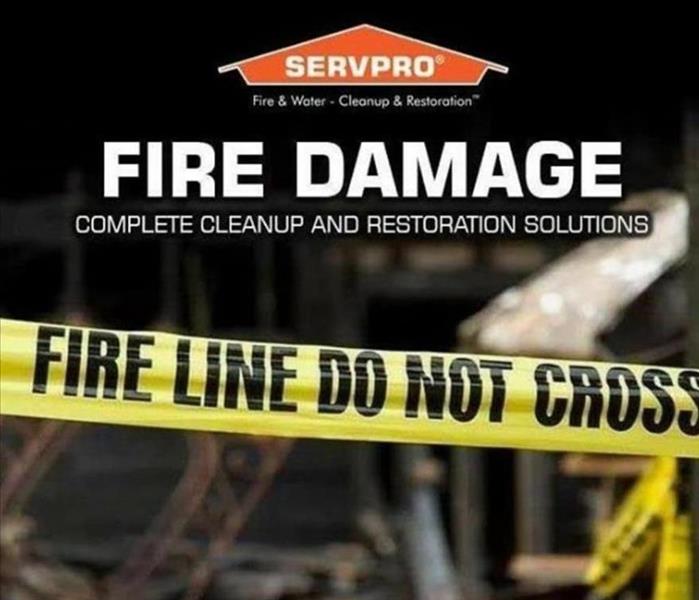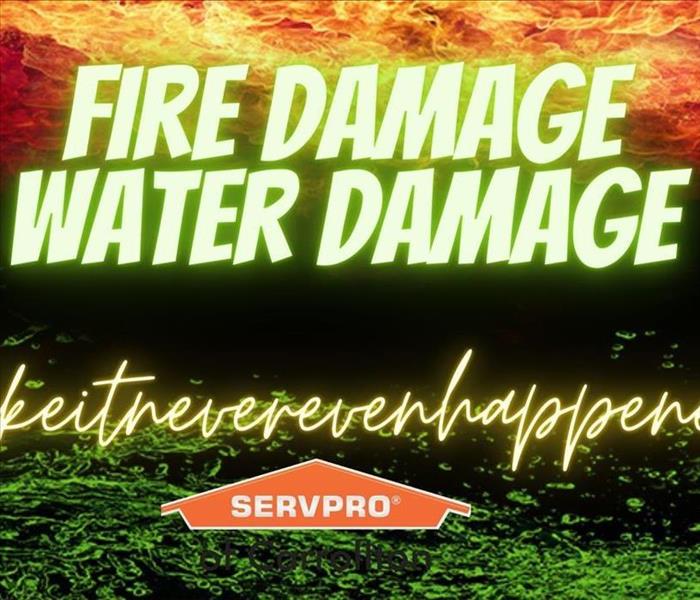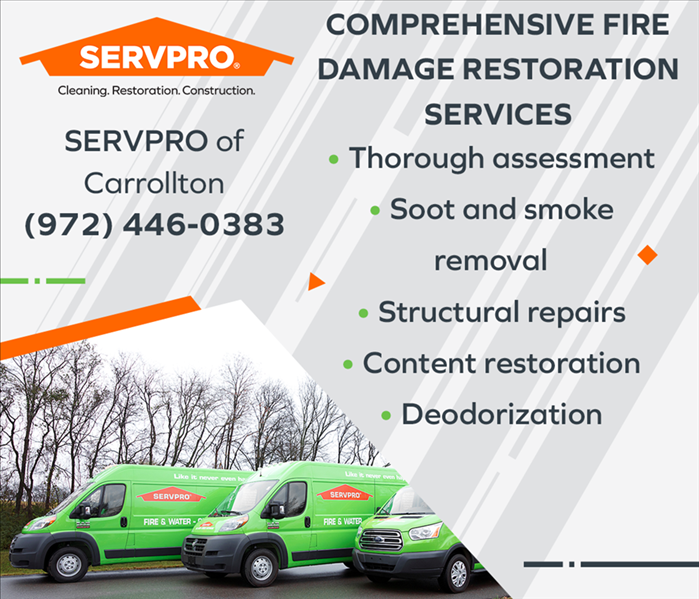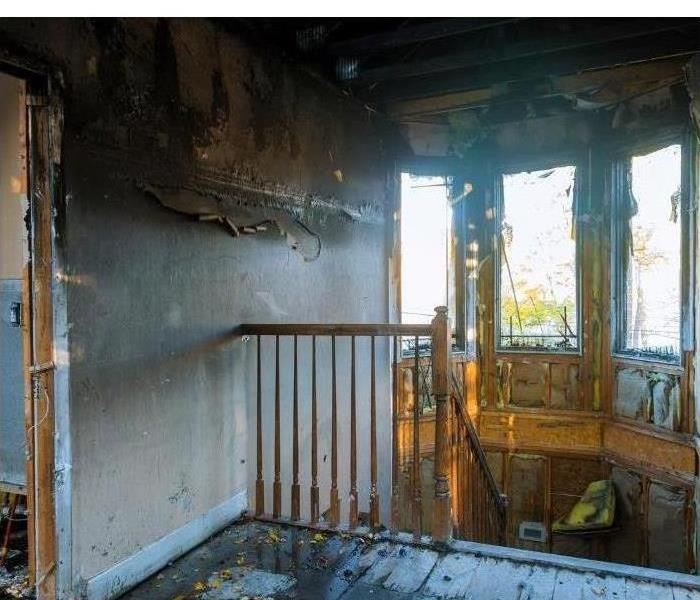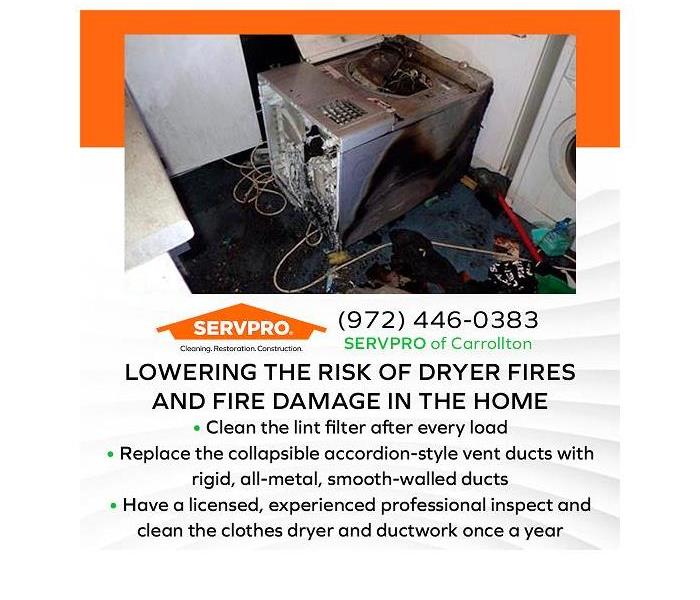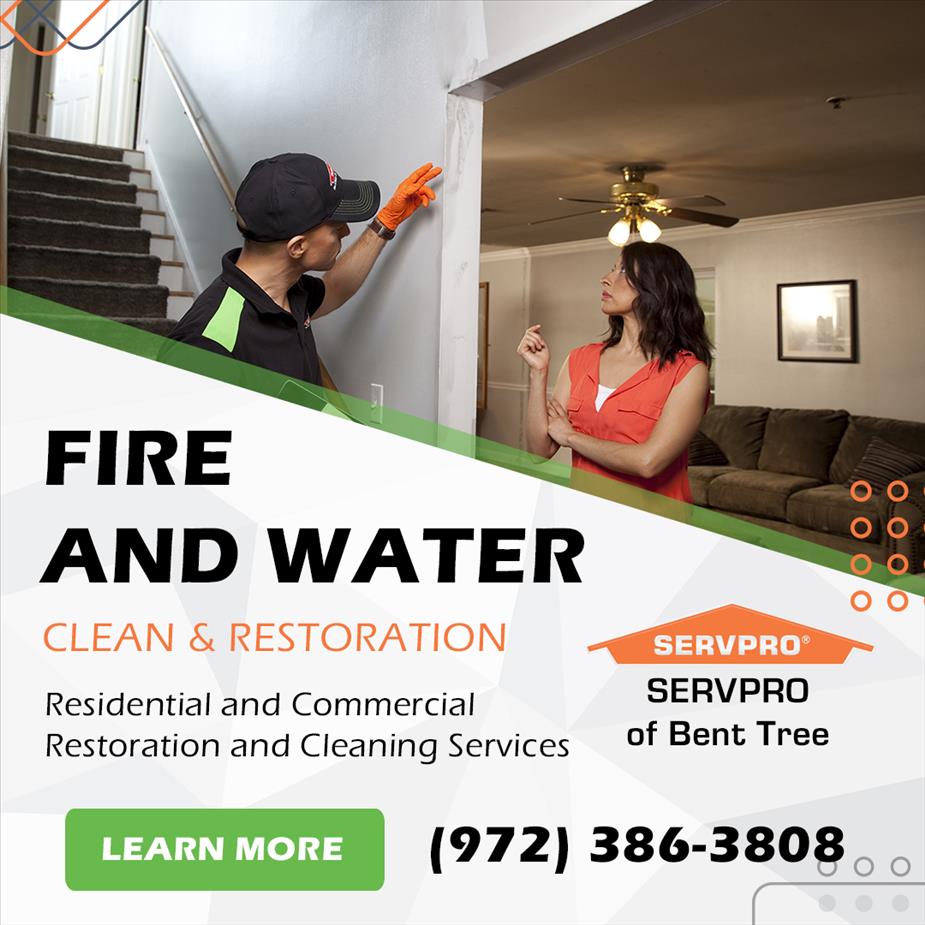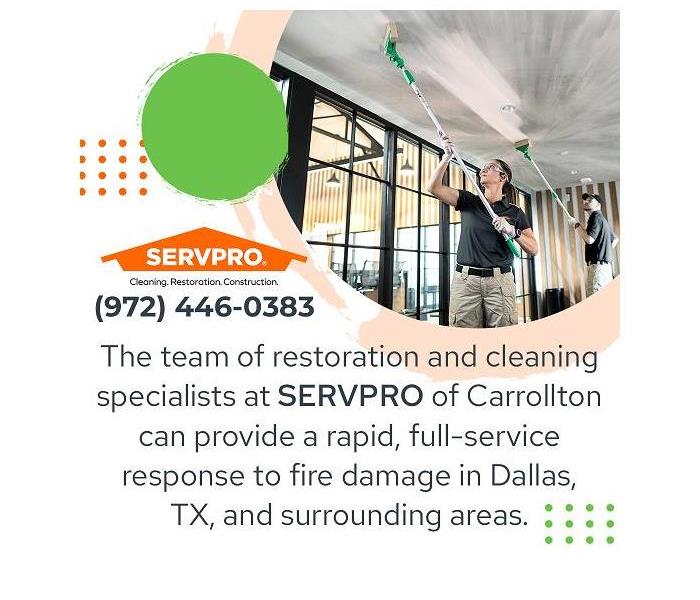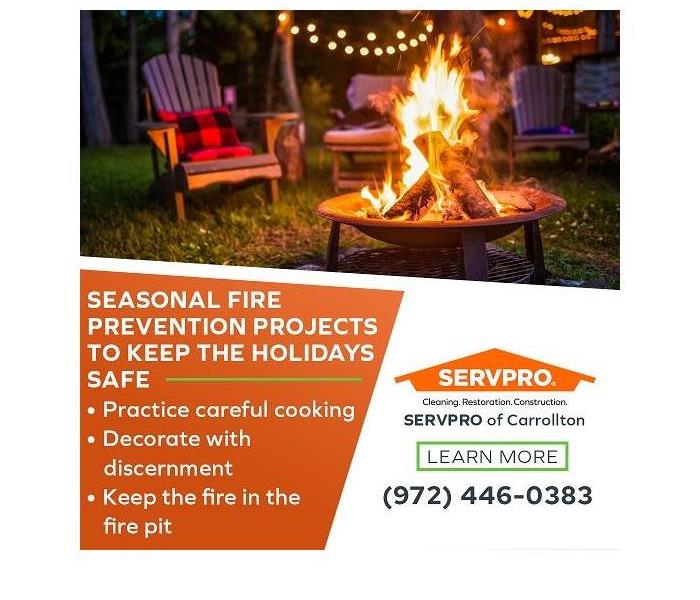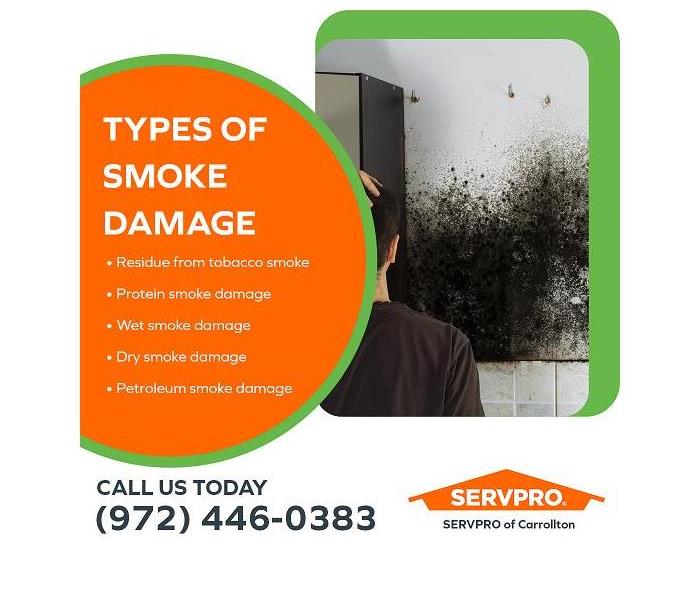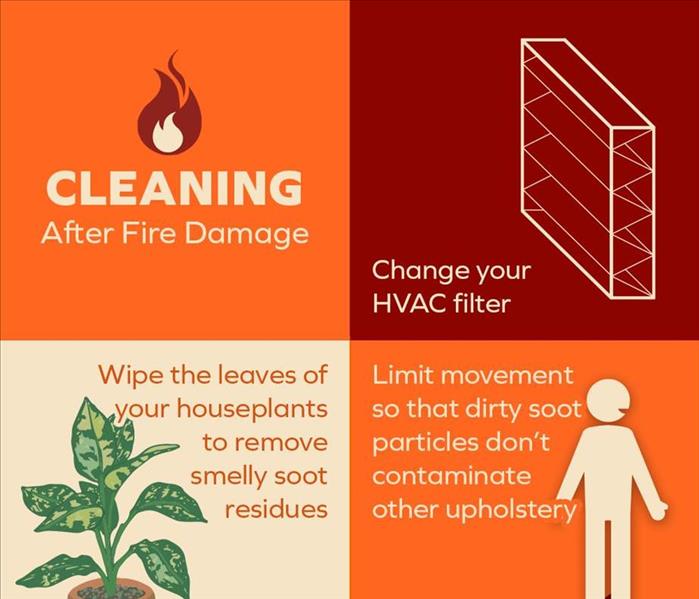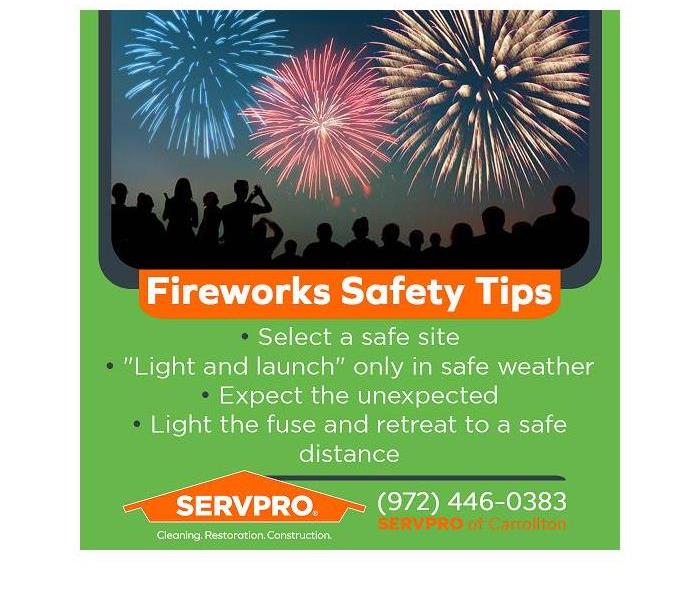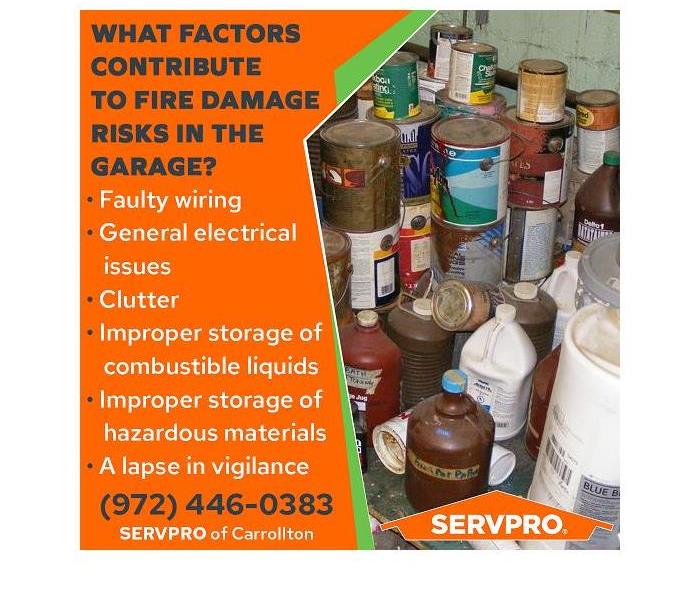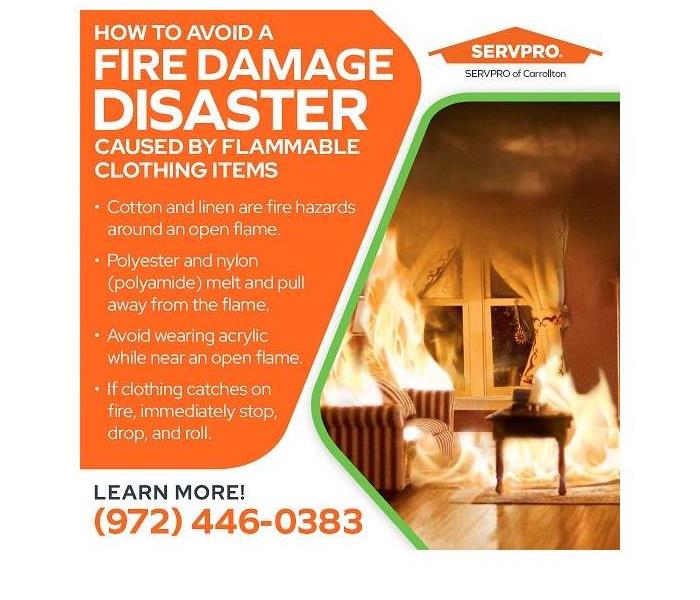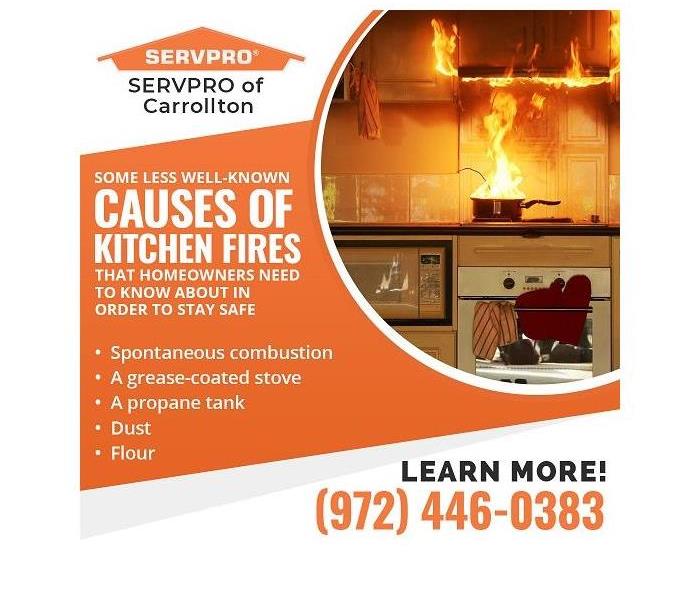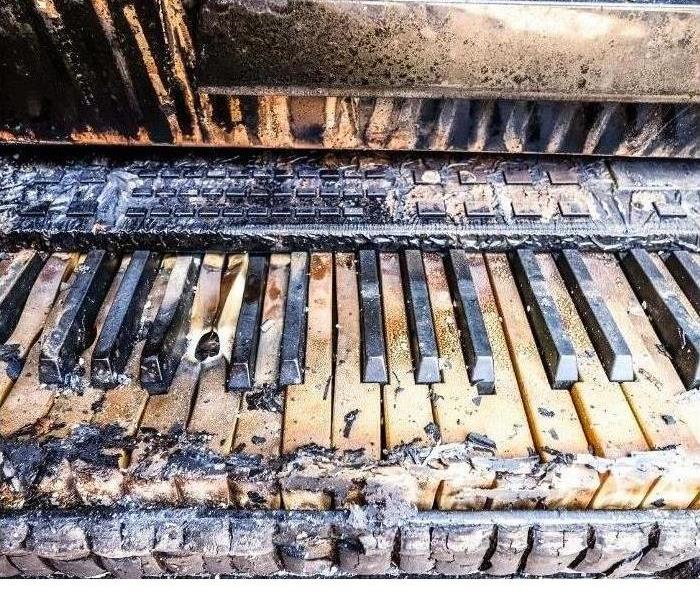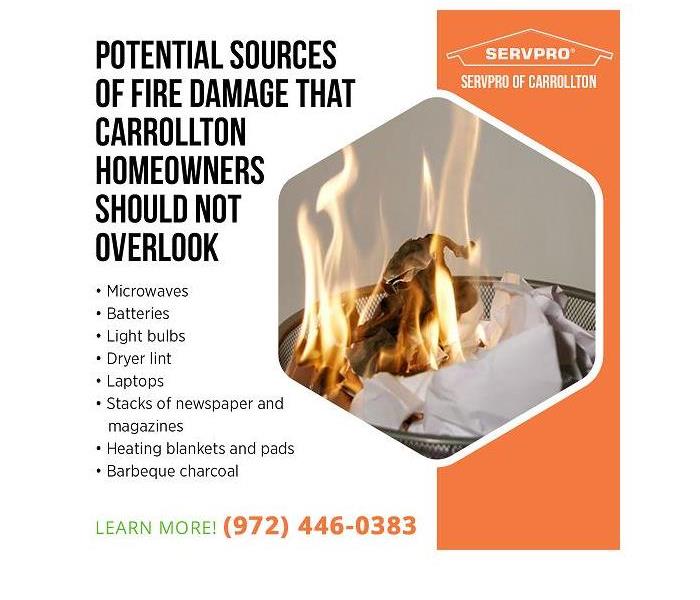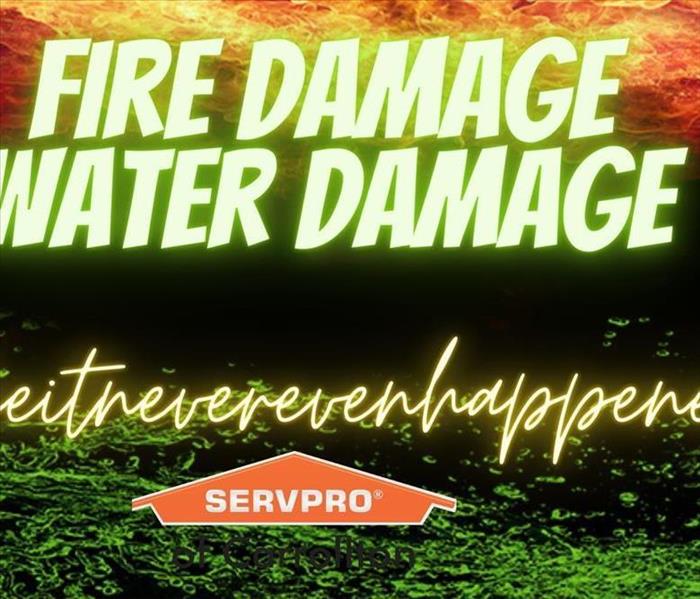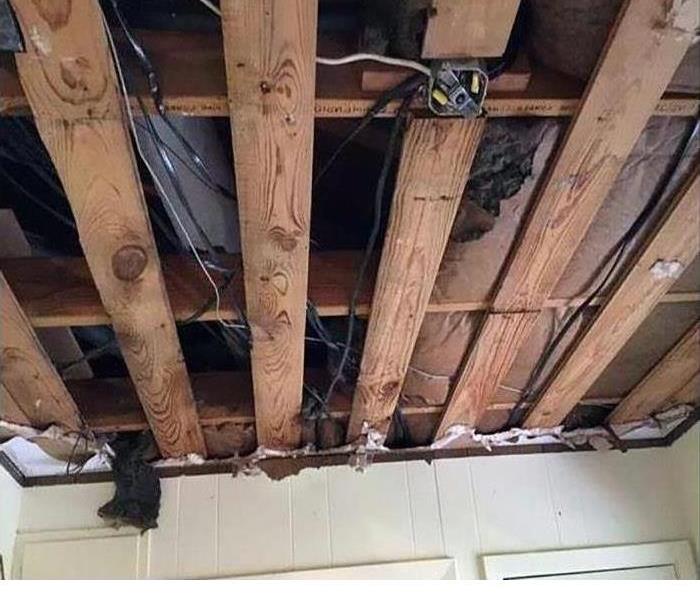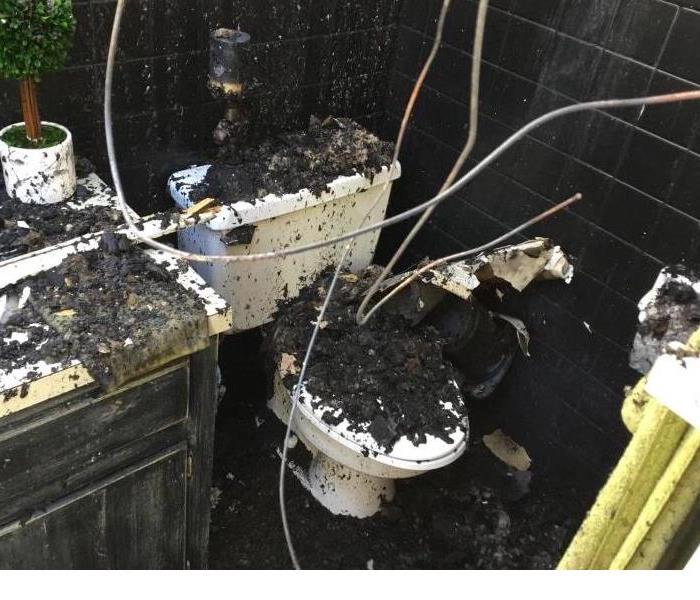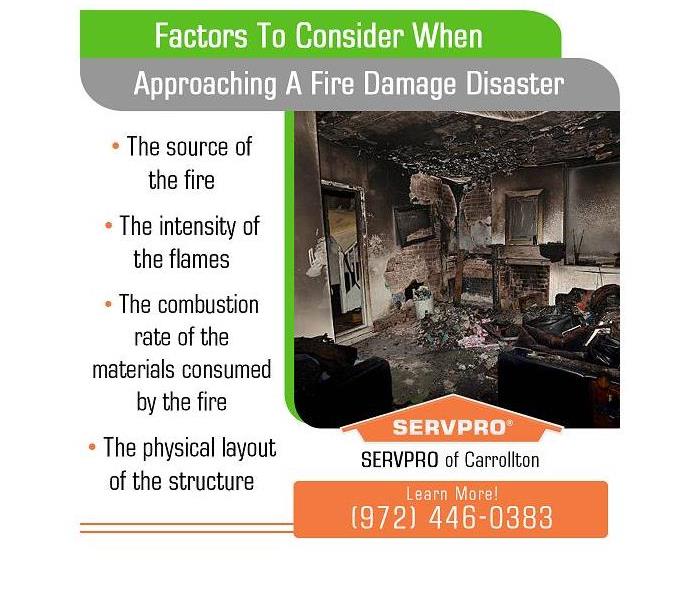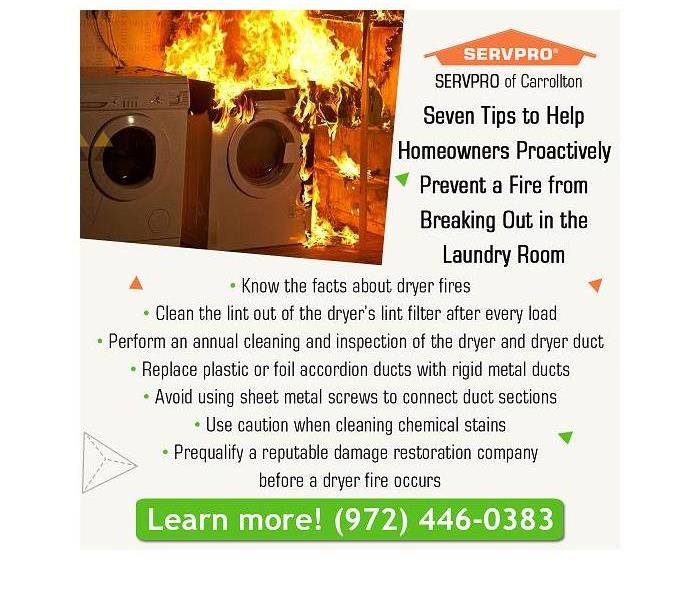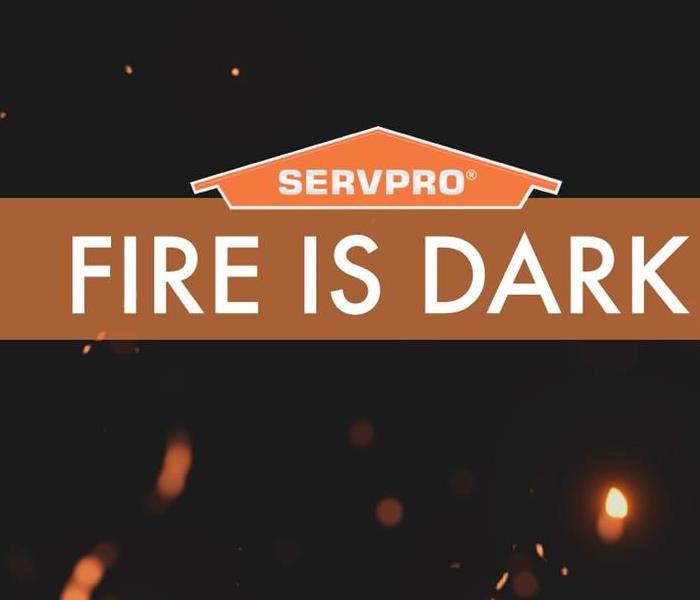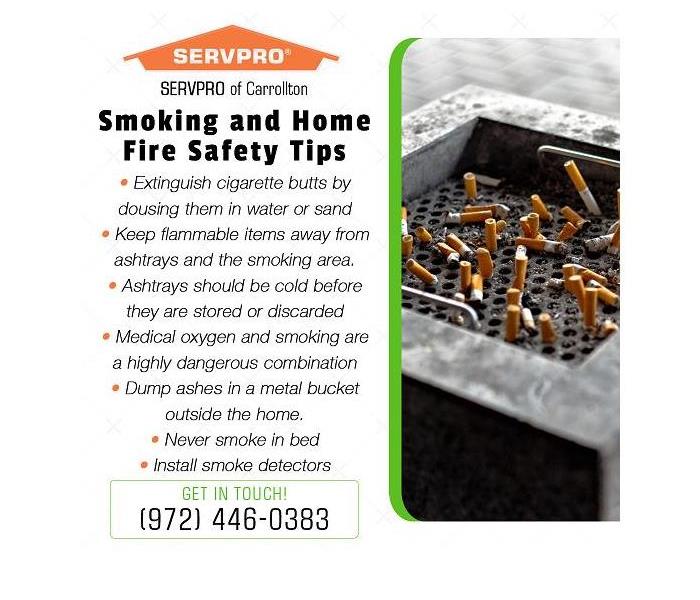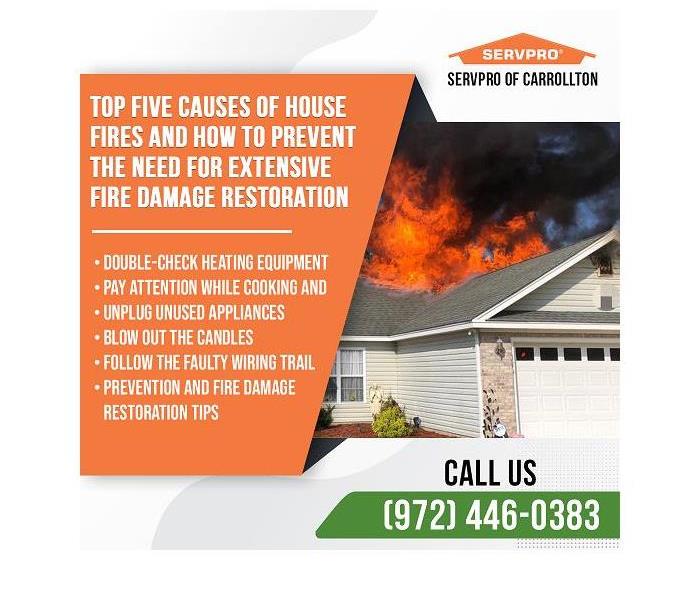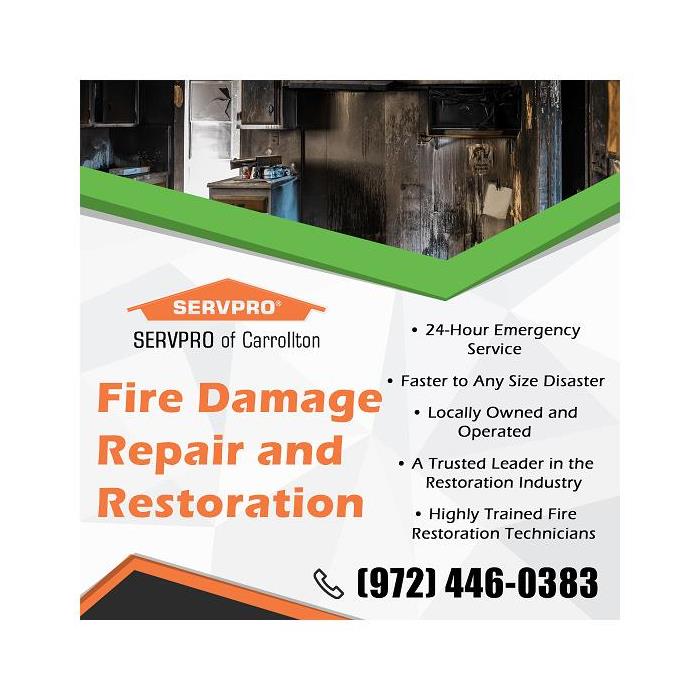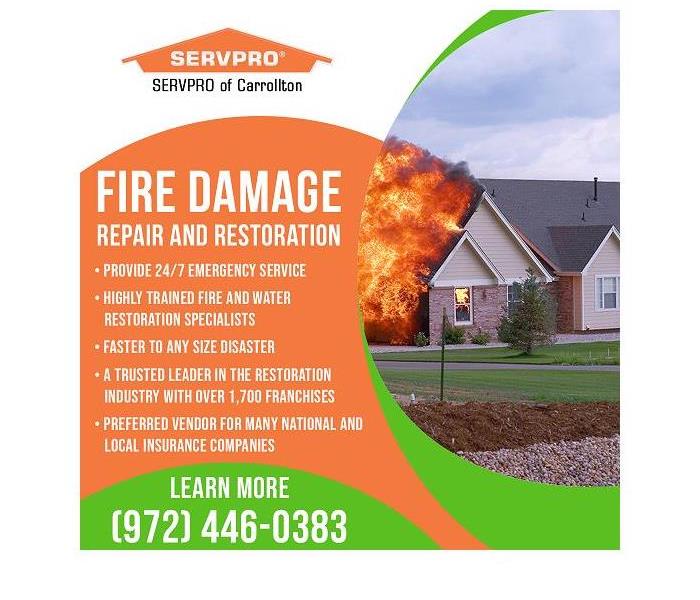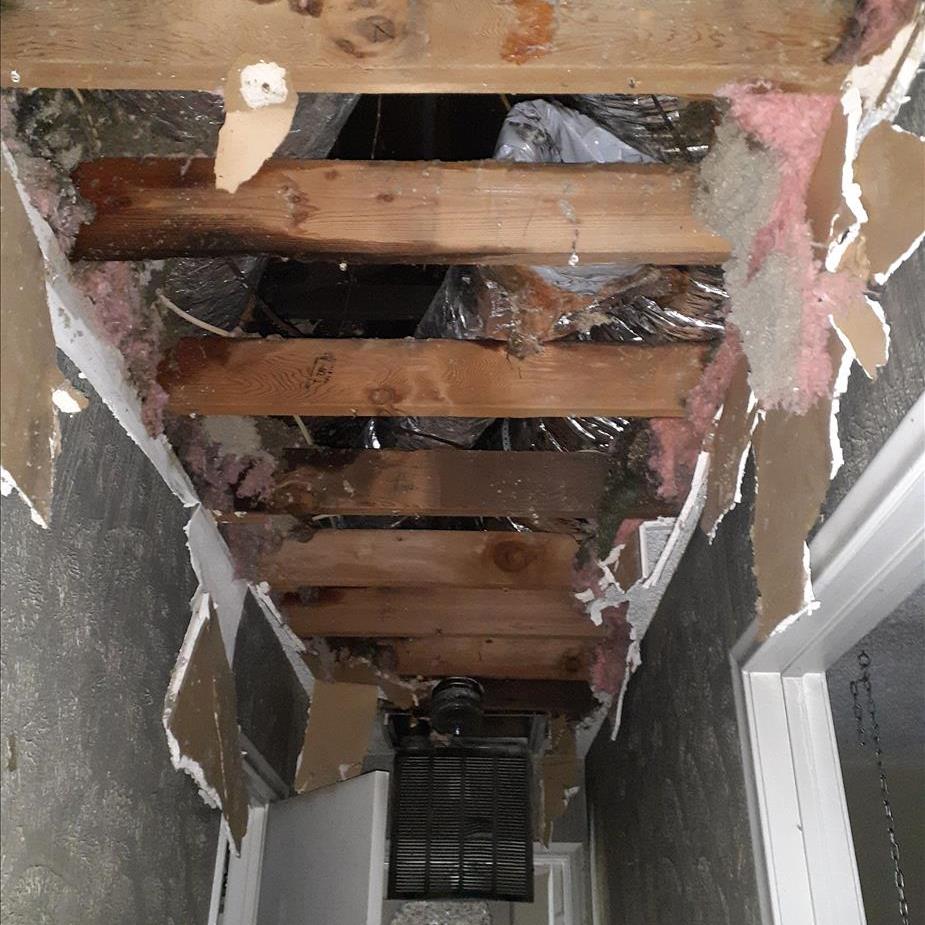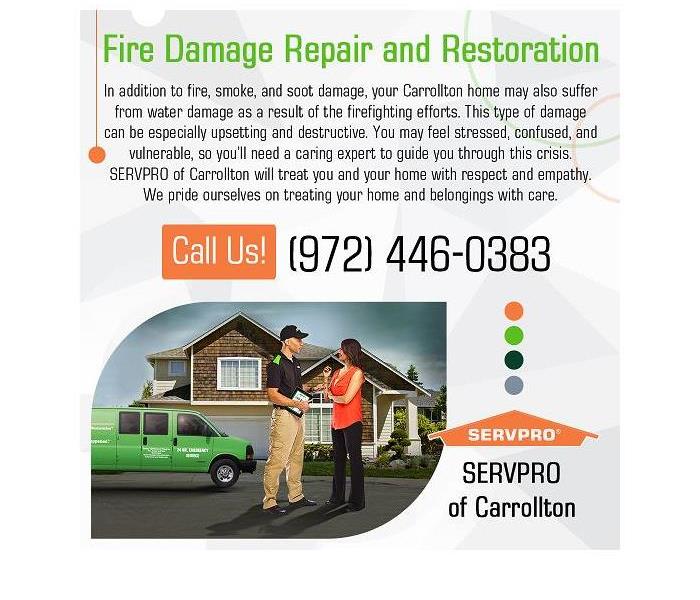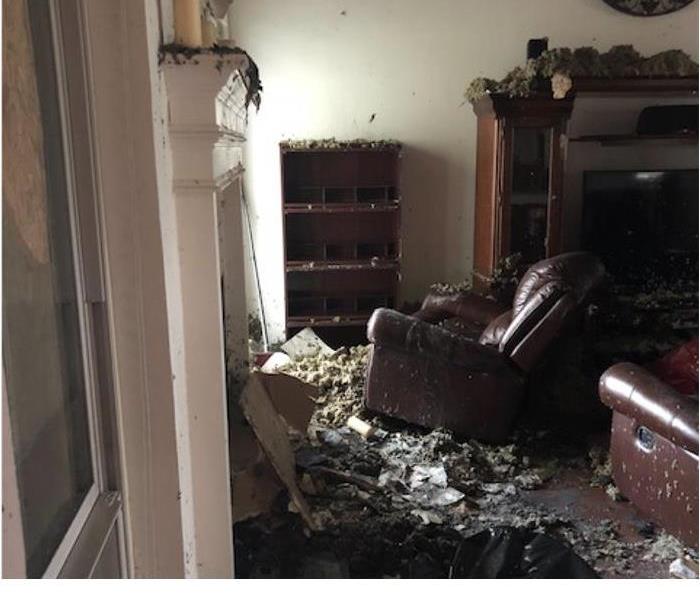Recent Fire Damage Posts
After the Fire Trucks Leave---What is next?
4/11/2024 (Permalink)
Fires are devastating events that can cause significant damage, both to property and people. In the wake of a fire, it is essential to have a reliable source of help and support, especially if you are located in Dallas. Fortunately, there are fire restoration services available in Far North Dallas and Carrollton that can help with your restoration needs. Here’s what you need to know about them.
Why Choose Fire Restoration Services?
Fire restoration services provide invaluable assistance for those affected by fires. Companies offering these services specialize in cleaning up after fires and restoring damaged property to its pre-fire condition. This is especially important for businesses who need to quickly get back up and running after a fire has taken place. Fire restoration services provide professional attention to the affected areas, so normal business operations can resume as soon as possible.
What Services Do Fire Restoration Companies Provide?
Fire restoration companies offer a variety of services designed to restore properties that have been damaged by fire or smoke. These include complete clean-ups, repairs, air quality tests, odor removal, structural repair, carpet cleaning, and more. Many of these companies also specialize in specific types of material damage such as furniture, clothing, and rugs. By hiring an experienced fire restoration service provider, you can ensure that your property will be restored effectively and efficiently with minimal disruption to your daily operations.
Professional Fire Restoration Services Can Help You Get Back On Your Feet Quickly
The professional fire restoration services offered in Carrollton will work with you every step of the way throughout the entire process of restoring your home or business. From start to finish, they will be able to assess all areas of damage, provide detailed estimates for repairs, clean up debris, repair any structural damage, and even provide assistance with filing an insurance claim if necessary. Their team of experienced professionals is dedicated to providing quality customer service while ensuring that everything is done properly and efficiently.
We work directly with most insurance providers.
When it comes to restoring your property after a fire, it's important to choose professionals who specialize in this type of service. With the right team on board, you can rest assured knowing that everything will be taken care of quickly and efficiently, so you can get back on track with minimal disruption to your life or business.
Choosing a Fire Restoration Company-
3/20/2024 (Permalink)
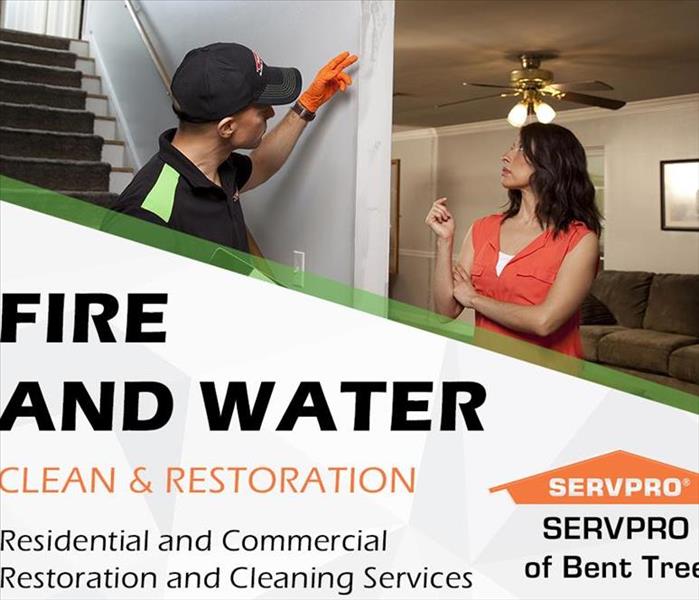 7x24x365
7x24x365
Fires are devastating events that can cause significant damage, both to property and people. In the wake of a fire, it is essential to have a reliable source of help and support, especially if you are located in Dallas. Why Choose Fire Restoration Services?
Fire restoration services provide invaluable assistance for those affected by fires. Companies offering these services specialize in cleaning up after fires and restoring damaged property to its pre-fire condition. This is especially important for businesses who need to quickly get back up and running after a fire has taken place. Fire restoration services provide professional attention to the affected areas, so normal business operations can resume as soon as possible.
What Services Do Fire Restoration Companies Provide?
Fire restoration companies offer a variety of services designed to restore properties that have been damaged by fire or smoke. These include complete clean-ups, repairs, air quality tests, odor removal, structural repair, carpet cleaning, and more. Many of these companies also specialize in specific types of material damage such as furniture, clothing, and rugs. By hiring an experienced fire restoration service provider, you can ensure that your property will be restored effectively and efficiently with minimal disruption to your daily operations.
Professional Fire Restoration Services Can Help You Get Back On Your Feet Quickly
The professional fire restoration services offered in Far North Dallas and Carrollton will work with you every step of the way throughout the entire process of restoring your home or business. From start to finish, they will be able to assess all areas of damage, provide detailed estimates for repairs, clean up debris, repair any structural damage, and even provide assistance with filing an insurance claim if necessary. Their team of experienced professionals is dedicated to providing quality customer service while ensuring that everything is done properly and efficiently.
When it comes to restoring your property after a fire, it's important to choose professionals who specialize in this type of service. With the right team on board, you can rest assured knowing that everything will be taken care of quickly and efficiently, so you can get back on track with minimal disruption to your life or business.
Is your Fireplace Ready for the Winter Weather?
12/4/2023 (Permalink)
How to Prepare Your Fireplace for Winter
Winter is coming, and with it, a significant drop in temperatures across the United States and Canada. So, what better way to warm up than to gather around the fireplace with a blanket and warm beverage? Like many household appliances, a fireplace requires maintenance and safety considerations to operate properly. So, how do you get your fireplace ready for the winter season? We’ve compiled some tips below to help ensure your fireplace is operated safely this winter.
The Importance of Preparing Your Fireplace for Winter
According to research by the National Fire Protection Association, in 2022, approximately one fifth of home fire heating equipment accidents were due to fireplaces. Not only do these accidents cause property damage, but they tend to follow a distinct seasonal pattern, with more fires occurring during the winter months than any other time. This is important, as the Environmental Protection Agency (EPA) estimates there are approximately 17.5 million fireplaces in the United States.
Even those in southern states or warmer climates should follow the below tips. Remember, if your fireplace causes property damage, SERVPRO® is Here to Help®. Technicians across North America are prepared to respond 24/7 year-round to your fire damage emergency.
Top Safety Tips for Fireplaces
The EPA and Centers for Disease Control and Prevention advise following these safety tips for burning wood in your fireplace:
- Always keep a fire extinguisher nearby and handy.
- Make sure items such as furniture, curtains, books, newspapers, and other flammable belongings are kept away from the fireplace.
- If you choose to use artificial logs, use ones made from 100 percent compressed sawdust.
- Build hot fires, as a smoldering fire is not considered safe or efficient.
- Keep the glass door or fire screen in front of the fireplace closed unless you’re loading or stoking the fire. Otherwise, chemicals such as carbon monoxide may be released into your home.
- Routinely remove ashes from the fireplace into a metal container with a cover. Remove this container from the area and store it outdoors on a non-flammable surface.
- Make sure you have a smoke detector and carbon monoxide detector installed near the fireplace.
- The CDC recommends testing them on a monthly basis and changing batteries at least twice a year.
Top Maintenance Tips for Fireplaces
Oakland Community College outlines the following maintenance tips when using your fireplace:
- Have your chimney cleaned and inspected before using the fireplace for the first time each year. An annual inspection by a licensed chimney specialist will help ensure soot and creosote that’s built up over the last year is removed. The chimney specialist can also look at the bricks to help ensure none are cracked, dislodged, or in need of replacement.
- Have the gas pilot light inspected regularly.
- Open the flue before use so the fire can vent adequately.
Fireplaces: Common Questions and Answers
You have questions, and SERVPRO has answers. Some common questions and answers about fireplace safety include the following:
- Is it safe to sleep with a fireplace on?
- What can I put in front of my fireplace for safety?
- What shouldn’t I put in my fireplace?
- According to the EPA, don’t burn the following items in your fireplace:
- Household trash, such as cardboard, plastic, foam, boxes, wrappers, and/or ink from magazines.
- Painted, coated, and/or pressure-treated wood.
- Unseasoned (wet or green) wood.
- Diseased, rotted, wet, and/or moldy wood.
- Asbestos, manure, rubber.
- Animal remains.
- Particle board, plywood, ocean driftwood, and/or wood with glue on it.
- Along these lines, remember that sawdust and wax logs are typically only used for open hearth fireplaces. Check your fireplace’s operating instructions before using artificial logs.
- Is it safe to start a fire with gasoline, kerosene, or a charcoal starter?
- No. This can be very dangerous. You should only start a fire using organic methods, with newspaper, dry kindling, or organic fire starters.
Does SERVPRO Clean After Fireplace Damage?
Yes. In fact, SERVPRO cleans after any kind of fire damage, whether from a faulty fireplace, chimney accident, fire damage in the kitchen or workplace, or more. SERVPRO franchises follow a seven-step fire restoration process to get your home or business back up and running. These steps include:
- Emergency Contact. The first step of the fire damage restoration process is the emergency contact. During this step, you will reach out to your local SERVPRO franchise to describe the issue and damages. Additionally, a specialist will ask a series of questions to determine the appropriate equipment and personnel to dispatch.
- Inspection and Fire Damage Assessment. Upon arrival, SERVPRO technicians will assess the affected area, along with adjoining rooms. This helps establish the extent of fire, smoke, and soot damage, and helps technicians develop a plan of action.
- Immediate Board-up and Roof Tarp Service. If necessary, SERVPRO technicians will implement roof tarping and board-up services to help ensure your property is protected from the elements, vandals, animals, and illegal entry. This will assist with the cleanup and restoration process, as the security of your property is just as important as getting it back up and running.
- Water Removal and Drying. If water is present, SERVPRO technicians will use extractors and dehumidifiers to begin the water removal and drying process as soon as possible.
- Removal of Smoke and Soot from All Surfaces. The fifth step involves using specific techniques and specialized equipment to remove smoke and soot from walls, ceilings, floors, and other surfaces.
- Cleaning and Sanitizing. This step involves potentially packing and relocating affected items, such as electronics, art, and other documents through restoration. If relocating is not required, salvageable items will be remediated.
- Repairs and Reconstruction. The final step of SERVPRO’s fire damage restoration process involves any last needs being serviced. This could involve minor repairs or significant reconstruction of partial or entire rooms.
For Round-the-Clock Availability, Reach out to SERVPRO
When fireplaces wreak havoc on your home or business, your local SERVPRO franchise is available 24/7 to assist with your cleanup and restoration needs. From minor fireplace damage in a single room to major losses requiring significant reconstruction services, rely on SERVPRO to get the job done and help return your property to preloss condition.
SERVPRO is available 24/7, and technicians undertake each job with elite equipment and fast response to ensure we take great care with your home.
Unveiling the hidden impact of smoke damage: Beyond the surface
10/17/2023 (Permalink)
Smoke and soot odors can linger long after a fire has been extinguished, leaving behind a pungent smell and a constant reminder of the devastation that once occurred. At SERVPRO® of Carrollton, we recognize the importance of addressing these odors comprehensively to ensure the complete restoration of your property. This blog delves deep into the smoke and soot odor removal world, providing expert advice and insights into the meticulous processes of eliminating these persistent odors.
Whether you've recently experienced a fire or are simply seeking knowledge on preparing for potential fire incidents, understanding the nuances of smoke and soot odor removal is invaluable. Our team of experts has honed their skills in this critical aspect of fire damage remediation, and we are here to share our knowledge with you. Join us as we explore the effects of smoke damage, the techniques employed in professional smoke remediation, and the importance of a holistic approach to fire restoration. Together, we'll uncover the secrets to a fresh and odor-free environment after a fire incident, making your home safer and more comfortable.
Assessing the impact of smoke damage
In the wake of a fire, assessing the extent of smoke damage is a critical first step toward a successful restoration. Smoke, often underestimated in its destructive power, can infiltrate every nook and cranny of your property, leaving a trail of damage that goes beyond what meets the eye.
Understanding the types of smoke damage
Differentiating dry smoke and wet smoke damage
Smoke damage resulting from a fire isn't a one-size-fits-all situation. It comes in different forms, with two primary categories being dry smoke damage and wet smoke damage. Recognizing these distinctions is essential because they dictate the strategies and techniques needed for effective restoration.
Dry smoke damage
Characteristics: Dry smoke damage typically occurs in high-temperature fires that burn quickly through combustible materials. The residues left behind are dry, powdery, and often gray or black.
Impact: Dry smoke residues are less sticky and more easily vacuumed, making them somewhat simpler to remove from surfaces. However, their fine particles can infiltrate hidden spaces and settle into porous materials, requiring thorough cleaning and deodorization.
Common scenarios: Dry smoke damage is often associated with materials like wood and paper. It is prevalent in fast-spreading fires where oxygen supply is ample.
Wet Smoke Damage
Characteristics: Wet smoke damage, on the other hand, results from slow-burning, low-temperature fires that consume synthetic materials like plastics and rubber. The residues left behind are sticky, smeary, and have a pungent odor.
Impact: Wet smoke residues are notorious for their ability to penetrate deep into surfaces, making them challenging to remove. Their stickiness means they adhere firmly to materials, requiring specialized cleaning agents and techniques for effective removal.
Common scenarios: Wet smoke damage is frequently found in house fires with synthetic materials. It can be particularly challenging because it can spread widely and adhere strongly to surfaces.
Recognizing whether your property has been affected by dry smoke or wet smoke damage is crucial for a successful restoration process. Restoration experts, like those at SERVPRO of Carrollton, tailor their approaches based on these distinctions. Dry smoke damage may require extensive cleaning and vacuuming, while wet smoke damage demands specialized cleaning agents and methods to effectively break down and remove the sticky residues.
Moreover, the type of smoke damage also influences the choice of deodorization techniques. Different odors emanate from dry smoke and wet smoke residues, and expert deodorization methods are employed accordingly to neutralize these odors at their source.
By understanding and differentiating between dry smoke and wet smoke damage, restoration professionals can develop precise strategies that ensure your property is thoroughly cleaned, deodorized, and restored to its pre-fire condition.
Hidden effects of smoke damage
Smoke damage is often more insidious than meets the eye. While the visible signs of soot and smoke residues are readily apparent, the hidden effects of smoke damage can continue to wreak havoc on your property long after the fire has been extinguished. Understanding these concealed consequences is crucial for a comprehensive restoration of fire damage.
- Structural damage: One of the hidden effects of smoke damage is structural deterioration. Smoke particles can infiltrate deep into building materials, such as wood and drywall, compromising their integrity. Over time, this can weaken the structure of your property, potentially leading to structural failures. Detecting and addressing this hidden damage requires the expertise of professionals who can assess and repair compromised structural components.
- Corrosion of metals: Smoke is often acidic due to chemicals and gases created during combustion. This acidity can lead to the corrosion of metal surfaces and components within your property. For instance, electrical wiring, plumbing fixtures, and appliances may suffer damage that is not immediately visible but can manifest over time, causing malfunctions and safety hazards.
- Discoloration and staining: Smoke residues can leave unsightly discoloration and stain on walls, ceilings, and other surfaces. This staining can persist even after initial cleaning attempts. Specialized cleaning agents and techniques are often required to effectively remove these hidden marks and restore the appearance of affected areas.
- Lingering odors: Perhaps one of the most persistent hidden effects of smoke damage is the lingering odor. Smoke odors can become trapped in porous materials, such as carpets, upholstery, and insulation. Over time, these odors can resurface, causing discomfort and reducing indoor air quality. Proper deodorization methods, including thermal fogging and ozone treatments, are essential to neutralize these hidden odors.
- Health hazards: Smoke damage can have long-term health consequences. Smoke particles and toxins released during a fire can become embedded in your property's materials and the surrounding environment. Prolonged exposure to these substances can lead to respiratory problems and other health issues. Ensuring thorough smoke removal and decontamination is vital for maintaining a healthy living or working space.
- Impact on HVAC systems: Smoke particles can infiltrate your HVAC system and ductwork, distributing odors and contaminants throughout your property. Neglecting to clean and deodorize these systems can lead to recontamination and perpetuation of smoke odors, making professional HVAC cleaning an essential part of comprehensive smoke damage restoration.
Addressing these hidden effects of smoke damage requires the expertise of professionals who understand the complexities of fire damage restoration. SERVPRO of Carrollton is your trusted partner in this process, ensuring that visible and concealed smoke damage consequences are meticulously addressed. Our team has the knowledge, experience, and advanced equipment to restore your property to its pre-fire condition, providing a safe and comfortable environment.
Health hazards and air quality
Smoke damage doesn't just affect your property; it can also compromise indoor air quality, posing health risks to occupants. Particles and toxins released during a fire can become trapped in your home, leading to respiratory issues and other health concerns. Addressing these air quality issues is vital to comprehensive smoke damage assessment.
As we navigate the intricacies of assessing smoke damage, our aim at SERVPRO of Carrollton is to understand the challenges you may face after a fire incident. By recognizing the full extent of the damage, you can make informed decisions about the restoration process and ensure that no residual odors or health risks linger on your property. In the following sections, we will explore the expert techniques employed in smoke remediation to help you reclaim a fresh and safe living space.
The expert approach to smoke remediation
Smoke remediation is a specialized field that demands skill and precision when restoring a property after a fire. At SERVPRO of Carrollton, we take pride in our expertise and unwavering commitment to providing professional smoke remediation services that go above and beyond to restore your property to its pre-fire condition.
Effective smoke removal methods
Specialized techniques for smoke removal
Our expert approach to smoke remediation involves a multifaceted strategy. We employ specialized techniques to eliminate smoke residues from every surface and crevice. High-efficiency particulate air (HEPA) vacuuming captures and removes fine particles from the air and surfaces. Thermal fogging is another technique, as it dispenses a fine mist of deodorizing agents to neutralize smoke odors in even the most hard-to-reach areas.
Comprehensive cleaning and surface restoration
Our expert team has the knowledge and tools to clean and restore various surfaces affected by smoke damage. From walls and ceilings to furniture and personal belongings, we use appropriate cleaning agents and methods to ensure that smoke residues are effectively removed without causing further damage to materials.
HVAC and ductwork cleaning
Smoke can infiltrate your HVAC system and ductwork, circulating odors throughout your property. Our smoke remediation experts thoroughly clean and deodorize these systems to prevent the recontamination of your indoor air.
Ozone and hydroxyl generators
For particularly stubborn smoke odors, we utilize ozone and hydroxyl generators. These machines produce molecules that interact with and neutralize odor-causing particles, leaving your property smelling fresh and clean.
Collaboration with experts
We may collaborate with industrial hygienists to ensure air quality meets safety standards in severe smoke damage. This collaborative effort underscores our commitment to delivering the highest level of service.
Our expert approach to smoke remediation extends beyond removing visible residues and odors. We take into account the unique characteristics of your property and the specific type of smoke damage encountered. By employing proven techniques and state-of-the-art equipment, SERVPRO of Carrollton ensures that every aspect of smoke remediation is meticulously addressed, leaving your property restored properly.
Conquering lingering soot odors
Soot, a byproduct of incomplete combustion during a fire, leaves visible marks and can generate persistent and unpleasant odors. Conquering these lingering soot odors is a crucial aspect of the fire damage remediation process, requiring specialized expertise and techniques.
The composition and challenge of soot residues
Soot consists of fine black particles, primarily carbon, that can adhere to various porous and non-porous surfaces. These particles carry the distinct smell of burnt materials, which can permeate fabrics, walls, and even structural components. The challenge in soot odor removal lies in addressing both the visible soot and the deeply embedded odors.
Thorough cleaning and removal
The initial step in conquering lingering soot odors is thoroughly cleaning and removing visible soot residues. Our skilled technicians utilize specialized cleaning agents and techniques tailored to different materials to ensure that all traces of soot are eliminated.
Advanced deodorization methods
To tackle soot odors effectively, we employ advanced deodorization methods. Thermal fogging is one such technique, where a fine mist of deodorizing agents is dispersed throughout the affected area, neutralizing odors at the molecular level. Ozone and hydroxyl generators also come into play, producing molecules that react with and neutralize odor-causing particles.
HVAC and ductwork inspection and cleaning
Soot can infiltrate your HVAC system and ductwork, making it essential to thoroughly inspect and clean these components. Neglecting this step can result in the recontamination of your indoor air, perpetuating the presence of soot odors.
Customized solutions
Our approach to soot odor removal is never one-size-fits-all. We customize our techniques and solutions based on the specific type of soot, the materials involved, and the extent of the damage. This tailored approach ensures that no lingering soot odors persist on your property.
Complete restoration for peace of mind
Conquering lingering soot odors is not just about eliminating smells; it's about restoring your property to cleanliness and comfort. At SERVPRO of Carrollton, our experts are dedicated to achieving comprehensive restoration that leaves no room for residual odors or hidden soot damage.
By addressing the visible and invisible aspects of soot damage and employing specialized techniques for soot odor removal, we ensure that your property is not only odor-free but also fully restored to its pre-fire condition, providing you with the peace of mind you deserve.
Beyond smoke and soot: Complete fire restoration
While addressing smoke and soot damage is vital to fire restoration, a complete fire restoration process goes far beyond these elements. At SERVPRO of Carrollton, we understand the holistic approach needed to restore your property to its pre-fire condition and ensure it's safe, secure, and comfortable once more.
How smoke remediation fits into the bigger picture
Smoke remediation is an integral part of the broader fire damage restoration process. Effectively removing smoke residues and odors lays the foundation for a successful restoration. Smoke remediation ensures that your property is free from lingering odors and any potential health hazards caused by smoke particles.
Structural repairs and reconstruction
Fire often results in structural damage to properties, compromising their integrity and safety. Our expert team is equipped to handle structural repairs and, if necessary, reconstruction. We ensure that your property is aesthetically restored and structurally sound.
Preserving what matters: content restoration
Your belongings, furniture, and cherished items are not forgotten during restoration. We provide content restoration services to salvage and restore as many of your possessions as possible. This includes cleaning, deodorizing, and repairing items affected by fire and smoke damage.
Emotional support and guidance
Experiencing a fire can be emotionally distressing. Beyond the physical restoration, we offer emotional support and guidance. We understand the sentimental value of your belongings and strive to minimize the emotional toll the incident may have taken.
Efficient insurance claims assistance.
Navigating insurance claims after a fire can be complex. SERVPRO of Carrollton assists you in streamlining this process, helping you understand the paperwork and documentation required for a smoother claims experience.
The role of prevention in comprehensive restoration
Complete fire restoration also involves educating you on fire safety and prevention. We provide information and resources to help you safeguard your property against future fire incidents.
Our commitment to comprehensive fire restoration services encompasses all aspects of the recovery process. From addressing structural damage to preserving your personal belongings and offering emotional support, SERVPRO of Carrollton is your trusted partner in ensuring that your property is fully restored and that you have the knowledge and resources to prevent future fire emergencies.
Preventing smoke and fire damage: Essential fire safety tips
Prevention is often the most effective strategy for fire and smoke damage. Taking proactive measures and adhering to essential fire safety tips can significantly reduce the risk of a fire incident in your home or business. Here, we delve into key recommendations that will help you safeguard your property and loved ones from the devastating effects of fires.
Creating a fire safety plan for your home
The foundation of fire safety: A well-defined plan
A fire safety plan is the cornerstone of preventing fire damage. Start by outlining escape routes and emergency exits within your home. Ensure that everyone in your household knows these routes, and conduct regular fire drills to practice safe evacuation.
Installing smoke detectors
Early warning systems: The role of smoke detectors
Smoke detectors are your first line of defense against fire and smoke damage. Install smoke detectors in key areas of your home or business, such as bedrooms, hallways, and near the kitchen. Test them regularly and replace batteries as needed to ensure they function correctly.
Storing flammable materials safely
Flammable materials, including chemicals, gasoline, and propane tanks, should be stored securely and away from heat sources. Follow manufacturer recommendations for storage and disposal to minimize fire hazards.
Cooking with caution: Fire safety in the kitchen
The kitchen is a common source of fire incidents. Never leave cooking unattended; keep flammable items, like dish towels, away from stovetops. Install a fire extinguisher in the kitchen and know how to use it.
Preventing electrical fires
Regularly inspect your electrical systems, such as frayed cords or exposed wires, for wear or damage. Avoid overloading outlets and use surge protectors to safeguard your electronics.
Tools for fire safety: Fire extinguishers and blankets
Consider having fire extinguishers and blankets readily available in your home or business. Learn how to use them and ensure they are up-to-date and properly maintained.
Knowledge is power: Fire safety education
Educate your family or employees about fire safety procedures and emergency protocols. Ensure that everyone knows how to call for help and knows the location of emergency exits and meeting points.
Preventive maintenance for fire safety
Schedule regular property inspections, including heating systems, chimneys, and electrical wiring. Address any potential issues promptly to reduce the risk of fire incidents.
Maintaining fire safety equipment
Ensure that fire safety equipment, such as fire extinguishers and smoke detectors, is in good working order. Replace batteries and conduct tests as recommended by manufacturers.
By implementing these essential fire safety tips, you can significantly minimize the risk of fire and smoke damage to your property. Prevention is the key to safeguarding your home or business and ensuring the safety of your loved ones or employees.
Choose SERVPRO of Carrollton for expert smoke removal.
When disaster strikes and your property is engulfed in smoke and soot, you need more than just a quick fix; you need expert smoke removal services that leave your space pristine, safe, and odor-free. SERVPRO of Carrollton is your trusted partner in smoke removal, offering comprehensive solutions that go above and beyond to restore your property to its pre-fire condition.
Expertise that sets us apart
SERVPRO of Carrollton is not just another cleaning service; we are a team of highly trained professionals who specialize in smoke removal and fire damage restoration. Our experts understand the unique challenges of smoke and soot residues, and we have the knowledge and equipment to address them effectively.
Comprehensive smoke removal
We know that smoke damage goes beyond what meets the eye. Smoke particles can infiltrate hidden spaces, HVAC systems, and structural components. Our comprehensive smoke removal process includes thoroughly cleaning all affected areas and specialized techniques for deodorization.
Advanced techniques and equipment
At SERVPRO of Carrollton, we don't rely on standard cleaning methods alone. We utilize advanced techniques such as thermal fogging, which disperses deodorizing agents to neutralize smoke odors even in hard-to-reach areas. Our ozone and hydroxyl generators also produce molecules that react with and eliminate odor-causing particles.
Protection of your belongings
We understand the sentimental value of your belongings. Our content restoration services aim to salvage and restore as many of your possessions as possible. We carefully clean, deodorize, and repair items affected by smoke damage, offering you peace of mind during the restoration process.
Holistic approach to restoration
Smoke removal is just one piece of the puzzle. SERVPRO of Carrollton takes a holistic approach to fire damage restoration, addressing not only smoke and soot but also structural repairs, content restoration, emotional support, and efficient insurance claims assistance.
Emotional support when you need it most
Experiencing a fire can be emotionally distressing. Beyond the physical restoration, we offer emotional support and guidance. Our team understands your challenges and is here to minimize the emotional toll the incident may have taken.
Your trusted partner in smoke removal
When you choose SERVPRO of Carrollton for expert smoke removal, you select a team dedicated to achieving more than surface-level cleaning. We are committed to providing a fresh and safe living or working environment. We work tirelessly to ensure no lingering odors or hidden smoke damage remains on your property.
Don't settle for less when it comes to smoke removal. Trust the experts at SERVPRO of Carrollton to restore your property to its pre-fire condition, leaving it odor-free and safe for your family or employees. Contact us today at (972) 446-0383 for top-tier smoke removal services and experience the SERVPRO difference.
Professionals that are here to assist in the aftermath of a house fire.
9/8/2023 (Permalink)
Experiencing a fire in your home is devastating. Dealing with the aftermath can sometimes be even more traumatizing, from the restoration of materials to the removal of soot that seems to attach to every surface.
Even when the flames are out, leaving considerable damage, there now permeates an odor throughout your home you’re certain you’ll never get out of. You need to get professional help with odors caused by fire damage When your home becomes inundated with these odors, it’s time to call SERVPRO of Carrollton and Far North Dallas.
Odors linger long after the fire is out
Once your home sustains fire damage, the smell of smoke can linger indefinitely. While these odors slightly improve when the air becomes drier or when the temperature decreases, they never truly disappear without professional intervention. Try as you may use air fresheners, the odor won’t go away because the cause of the odor has permeated into the materials of your home.
Structural mitigation and restoration do little to alleviate an odor problem. Odors from soot particles left behind by burning plastics and other synthetics can make food taste bad, your clothing smell, and even cause health effects in some individuals.
SERVPRO's Odor Control Technician (OCT) can help eliminate the odors you’re experiencing and do it quickly. The sooner you get a professional in to deal with the unwanted odors, the sooner they can be eliminated.
Next steps after fire restoration
Through our fire damage mitigation efforts, we eliminate most of the smoke residue in your home. Keep in mind that soot could have found its way inside and into adjacent areas which in turn traps odors. Areas behind cabinets, above ceilings, and inside walls hide soot particles as well, but our professionals know how to seek these areas out and get to the root of the odors.
The science of eliminating odors can be challenging, so it’s best to leave the restoration and odor remediation to experts. SERVPRO uses a technique to get to these particles wherever they might hide. Instead of removing them manually, thermal fogging eliminates odor’s ability to return to your home's air. The forced mist spreads out in the same way the smoke did and chemically bonds with any loose soot particles. The added weight makes it impossible for the soot to get lifted back into the air currents that travel through your home, thus eliminating the potential of odors arising again in the future.
Other areas that might hold onto odors include carpeting and drapes. While soot can remain trapped here and thermal fogging might not reach all the residue hiding in the backing and pad underneath carpeting, our technicians can still treat the area with potent liquid deodorizers. We can infuse these directly into the absorbent padding.
Other areas that continue to harbor odor sources often respond well to hidden gel packs, of which we have several different scents. These also last a significant amount of time. Our technicians have an arsenal of options to address odor issues!
Proper training in odor removal
We have the training and equipment to identify and eliminate offensive odors. By identifying the cause of the odor, and determining the conditions where it contacts surfaces, the odor can often be removed over time without a trace.
Our technicians have access to several odor removal products capable of penetrating surfaces to neutralize an unpleasant odor thoroughly.
Call SERVPRO of Carrollton at 972-446-0383to make sure that every aspect of your home's fire damage mitigation, including the elimination of odors, is handled professionally and by skilled specialists. We are here to help!
Necessary Steps to Mitigate Fire Damage
6/5/2023 (Permalink)
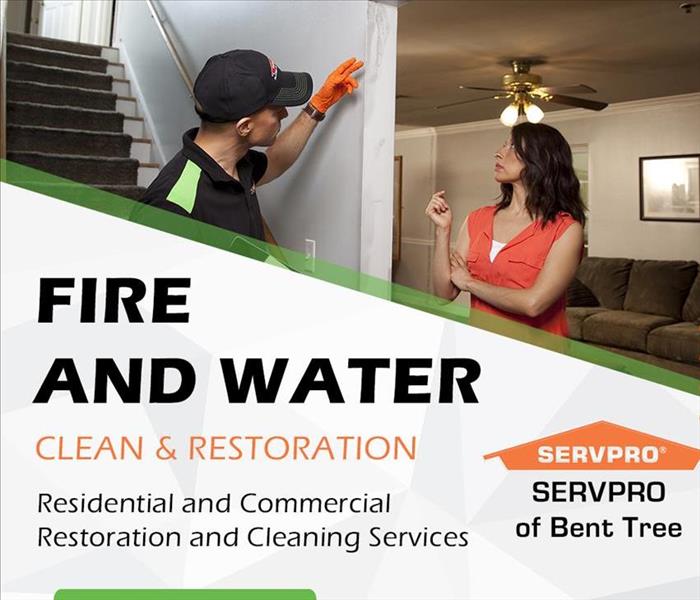 7x24x365
7x24x365
Since each smoke and fire damage situation is a little different, each one requires a unique solution tailored for the specific conditions.
When various materials burn, the soot and residue they create differs greatly and requires a specific cleaning procedure. The steps listed below illustrate our process for the “typical” fire damage restoration. Learn more about our fire damage restoration process.
- Emergency Contact
- Inspection and Fire Damage Assessment
- Immediate Board-Up and Roof Tarp Service (if needed)
- Water Removal and Drying (if water damage is present)
- Removal of Smoke and Soot from All Surfaces
- Cleaning and Repair
- Restoration
How to reduce the fire damage risk associated with the use of a clothes dryer
3/9/2023 (Permalink)
Blog Summary: SERVPRO of Carrollton advises Carrollton, TX, homeowners on ways to reduce the risk of a dryer fire in the home.
The fire damage, smoke damage, and water damage restoration specialists at SERVPRO® of Carrollton offer this helpful advice on ways to lower the risk of dryer fires and fire damage in homes.
The first electric clothes dryer was patented in 1937. There are an estimated 89 million of these amazing, time-saving appliances in US homes. Most units are electric (75%), and the remainder (25%) is gas. Temperatures reach between 125 degrees Fahrenheit and 135 degrees Fahrenheit.
The National Fire Protection Association reported the following statistic on clothes dryer fires in the United States: “In 2014-2018, local fire departments responded to an estimated average of 13,820 home structure fires per year in which dryers were involved in the ignition. These fires caused an average of seven civilian deaths, 344 civilian injuries, and $233 million in direct property damage annually… One-third (32%) of dryer fires were caused by a failure to clean. This appears to be mainly lint build-up, as 27% of dryer fires started when dust, fiber or lint ignited.”
When given proper care and maintenance, these appliances operate efficiently and safely for anywhere from 10 to 13 years, depending on the frequency of usage per week. The typical family does about 7.4 loads of laundry per week, or about 5,200 loads over the course of 13 years, the maximum estimated lifespan of a residential clothes dryer.
Given that an estimated 266 clothes dryer fires are reported each week in the United States, fire prevention tips can help homeowners safely operate this appliance.
Tip #1. Clean the lint filter after every load
Some homeowners clean the dryer lint filter once a week or once a month, allowing the lint to build up and restrict airflow through the appliance. An enormous amount of lint can accumulate in the filter after only a single cycle when drying towels, diapers, or other lint-generating fabrics. Lint build-up creates a fire hazard and reduces the drying efficiency of the appliance due to the restricted airflow.
It literally pays to clean the lint filter after every cycle. The wet clothes dry faster. The stress on the appliance is reduced, adding to its longevity. The potential for fire decreases with the decrease in the amount of lint in the filter. Since the clothes dryer reaches temperatures of 135 degrees Fahrenheit, excessive strain on the system can elevate the operating temperature to dangerously high levels.
Some dryers have alerts to warn the homeowner that lint build-up adversely affects the appliance's performance. Some vent sensors are sensitive enough to detect partial blockages, while other detection systems only send an alert when the system experiences a total blockage. The more sensitive alert technology is superior, but not all appliances have this feature.
The best and safest practice is to check and clean the lint filter after every cycle. This habit ensures peak performance and safe operation of the appliance at all times.
Tip #2. Replace the collapsible accordion-style vent ducts with rigid, all-metal, smooth-walled ducts
Unlike the accordion-style ducts, which can droop and collect lint, the metal ducts allow air and lint to pass through the pipe with little or no resistance. If a metal duct system is installed, check for sheet metal screws that can snag lint, causing an eventual build-up. Use metal clamps or foil tape to connect sections of the ducts to ensure a tight seal and a smooth trip through the duct to the outside of the home.
Tip #3. Have a licensed, experienced professional inspect and clean the clothes dryer, and ductwork once a year
If drying time takes longer than usual, the culprit may be a blockage in the dryer vent system. A quick check of the outside vent should find warm air freely streaming from the vent. A thorough cleaning of the clothes dryer and vent system can be handled by a licensed professional, bringing peace of mind and a clean, efficient, and safe clothes dryer.
Bonus tip: Be very careful drying clothes that have been exposed to flammable liquids such as kerosene, diesel, gasoline, cleaning solvents, cooking oil, or other flammable chemicals. Wash contaminated clothing through two wash cycles. If weather permits, hang the clothing outside to dry. If the items must be run through the clothes dryer, set the appliance at the lowest heat setting for maximum safety.
For a fire, smoke, and water damage disaster caused by a clothes dryer clogged with lint, contact the professionals at SERVPRO of Carrollton. IICRC-certified technicians arrive at the client’s home in about an hour to begin the fire and water damage cleanup and restoration process. The rapid response and quick cleanup help return life to normal as soon as possible in Far North Dallas properties affected by fire damage disasters.
To learn more about water damage restoration in Carrollton, TX, call SERVPRO of Carrollton at (972) 446-0383 or email office@SERVPRO10952.com.
Seek Professional Services after a Fire in your Home or Business.
11/30/2022 (Permalink)
It’s always a good idea to know the right steps to take if your property suffers a fire damage incident. Distinct types of fires require different restoration measures, and as a result, it’s smart to contact licensed service providers to mitigate further damage from occurring and get the damage completely addressed.
Remediation professionals who are IICRC certified and use relevant tools and procedures to restore your contents are the best way to ensure the job is done right.
Types of fire damage dictate cleaning approach
There are different levels of fire damages that any home is likely to experience – minimal, substantial, and major fire damage. Each level is associated with varying amounts of soot or smoke residues, how many areas were impacted, and the severity of the fire disaster itself. While wet or dry cleaning can be enough to restore minor fire damages, extensive procedures may be required when restoring specific fire disasters.
SERVPRO technicians inspect your home to determine the extent of the damage before conducting appropriate restoration procedures. Technicians will also take into consideration what kinds of materials burned, such as plastics, wood, etc. to determine the best course of action.
Our process for fire remediation
Cleaning is one of the procedures that may be recommended if the fire did not result in a complete loss of property. Before this procedure can start, it is essential to know the kind of residues, the surface they are resting on, and how to find, remove and dispose of them. After pretesting and inspecting the residues, a technician can choose the right restoration method to use and will advise the homeowners of their approach.
After our SERVPRO technicians have identified the residues, they remove them using specialized techniques such as vacuuming and dissolving. When a fire burns, it gives off smoke residues that attach to the surrounding surfaces. When these residues, also known as soot, are loosely attached to an area, removing them using vacuuming may be an option. Before performing vacuuming, our qualified technicians always ensure the area is dry to get the best results possible and prevent further damage.
When the residues are firmly attached to the surface, such as a stickier residue, dissolving them may be necessary to get the best results. SERVPRO technicians use cleaning products to dissolve the particles and then flush, rinse and dry the area once it is clean. After the cleaning process, we follow the local requirements to dispose of the particles appropriately.
Contact SERVPRO for fire damage cleanup
SERVPRO of Carrollton has extensive experience in fire damage disasters. With a team of experienced, trained professionals, we can address every phase of fire recovery for your home.
Call us at (972) 446-0383, 24/7 to get the help you need in cleaning your home after you have experienced a fire.
Rare but Real Causes of Fires.
11/18/2022 (Permalink)
Did you know that accumulated lint in your dryer vent can cause a fire?
How about a phone battery or old dishwasher?
How about non-dairy coffee creamer?
True Story.
Here are a few rare but real fire-starters to be aware of:
1 – Recalled Appliances – take a look at the Consumer Product Safety Commission’s website (www.cpsc.gov/Recalls) to make sure your microwave or computer battery hasn’t been recalled.
2 – Excess Sawdust – if you’re a DIYer, then you may have sawdust on your work surfaces. Make sure to clean workspaces with a vacuum designed to collect combustible materials to avoid accumulating dust which is flammable.
3 – 9-Volt Batteries – all batteries should be disposed of safely, but especially the 9-Volts. These have been known to spark when in contact with metal while in a trash can or junk drawer.
4 – Linseed Oil – if you use this to polish your butcher block countertops or other wood furnishings, make sure you wash the rag immediately after use as they can spontaneously combust.
5 - And finally - that non-dairy coffee creamer, as well as other manufactured foods can combust if exposed to an open flame.
Fire is destructive whether caused by a common or rare situation. Please exercise caution and know your risks. Proper fire safety is everyone’s responsibility.
Preventing fire damage to Dallas, TX, homes this autumn
11/15/2022 (Permalink)
Blog Summary: SERVPRO® of Carrollton shares fire safety tips to help the local community avoid fire damage disasters related to fall activities.
The fire and water damage restoration specialists at SERVPRO of Carrollton are reminding the local community about seasonal fire hazards that homeowners need to be aware of this fall. The transition from the scorching heat of summer to the brisk chill of winter is marked by a period of pleasant, moderate weather that invites people out of their homes for outdoor recreation and to appreciate the beautiful colors of the changing leaves. When engaging in autumn activities, especially those that involve the use of fire, Dallas, TX, property owners should practice fire safety in order to enjoy the fall months to the fullest.
Falling leaves and proper leaf disposal
The vibrant reds, oranges, and yellows of autumn leaves are one of the most memorable visuals of the season. However, once the leaves have all fallen, the homeowner is left with piles of unsightly debris covering the yard. When it comes to leaf disposal, the first idea that may come to mind may be to burn the leaves, along with any lawn and shrub clippings lying around the yard.
If the local ordinances allow it, the homeowner can safely and legally deal with leaf piles through a controlled, carefully observed fire. What is not safe is adding trash to the fire. According to Scott Hultman, M.D., M.B.A., director of the Johns Hopkins Burn Center, “While leaves and grass clippings can be disposed of through burning, we caution against burning trash, which can result in unpredictable explosions and emit toxic fumes.”
When burning a pile of leaves, never use a flammable liquid or substance, such as gasoline or kerosene, to start the fire. Watch the burn at all times to ensure that it does not grow too large, and pay attention to the wind, which can quickly cause the fire to spiral out of control. Be prepared to put out the fire at a moment’s notice, and keep a water hose close by. Buckets of sand or a fire extinguisher can also help to smother the blaze.
If municipal regulations do not permit the burning of leaves or if homeowners are unsure of their ability to burn safely on their property, other leaf disposal options are available. Leaves and other organic yard debris can be recycled into a variety of beneficial materials, including compost and mulch. Also, some areas offer curbside pickup of bagged leaves and clippings, or in locations where leaf collection is not available, the homeowner can hire a yard waste removal service.
Staying safe around the campfire or firepit
Once the temperatures start to cool down, families are eager to get outside, light the campfire, and roast hot dogs or marshmallows. The National Fire Protection Association (NFPA) warns, “Campfire accidents send thousands of people to emergency rooms with burn injuries every year.” As long as fire safety is a priority, the warm glow of the flames can be enjoyed without incident or injury. Below are several tips to follow when gathering with family or friends around the campfire or firepit.
- Build the firepit at a distance of 25 feet or more away from any structures. The site should be in an open area that is level and free from overhanging branches and greenery, as well as dry material like leaves, grass clippings, sticks, and brush.
- As mentioned above, do not use flammable substances to ignite a fire.
- Never leave a fire unattended.
- Keep a water hose, sand, or a fire extinguisher on hand to quickly douse the fire.
- Stay at a safe distance from the flames, and do not allow children to get too close to the fire, play around the fire, or jump over the fire.
- Once activities around the campfire or firepit have ended, make certain that the fire has been completely extinguished before leaving the area. Put out all embers.
Who to call in the event of fire damage
The team of restoration and cleaning specialists at SERVPRO® of Carrollton can provide a rapid, full-service response to fire damage in Dallas, TX, and surrounding areas. Using industry-leading equipment and cleaning products, technicians remediate fire damage and remove smoke odors from the home. They are also skilled in a variety of contents cleaning methods, including dry cleaning, wet cleaning, spray and wipe, foam cleaning, abrasive cleaning, and immersion cleaning.
To learn more about SERVPRO of Carrollton’s fire and water damage restoration services, call the office at (972) 446-0383 or email office@SERVPRO10952.com.
Celebrate in Safety: Enjoy the Holidays While Avoiding Fire Risks and Fire Damage
10/11/2022 (Permalink)
Blog Summary: SERVPRO of Carrollton highlights fire prevention projects homeowners can undertake to avoid a fire damage disaster during the holiday season.
SERVPRO® of Carrollton is sharing fire prevention projects to avoid fire damage this upcoming holiday season. Gatherings with friends and family during the holiday season bring excitement and joy. The seasonal lights, wonderful food, amazing desserts, and football make for a winning combination. These festive holiday activities are often fraught with many fire hazards. The frequency of residential fires skyrockets during the colder months of the holiday season. The primary causes of these housefires are associated with cooking activities, efforts to stay warm, and electrical malfunctions.
A house fire can disrupt family gatherings and joyful holiday celebrations. By taking precautionary safety measures, the homeowner can ensure the health and well-being of the home, family, and guests. Listed below are some seasonal fire prevention projects to keep the holidays safe.
Project #1: Practice Careful Cooking
Almost half of all reported home fires start at the stove and involve cooking. Practice principles of careful cooking to stay safe. Stay vigilant. It is so easy and understandable to get sidetracked. Be aware of these common distractions and fire hazards in the kitchen.
- Too many dishes cooking at the same time, all of which require close attention
- Too many cooks in the kitchen resulting in a pan or dish being neglected because someone thought another person was managing the dish
- A misstep in setting a timer, cooking at the wrong temperature, or turning on the wrong burner
- Distractions such as phone calls, guests dropping in unexpectedly, a crying child, a game-winning play on the big screen in the next room that empties the kitchen of cooks
- Spillage of flammable cooking items such as oils, wine, liquors, Sterno, flour, or other powdery cooking ingredients
- Combustion of paper products, towels, or clothing left too close to burners
On Thanksgiving Day and Christmas Day, the incidents of reported house fires increase dramatically. Listed below are a few tips to keep the kitchen safe and free from fire damage.
- Stay by the stove when a meal is cooking. Unattended items cooking on the stove are a primary cause of house fires.
- Keep the pan lids nearby in case there is a flare-up. The pan can be covered and safely removed from the hot eye. Do not throw water on a burning pan.
- When food preparation concludes, turn off the burners and remove the pans from the burners. The burners may remain hot for a while and burn the item being cooked, resulting in a pan-fire.
- Make sure smoke alarms and CO detectors are less than ten years old and are operating with fresh batteries.
- Have an approved, fully charged fire extinguisher in the kitchen. Alert the other cooks to the location of the extinguisher and provide a refresher lesson on how to use the device.
Project #2: Decorate with Discernment
Seasonal decorations create ambiance, set the mood, and add excitement to the holiday experience. Dazzling light displays inside and outside the home create rich childhood memories. Here are some helpful tips to keep the decorating project free of fire hazards.
Inspect all lights and cords. Discard damaged cords, lights, and fixtures. Indoor lights should be hung using safe, plastic, non-conductive clips. Nails can damage cords and cause fires. Outdoor lights should never be displayed indoors, and indoor lights should never be used outdoors.
Be careful with candles. Although candles are perfect for a wonderful visual and fragrant atmosphere, candles are also a leading cause of house fires throughout the holidays. Keep candles out of reach of small children. It only takes a second or two to extinguish a candle upon leaving the room or going to bed. It also only takes a moment for an ill-placed or overturned candle to start a house fire.
One spark can transform a twinkling Christmas tree into a raging inferno that can cause extensive fire and smoke damage throughout the home. Keep Christmas trees, poinsettias, and other seasonal plants three or more feet away from any heat source. When leaving the house or going to sleep, turn off the decorative lighting. Water live trees daily. At the end of the holiday season or when the tree becomes dry and brittle, immediately discard it far away from any structure or take it to the recycling center.
LED lighting technology has given new life to outdoor holiday lighting. Highly efficient bulbs burn at much lower temperatures, and the low voltage makes the devices much safer than traditional incandescent bulbs. Be sure to inspect light strings before installation and use extension cords rated for outdoor use. Keep electrical cords away from standing water.
Project #3: Keep the Fire in the Fire Pit
The recent pandemic has popularized outdoor fireplaces and fire pits. Exercise extreme caution around these warm and inviting fixtures. Keep the fire pit at least 10 feet away from any structure. Keep lighters and matches away from children. Never leave a lit fire pit or fireplace unattended. Keep a bucket of water, garden hose, or fire extinguisher nearby in case the flames get out of control.
The team at SERVPRO® of Carrollton is available 24/7, 365 days a year, including holidays. They can respond to the scene of the disaster in about an hour to begin providing fire damage cleanup and restoration services. Consider pre-qualifying SERVPRO as the dedicated property damage service provider before the lights go up and the guests arrive this holiday season.
For more information about fire damage restoration services, email SERVPRO of Carrollton at office@SERVPRO10952.com or call (972) 446-0383.
Removing Odors Caused by Different Types of Smoke and Soot Damage in Dallas, TX, Homes
7/22/2022 (Permalink)
Blog Summary: The odor removal experts at SERVPRO of Carrollton explore the different types of smoke and soot damage left behind after fire damage.
SERVPRO of Carrollton understands that an important component of fire damage restoration is the removal of the odors caused by the different types of smoke and soot involved in fire damage disasters in Dallas, TX, homes.
Types of Smoke and Soot Damage
Damage restoration professionals distinguish between five types of smoke and soot generated by residential and commercial fires. Several factors determine what kind of smoke and soot a fire produces. These factors include:
- What fuels the fire
- The temperature of the fire
- How fast the fire is burning
Listed below is an overview of five types of smoke.
1. Residue from tobacco smoke
When people think of smoke and soot odors, they usually do so in the context of a fire damage disaster caused by cooking, a wiring malfunction, or an appliance failure. Yet, the most common type of smoke damage is from tobacco smoke from one or more occupants in a home or apartment. Marijuana smoke may also be a factor in some instances.
Damage from tobacco smoke involves unpleasant odors, as well as nicotine contamination on items and surfaces in the home. Remediation requires deep cleaning with the proper equipment and strong but safe cleaning and deodorizing products. Cleaning technicians must wear PPG such as gloves and goggles to prevent nicotine poisoning.
2. Protein smoke damage
Cooking fires are a leading cause of house fires in the US. Kitchen fires that involve the preparation of a meal involving beef, chicken, pork, or other forms of protein produce protein smoke damage. The burning food generates smoke that clings to wood and painted surfaces, leaving a yellowish-brown residue on whatever it touches. This residue can permanently discolor anything it comes in contact with. Protein-based smoke damage has the appearance of grease smeared on walls, countertops, and ceilings. Cleanup is challenging since the residue is greasy and has a strong, pungent odor. Fire damage cleanup professionals use special professional-grade cleaning chemicals that have been specifically formulated to address protein-based residue.
3. Wet smoke damage
Slow-burning, low-temperature fires, such as from smoldering rubber and plastic products, produce wet smoke. The low-flame combustion yields a strong, noxious, toxic smell, and the thick, black smoke produces sticky soot. Some smoke damage professionals consider wet smoke to be the hardest form of smoke damage to clean. The challenge for fire damage restoration specialists includes both the thick, sticky nature of the soot and the strong, acrid smell. Cleanup is time-consuming and costly.
4. Dry smoke damage
High temperature, fast-burning fires produce dry smoke with an extremely fine, powdery residue. This residue is easier to clean up because of its texture and composition. The fine, solid, dry soot is easily removed from flat, smooth surfaces. On the other hand, when the dust-like powder lights on a porous surface, it can become trapped in small holes and tiny craters on the surface or in the object. Extracting this type of soot from these protective enclaves is difficult. When the dry, powdery soot is disturbed, it can become airborne, and the particles can cause health effects.
5. Petroleum smoke damage
Smoke damage from the combustion of flammable petroleum products creates a darker smoke. The soot attaches to any and every type of material and is capable of staining surfaces. A grease-cutting solvent effectively cleans up petroleum smoke and soot damage.
Odor Removal Experts
A residential fire leaves behind toxic residue and pungent odors. The professionals at SERVPRO of Carrollton are trained to identify and eliminate the acrid odors that can cause health effects. The irritating and offensive smells can make the fire-damaged house uninhabitable until the odors are neutralized. IICRC-certified SERVPRO technicians have the necessary equipment to identify and eliminate odors caused by smoke and soot from various types of fires. SERVPRO technicians have an arsenal of odor removal products that penetrate below the surface to thoroughly neutralize unpleasant and irritating odors. Oder removal requires training, advanced equipment, EPA-approved cleaning and deodorizing products, and the appropriate safety gear. A fire damage disaster is a toxic site that requires workers to take extra precautions for personal safety.
Contact SERVPRO of Carrollton for more details about Dallas, TX, fire damage cleanup. The office can be reached by calling (972) 446-0383 or by emailing office@SERVPRO10952.com
Removal of Soot after a House Fire.
6/30/2022 (Permalink)
The damage resulting from a home fire can be significant and cleanup feels insurmountable. Not only can you experience fire damage on your walls and ceilings, but you may also suffer from extensive soot damage, which can be exceedingly difficult to clean up. Here are a few tips on addressing soot after you experience a fire in your home.
What is soot?
Soot, sometimes called “carbon black,” is a fine black powder that can be a bit sticky and is a product of incomplete combustion. It leaves an ugly film on everything, as well as a foul smell. During a fire, soot spreads throughout the whole house, affixing to surfaces. The acidic properties of soot can damage your home if it’s not removed immediately. The team at SERVPRO knows how to do just that!
Do all fires create soot?
Most of the materials used for the construction of your home could catch fire which can help it spread throughout the structure rapidly. Unfortunately, this can spread the effects of this blaze all throughout your property, which means you will experience some level of soot in your home after a fire, regardless of size. While you might be enticed to simply clean up the soot on your own, cleanup is best left to the professionals, as it can be more difficult to completely clean than you might assume. Sometimes trying to clean it can create an even bigger mess if not done correctly.
When to call in fire remediation specialists for soot removal
Most often the effects that stand out from a house fire of any kind are smoke and soot damage. These are common during fire damage in homes, and they can often prove to be challenging to remove without the right equipment. Fortunately, our SERVPRO professionals have the tools and expertise to help you through often widespread soot damages throughout your household.
While the most concentrated of this effect can get found around the fire originating point where it burned the longest, this is not always the case. The debris and film from the fire leave a black residue on surfaces, furniture, flooring, and other materials. That is soot. Unless the fire didn’t spread at all and was quickly extinguished, it’s time to call fire clean-up specialists, or those skilled in fire damage remediation, to help with clean-up.
How is soot removed from your home?
Removing soot residue requires several methodologies. For wall surfaces, scrubbing with wet and dry sponges can often remove the bulk of the present film but not all of it. Enclosed spaces like ductwork require high powered vacuums be utilized instead. SERVPRO of Carrollton can assist in cleaning ductwork. Smoke damage often presents itself in the form of a harsh odor lingering in fabrics, carpeting, and open spaces throughout affected areas of your house.
Removal of this odor typically requires thermal fogging to break apart odor molecules and leave no detectable smell behind. Depending on the extent of soot damage found in the home, our highly trained technicians will know exactly what to do to address the soot throughout your home.
SERVPRO of Carrollton can help with soot removal
If you experience a fire in your home, it is a good idea to contact SERVPRO of Carrollton to help with all your fire damage remediation needs, including removing soot.
We can be reached 24/7 at 972-446-0383. Let us help restore your home to pre-fire condition. Contact us when you need help removing unsightly soot!
Small fires in your home can cause big issues.
6/10/2022 (Permalink)
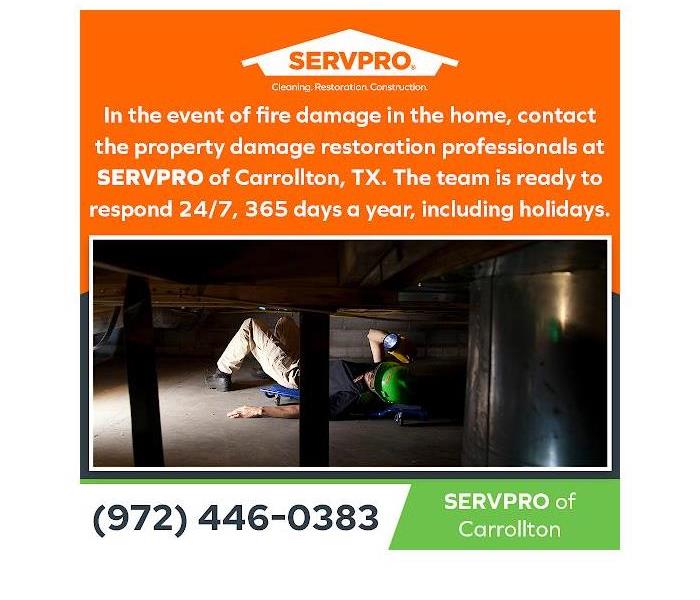 #heretohelp!
#heretohelp!
There really is no such thing as a minor house fire, is there? Any time a fire ignites inside a home, many things inside can get damaged. Even if the amount of items that get burned is minor, significant fire loss can still occur. Even the smallest burns can force your property to suffer a fire loss, including soot, smoke, and odors.
Smoke damage in your home
When anything burns, some substances are released into the air, even if the item doesn’t completely burn, or does so for only a brief period of time. Particles that do not combust entirely and get released into a building can cause smoke damage to your home even if the blaze is small. Smoke can quickly spread throughout your home. When smoke comes into contact with cooler surfaces, the partially combusted particles can transform back into a solid form. Once this happens, soot residue and other soils can appear visible on the surfaces of your walls and other building materials as well as the contents that are present inside your house.
The result can be quite messy! SERVPRO of East Carrollton and Bent Tree technicians are IICRC certified and experienced in dealing with smoke and fire damage situations. We know that even a small burn that takes place inside your kitchen can cause damage. We are trained at finding even the most imperceptible damage that could cause you problems in the future.
Odors caused by fires
Smoke not only causes residues to exist on the surface of items inside your home, but it can also penetrate materials and cause unpleasant aromas to exist. Smoke can seep deep into porous materials and cause them to put out unpleasant smells into your house's airflow system. Our crews at SERVPRO can utilize certain methods and chemicals that will help extinguish such foul odors long after the flames are gone.
Soot residue after a fire
Soot residue can be one of the most frustrating situations to deal with after a fire. Even if the flame was small and the fire was extinguished quickly, depending on the materials, a substantial amount of soot damage can remain behind. If not handled correctly, trying to clean up soot can cause more of a mess than the soot itself! Our fire remediation specialists are trained to deal with soot residue and ensure every last trace of it is gone by the time we leave.
If you ever have a problem after a small house fire, call SERVPRO of Carrollton at 972-446-0383 any time of the day or night. We know how to deal with smoked damage, odor removal and soot cleanup to get your home back to the way it was prior to your house fire.
Helping Enjoy a Safe Fireworks Display and Avoid Fire Damage
6/8/2022 (Permalink)
Blog Summary: SERVPRO of Carrollton advises Farmers Branch, TX, residents on how to safely set off fireworks.
The team of property damage restoration professionals at SERVPRO of Carrollton is ready to provide fire damage restoration services when fireworks cause a fire damage disaster. To prevent personal injuries and fire damage from fireworks and to promote the proper, safe use and enjoyment of fireworks, SERVPRO of Carrollton offers these helpful tips to families in Farmers Branch and the greater Carrollton, TX area.
The American Pyrotechnics Association (APA) chronicles the history and significance of fireworks over the last 2000 years: “Many historians believe that fireworks originally were developed in the second century B.C. in ancient Liuyang, China. It is believed that the first natural “firecrackers” were bamboo stalks that when thrown in a fire, would explode with a bang because of the overheating of the hollow air pockets in the bamboo. The Chinese believed these natural “firecrackers” would ward off evil spirits.”
Later technological advances saw the invention of gunpowder and the first fireworks. According to the article, “Sometime during the period 600-900 AD, legend has it that a Chinese alchemist mixed potassium nitrate, sulfur, and charcoal to produce a black, flaky powder – the first ‘gunpowder.’ This powder was poured into hollowed-out bamboo sticks (and later stiff paper tubes) forming the first man-made fireworks.”
As part of the American experience, fireworks have a rich heritage that reaches from the first Independence Day in 1776 to the present. The APA writes, “Early U.S. settlers brought their love of fireworks with them to the New World, and fireworks were part of the very first Independence Day – a tradition that continues every 4th of July when we celebrate as John Adams had hoped “with pomp, parade….bonfires, and illuminations from one end of this continent to the other.” Americans’ spirit of celebration continued to grow, and in the late 18th century, politicians used displays to attract crowds to their speeches.”
The enjoyment of fireworks on and around July 4th is an epic event. Fireworks are also used throughout the year for celebrations at town festivals, fairs, commemorative events, and sporting events such as car races and football games.
Fireworks Safety Tips
The personal use of fireworks is carefully regulated to protect the physical safety and prevent fires and fire damage. Keep the fireworks celebration enjoyable by following this checklist of safety tips to ensure family and guests stays out of harm’s way when pyrotechnics are in use.
1. Select a safe site.
Stage the fireworks display from a location that is free of overhanging trees. The ground should be flat, firm, and free of combustible materials such as dry grass or hay and old buildings. Consider neighbors, veterans, and pets that might be traumatized by the loud, unexpected explosions and bright flashes of light. Do not ignite fireworks on the back deck or patio. Cordon off the “light-and-launch” area with yellow or orange safety tape.
2. “Light and launch” only in safe weather.
Wind and fireworks are a potentially dangerous combination. Sparks can blow onto dry grass or fields, causing a wildfire. A gust of wind can topple a rocket or mortar, which at that point becomes a dangerous projectile. Keep in mind that in some municipalities, the persons responsible for hosting the fireworks display may be liable for any costs associated with extinguishing a fire caused by the fireworks discharged at the event. A small brush fire engulfing a small area of several acres could cost tens of thousands of dollars to extinguish and do hundreds of thousands, if not millions, of dollars in property damages.
3. Expect the unexpected.
Keep the following items on hand: a bucket of water, a fire extinguisher, and a garden hose with a hose-end nozzle. In the event of an accidental fire, these tools could be pivotal in preventing personal or property damage.
4. Light the fuse and retreat to a safe distance.
Thirty-five feet is recommended safe distance from non-aerial fireworks and 150 feet for aerial fireworks such as rockets and mortars. Do not light and launch fireworks such as bottle rockets or firecrackers from the hand. Take a “one and run” approach to lighting fireworks. Light one firework at a time. A standard fuse only allows three seconds for a retreat to a safe distance, and attempting to light two or three fireworks simultaneously is very risky. If a fuse falters, douse the firework with water. Do not pick it up for at least 5-10 minutes. Use heavy gloves or a pair of tongs to place the dud in a bucket of water.
For the finale, keep a watchful eye on all children and pets. Know and follow the local fireworks ordinances. Penalties could be harsh. If the fireworks display is large and involves a crowd of onlookers, hire a professional to conduct the show.
Trust the restoration experts at SERVPRO of Carrollton for fire, water, storm, and commercial damage restoration. They offer twenty-four-hour emergency service, a rapid response to any size disaster, highly trained restoration technicians, and advanced restoration and cleaning equipment.
For more information about Farmers Branch, TX, fire damage restoration, contact the office by phone at (972) 446-0383 or by email at office@SERVPRO10952.com.
Odor Control is Necessary After a Fire at your Property.
4/12/2022 (Permalink)
Odor Management after a Fire in a Bent Tree Home
Odors are a common effect that North Dallas homeowners must contend with after a fire – regardless of its size or severity. Our professionals have methods to manage these detrimental effects and help limit its migration. With the application of specific tools and products, we can eliminate these odors and help to continue the process of making a fire loss, “Like it never even happened.”
Though we have a fast response that dispatches qualified professionals 24/7 from our facility, the effects can be widespread through the house by the time our crew arrives at your Bent Tree fire damage emergency. As premier specialists in fire loss scenarios, we have the training and expertise to assess the situation and set up the appropriate containment barriers to enclose the affected spaces to maximize our odor removal and cleaning efforts.
Managing the presence of smoke odors can come with risks and hazards, as many of these same situations have airborne threats such as soot particles. Soot is highly acidic in its composition, and because of its microscopic size, it can penetrate deeply into the lungs and cause health effects for those exposed. Our SERVPRO team must address these concerns and the odor to keep the technicians on-site and the house's occupants safe.
While air scrubbers and negative air systems can help reduce the presence of these particulates and debris in the environment by running the air inside through HEPA filters, we can often utilize a tool like our hydroxyl generator. Using a UV spectrum that interacts with water vapors in the environment, these machines can clean and deodorize affected areas.
Containment strategies like plastic sheeting can help slow the progression of spreading odors throughout the home and any existing particulates or contaminants in the air. By focusing on filtration and deodorization, our SERVPRO of Carrollton and Bent Tree team can make your home safe to be in after a fire.
Give our professionals a call anytime you need us at (972)-446-0383.
What Fire Damage Risks Are Common to the Garage Area?
4/12/2022 (Permalink)
Blog Summary: SERVPRO of Carrollton warns homeowners about common fire damage risks in the garage that should not be overlooked.
Fire damage restoration in a garage that has been engulfed in flames presents a complex set of challenges for the team of professionals who have been tasked with the restoration project. Knowledge, experience, and training are essential for a fast, safe, and thorough restoration.
What Factors Contribute to Fire Damage Risks in the Garage?
The identification of potential fire hazards in the home should be top of mind for every homeowner. Some areas, such as the kitchen, are well-known for their fire risks, but other spaces, such as the garage, contain fire hazards that are often overlooked.
Fire safety in the garage sometimes receives minimal attention because the homeowner may regard the space as separate from the main structure even though the garage may be “attached.” Organization, cleanliness, and fire prevention practices are vitally important in the garage, especially if it is connected to the home. In the normal course of life, the garage is a dynamic, high-traffic living space full of activity, including work, recreational activities, and entertainment.
By giving attention to the six common garage safety hazards listed below, the homeowner can enhance the safety of the garage, as well as the rest of the home.
- Faulty wiring
At the top of the list of electrical issues that can cause a fire in the garage is faulty wiring. In fact, a leading fire prevention research and reporting group, the U.S. Fire Administration, highlighted electrical malfunctions as the number one cause of fire in the garage. Garage fires are so dangerous because the smoke and flames go unnoticed until the situation is out of control. A high concentration of flammable items, clutter, and combustible accelerants exacerbate the potential for an inferno.
An older home is more likely to experience electrical issues. The owner of an aging home is advised to consult with an electrician regarding any concerns about the garage’s electrical system. Examples of potential electrical fire hazards in an older home include the following:
- Faulty electrical outlets that spark when put into use
- Outdated outlets that lack GFCI technology
- Aging electrical wiring showing signs of deterioration such as brittle and cracking insulation
- Compromised or damaged wiring from exposure to variations in the temperature and moisture in the environment
- Damage from rodents (mice, squirrels, chipmunks, etc.) gnawing at the wiring
- Other general electrical issues
Outdated electrical circuits in the panel box can malfunction, leading to a fire. The garage often serves a dual purpose as a workstation for hobbies, home repairs, and tinkering. The improper use of extension cords can lead to catastrophic consequences. Extension cords are not a permanent solution for electrical needs in the garage. Avoid overloading an extension cord. Destroy and discard damaged cords that cannot be properly and safely repaired.
Homeowners are advised to make the switch to LED light bulbs in the garage and throughout the home. This lighting technology is energy efficient, highly luminescent, and operates at a much lower temperature than traditional incandescent lights.
- Clutter
The garage is more than a space to park the car; it also serves as a storage area. Unfortunately, the clutter can be fuel for a fire. An organizational solution can greatly reduce the fire hazard by getting the items off the floor, isolating them on a shelf, or shielding them in a cabinet or storage bin. If the item has not been used in a year, consider selling it, donating it, or disposing of it.
- Improper storage of combustible liquids
The garage is a ticking time bomb when used as a storage center for flammable liquids such as oil, gasoline, lighter fluid, aerosols, and oil-based paint. According to the American Petroleum Institute, gasoline and other flammable liquids should be stored in a safe, secure place no less than 50 feet from a structure such as a home.
- Improper storage of hazardous materials
Homeowners will often store pelletized fertilizer, oily rags, and car care products in the garage. However, this practice adds to the overall fire risk in the garage and should be avoided.
- A lapse in vigilance
Garage fires can often be traced to carelessness. Welding in the garage is not advised. Grilling in the garage is another recipe for disaster. A smoke detector, a carbon monoxide detector, and a fire extinguisher are great additions to the garage.
In the event of fire damage in the home, contact the property damage restoration professionals at SERVPRO of Carrollton, TX. The team is ready to respond 24/7, 365 days a year, including holidays.
For more information about fire damage restoration in Richardson, TX, email SERVPRO of Carrollton at office@SERVPRO10952.com. The office can also be contacted by phone at (972) 446-0383.
Preston Ridge Property Damage from Fire in Attic.
3/29/2022 (Permalink)
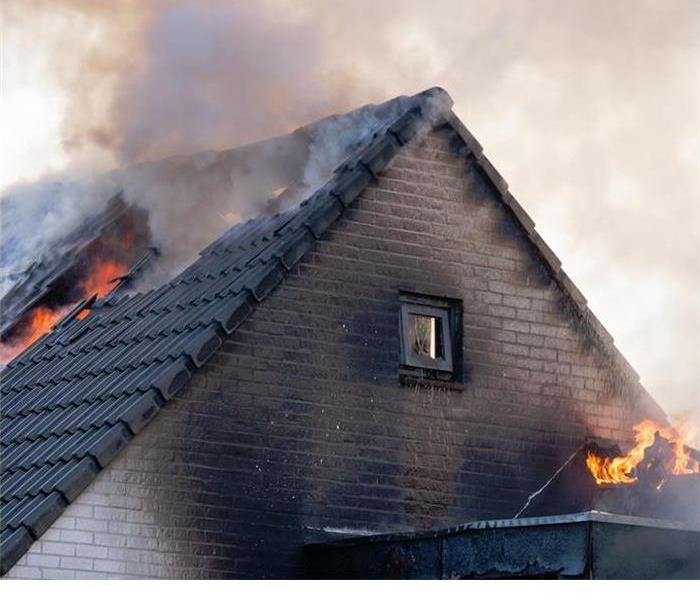 After a home fire, there are charred remains and odors that need to be dealt with. Contact SERVPRO right away for fire damage remediation services.
After a home fire, there are charred remains and odors that need to be dealt with. Contact SERVPRO right away for fire damage remediation services.
For Fire Damage Mitigation Inside Your Attic in Preston Ridge, Call SERVPRO
Once flames light up inside your North Dallas home, the heat will rise, and the blaze will start torching your building materials that are above the initial source. Commonly, an inferno can engulf the components that make up your ceiling, attic, and roof.
How Can You Tell What Materials Will Have to be Removed and What Can be Saved?
During every fire damage project in Preston Ridge, whether or not your structural components will have to be removed and replaced depends on how severely the item got burnt and how deep the charring went.
Our SERVPRO technicians can conduct a thorough inspection of your building and determine which items we think we can save through sanding or sandblasting, refinishing, cleaning, and sealing. When the flames have consumed sections of your ceiling and made their way into your attic, we inspect the following building materials for issues:
- Acoustic Ceiling Tiles and Drywall- In most cases, if your ceiling tiles or drywall got anything more than just surface charring, the materials must be removed. In this case, we can remove just the burnt pieces of your ceiling and dispose of them in sealed plastic bags. If other parts of your sealing are coated in soot residues, then we can clean them with dry sponges or wet cleaning techniques.
- Insulation- If the insulation inside your attic got burned during the fire, in most cases, it must get removed. If your insulation is just smoke-damaged, it can be deodorized, but it is usually more cost-effective to remove and replace it.
- Trusses- When determining whether we can save your affected roof trusses or not, we follow the general quarter inch rule. If the charring is less than a quarter-inch deep, then we can sand down or sandblast the charring off. As a final step, we can then apply a specialized sealant paint to your entire attic to seal any foul odors.
What Homeowners Should Know About Flammable Clothing to Avoid Injuries and Fire Damage
2/9/2022 (Permalink)
Blog Summary: SERVPRO of Carrollton urges homeowners to wear safe clothing when around an open flame so that fire damage can be avoided.
SERVPRO of Carrollton knows firsthand the impact COVID-19 is having on the frequency of home fires and fire damage. Many people continue to work, study, cook, entertain, and play at home. With so much activity around the home, it is no wonder that residential fires have been on the rise.
Lifestyle has shifted over the last several years. Work, leisure, and entertainment are more centered around the home. Fire pits, outdoor fireplaces, grills, smokers, deep fryers, tiki torches, backyard bonfires, and intimate campfires are growing in popularity. The easing of travel restrictions and a widespread return to school and the workplace have not diminished the enjoyment friends and family experience sitting around a cozy campfire.
However, this time with loved ones comes with risks. Over 5,700 grill fires occur on residential properties each year, and almost 20,000 people per year went to hospital emergency departments suffering from injuries related to grilling or barbecues in 2014-2018. Nearly 10,000 of these injuries were burns. In 2017, an estimated 5,300 people received burns from outdoor fire pits or heaters. About one-fourth or about 1300 of these victims were children under the age of five.
For several years, outdoor fire pits and fireplaces have been favorite design elements in the residential backyard, according to surveys conducted by the prestigious American Society of Landscape Architects.
The continued popularity of outdoor cooking and casual engagements around fire means homeowners and families need to know about flammable clothing to avoid injuries and fire damage.
Grilling the evening meal and relaxing around the fire pit involves being close to an open flame. During the grilling process, cooks will often have flames licking at their hand and forearm while they reach to reposition or flip items on the grill. If the chef lingers for a moment too long, burns can be sustained on the unprotected hand and forearm. If the cook is wearing a long sleeve shirt, sweater, or jacket, the apparel could ignite, causing serious bodily injury.
Burning wood tends to generate sparks, which can ignite clothing or other flammable materials and substances. Some sparks fly upward while others pop outward from the flames. If a fire screen is in place, the onlookers are somewhat protected from sparks, but this screen must be removed to add new logs. Onlookers sitting around the fire pit are most vulnerable when the screen is removed and firewood is being added.
Caution should always be exercised whenever people are gathered around an open flame. Considering the flammability of clothing is one way that hosts and houseguests can lower the possibility of a fire damage disaster.
Tip: Know the chemical makeup of the clothing.
Some clothing and other textiles may be very flammable. While all clothing can burn, certain fabrics can be more dangerous than others. For instance, never wear acrylic clothing near the open flame of a fire pit, campfire, or bonfire. Take note of the product’s flammability, and read the manufacturer’s label or request the salesperson provide the information.
Tip: Pay attention to the structure of the piece of clothing.
The texture and structure of the material play an important part in how the piece of clothing will burn if it catches on fire. Lightweight, thin fabrics that allow a generous amount of airflow can more easily ignite, and once ignited, the clothing burns quickly. Materials manufactured with a porous, coarse, or woolly surface more readily ignite and burn than materials with a smooth, nonporous surface.
Tip: Loose-fitting and billowy clothes are a fire hazard.
Flowing, billowy clothing has an increased surface area, making it easier to come in contact with an open flame. Wide, drooping sleeves are hazardous to wear when grilling fatty foods that create large, licking flames. A flowing dress or a lightweight or trailing scarf puts the wearer at risk. Some costume designs may put children at risk if the costumes are worn near an open flame.
Tip: Wool and modacrylic are relatively safe to wear around a fire.
Thick wool does not readily ignite, and if it does catch fire, it will put itself out fairly quickly. Modacrylic is very flame-resistant.
Tip: Cotton and linen are fire hazards around an open flame.
Clothing made of cellulose fibers such as cotton, linen, and viscose are very flammable and burn very quickly unless treated with a flame retardant.
Tip: Polyester and nylon (polyamide) melt and pull away from the flame.
In combination with other fibers, nylon and polyester present a fire danger. When exposed to fire, the melting fabric can cause deep burns.
Tip: Avoid wearing acrylic while near an open flame.
Though difficult to ignite, acrylic burns vigorously, and the fibers melt and drip, causing deep burns. Acrylic should not be worn around a fire pit or bonfire.
Tip: If clothing catches on fire, immediately stop, drop, and roll.
The stop, drop, and roll protocol cuts off the airflow to the clothing, readily extinguishing any flames.
The professionals at SERVPRO of Carrollton encourage homeowners to be careful when grilling or enjoying time around a fire pit or bonfire. If fire damage occurs, the SERVPRO team is available 24/7, 365 days a year, to provide a rapid response. Prompt response times enable the fire damage restoration process to begin immediately, reduce secondary damage, and return life to normal as quickly as possible. SERVPRO of Carrollton can handle the insurance claims process from beginning to end, relieving the homeowner or business of the headache.
For more information about fire damage cleanup in Dallas, TX, and surrounding areas, contact the office by phone at (972) 446-0383 or by email at office@SERVPRO10952.com
Little Known Kitchen Hazards That Can Cause a Fire Damage Disaster
2/1/2022 (Permalink)
Blog Summary: SERVPRO of Carrollton highlights five kitchen fire damage risks that homeowners should know about.
SERVPRO of Carrollton confronts and overcomes the unique challenges and dangers presented by a fire damage cleanup and restoration project. On scene within an hour of the customer’s initial contact, the crew’s training and discipline take charge as they inspect and assess the situation and execute a well-coordinated cleanup and restoration plan. SERVPRO of Carrollton explains kitchen fire damage risks that the homeowner should know about. The goal is to prevent a fire damage disaster from ever happening.
According to the National Fire Protection Association, most house fires occur in the kitchen. This statistic reflects the activities that take place in this important room in the home. Appliances such as the oven, stovetop, microwave, crockpot, countertop grill, air fryer, deep fryer, coffeemaker, and toaster operate at temperatures high enough to ignite flammable materials found in the home. The food being cooked, the cook’s clothing, and the appliance itself can all catch fire, causing fire damage and potential injuries.
Listed below are some less well-known causes of kitchen fires that homeowners need to know about in order to stay safe.
#1. Spontaneous combustion
Certain chemicals in a material can react together, resulting in the generation of heat. The temperature may increase to the point where the material spontaneously combusts and bursts into flames. Spontaneous combustion can occur when items such as sawdust, compost, or oil-based products are stored improperly. For instance, if the internal heat created by a kitchen compost container is not allowed to escape, spontaneous combustion could occur. However, such cases are rare. Keep the compost pile turned and moist for the best results.
#2. A grease-coated stove
A clean stove is a safer stove. A stove coated with grease and other flammable grime presents a fire hazard that could allow a small kitchen fire to get out of control very quickly. Take a minute to wipe down the stove and the countertop near the stove. Clear the area around the stove.
Before turning on the heat, make sure napkins, paper plates, paper towels, dishcloths, and flammable cooking ingredients (cooking liquors such as bourbon, sherry, rum, etc.) are kept at a safe distance from the stove.
#3. A propane tank
A propane tank used for the grill should not be stored inside the home because the tank can leak when not in use. A small shed or storage closet in the garage is not the best and safest place to store a propane tank. If a small leak accumulates, it can ignite with a spark from an outlet or an arc when an appliance cycles on. The best place to store flammables is in a sheltered area located at a safe distance from the house or other detached structure. The flammables need to be protected from the elements and kept well-ventilated to prevent the ignition of leaked propane or fumes.
#4. Dust
Dusting is an important chore around the home, especially in the kitchen with so many heat sources. Most people think of dust bunnies as hiding under the bed, dresser, and sofa. In the kitchen, dust can create a hazardous situation involving fire risks. Dust bunnies can ignite if exposed to a spark from an electrical outlet. Regularly clean dust build-up, and remember to dust behind and under refrigerators and freezers. Also, clean under the oven, another favorite hiding place for dust bunnies.
#5. Flour
Flour can create a kitchen fire hazard. Air-born flour dust can combust under certain cooking conditions in the kitchen. Non-dairy creamer, dried milk, spices, and other powdered food substances can readily ignite in a cooking environment. The open flame from a gas oven or stovetop burner presents an elevated risk when these types of consumables are in use. The tiny dust particles burn very quickly and efficiently from all exposed sides. The dust particles have the potential to flare up much like gas fumes when exposed to an open flame.
A house fire creates a complex damage scene involving fire damage, smoke damage, and water damage. Combustion causes chemical reactions that make a fire scene very toxic for humans and pets. Cleanup and restoration require training, experience, special cleaning techniques and products, and personal protective gear (PPG).
The professionals at SERVPRO of Carrollton can clean, deodorize, and restore a fire-damaged property as if the fire had never occurred. A DIY fire damage restoration project is not advised.
Trust the restoration experts at SERVPRO of Carrollton for fire damage cleanup services in Dallas, TX. The company offers twenty-four-hour rapid emergency response, 365 days a year.
Contact the team at SERVPRO of Carrollton by phone at (972) 446-0383. The damage restoration company can also be contacted by email at office@SERVPRO10952.com
Smoke Detectors
1/19/2022 (Permalink)
It’s good to replace the batteries in your smoke detectors every twelve months, but you should also consider replacing the smoke detectors in your home or business if they are more than 10 years old.
Most smoke detectors contain some electronic components, and after 8-10 years the alarm sensors wear out. At that point, the entire unit should be replaced. When you replace the unit, write the purchase date on the inside cover, so that you’ll always know when you purchased that unit.
Generally a smoke detector will let you know if the battery is low. If the smoke detector keeps chirping or there is a blinking red light you might need to change the battery. The smoke detector red light could also indicate that it is over 10 years old and needs to be replaced. A hard wired smoke detector with a red blinking light could indicate there is a problem with the wire connection.
A smoke detector in good working order is an essential component of your home's safety equipment and having at least one smoke detector means that you, your family and your home are safer.
Understanding the cleaning processes after a fire damages your home.
12/27/2021 (Permalink)
Whenever a fire burns inside a home, there are several different types of damage that possibly happen; each requiring a unique approach to clean and restore. Smoke coming from the fire can leave behind soils, soot residues, and foul smells. Understanding what cleaning techniques are used during fire remediation can make the process less stressful.
How SERVPRO addresses fire damage
While some items may get removed and replaced after a home fire if they’re not salvageable, SERVPRO's fire damage technicians attempt to restore and clean materials and contents whenever possible. If we use the right chemicals, we can clean and restore items that receive damage from smoke.
When addressing soot left behind from a fire, we often use multiple methods to remediate the damage. Soot coming from burning different fuels has different compositions; some soot residues are hard to remove whereas some are easily wiped off. Some surfaces soot does not adhere well and can be easily cleaned. Other material surfaces with certain types of soot and cleaning are nearly impossible.
Having fire remediation training allows our technicians to know how to address fire damage with the best approaches possible.
Three methods of cleaning soot
When cleaning soot off different types of walls, there are three primary methods. The three main cleaning methods for removing smoke damage are dry cleaning, wet cleaning, and peroxide-based cleaning.
For non-grease-based soils, dry sponges seem to work well in most instances. The sponge is designed to attract soot residues so that they stick to the sponge instead of the walls, removing the soot more easily. In some scenarios, wet cleaning methods work better. For wet cleaning, SERVPRO uses soapy water and rags to scrub the walls and ceilings of homes.
Wet cleaning works best when cleaning painted, wood or metal surfaces. This method works with heavy dry ash or soot residue and light to heavy oil-based residues. When cleaning specific materials, peroxide-active cleaning methods get utilized, based on the discretion of the fire remediation specialist. Peroxide cleaning works when removing soot from acoustical ceiling tiles.
Working with a remediation specialist provides better results
Fire remediation cleaning processes vary based on the situation, the kind of materials being dealt with, and the extent of the damage. Working with a fire remediation specialist provides professional guidance to get the job done. For professional assistance removing soot, call SERVPRO of Carrollton and Bent Tree at 972-446-0383, 24/7.
We’re here to help you recover when you experience a fire in your home.
Eight Fire Risks That Carrollton, TX, Property Owners Should Pay Attention To
11/23/2021 (Permalink)
Blog Summary: SERVPRO of Carrollton warns local homeowners about possible sources of fire damage that they should watch out for.
The professionals at SERVPRO of Carrollton are prepared to handle Carrollton, TX, fire damage disasters using the latest equipment, cleaning techniques, and effective cleaning and deodorizing solutions that are safe for humans and pets.
A house fire occurs every 87 seconds in America. Annually, 358,500 households experience the stress, disruption, and inconvenience of a fire. Carrollton homeowners can improve home fire safety by recognizing potential sources of fire damage in the home.
Most homeowners are familiar with common sources of fire damage such as overloaded electrical circuits, overturned candles, and malfunctioning appliances. Other items in the home not usually associated with fire hazards pose potential fire risks. The danger lies in overlooking these potential fire hazards. Here is an explanation of these frequently overlooked fire hazards.
Hazard: Microwaves
The microwave, invented in 1955, is a staple in most kitchens. The potential for fire with this appliance is significant, yet most homeowners are not aware of the microwave’s many fire risks. Metals and microwaves do not mix. Metal on takeout containers, in dinnerware, and in recycled paper products can cause arcing, sparks, and fire. When overcooked, popcorn can easily catch fire.
Keep the microwave clean. Only cook items that are designed to be heated in the appliance. Microwaves are high voltage, and they pose a serious fire risk when they malfunction. The best course of action when dealing with a malfunctioning microwave is to replace it. Never attempt to repair a microwave since a new unit can be purchased at a very reasonable price.
In case of a fire in the microwave, immediately shut off the power. Open the door only when the fire is out.
Hazard: Batteries
Most homeowners would not think a battery could cause massive fire damage or even burn down a home. Yet, all batteries pose a fire risk. Nine-volt batteries are the most dangerous. The close proximity of the terminals increases the risk of a short. The use of a plastic battery storage case is advised. Avoid leaving batteries lying around loose, and store batteries standing up. Place electrical tape over the terminals of each battery. All types of batteries should receive this treatment to prevent shorts and potential fires. Batteries and metal containers are a hazardous combination. Keep steel wool, aluminum foil, and keys away from batteries. Nine-volt batteries are risky enough to warrant being stored separately from other batteries.
Hazard: Light bulbs
Using a light bulb with a wattage that is too high for a given outlet – a mistake known as overlamping – can cause a home fire. Limit light bulb wattage to sixty watts. While LED bulbs are generally a cool, highly efficient solution, higher wattage LED bulbs can generate higher heat. Homeowners should be careful when handling these bulbs.
Hazard: Dryer lint
A buildup of dryer lint in the dryer vent or ductwork can ignite and become a fast-moving fire. Remove the lint from the lint screen after every load. Vent the dryer with aluminum tubing to comply with current fire codes. The lint trap captures only 25% of the lint. Clean the vent, exhaust ductwork, and area around the dryer regularly.
Hazard: Laptops
Laptops generate heat during normal operation. Make sure the cooling vents are unobstructed. Placing the laptop on the bed, couch, or chair can prevent the cooling mechanism from functioning adequately, damaging the device or causing a fire. The safest resting place for a laptop is a desk or stand.
Hazard: Stacks of newspaper and magazines
Print materials such as newspapers, magazines, and books can ignite very quickly and should never be stored close to a heat source. Store old newspapers or magazines in a cool, dry place in short stacks. If the items have little or no sentimental value, discard them immediately.
Hazard: Heating blankets and pads
Heating blankets and heating pads are excellent devices for easing pain or relieving the chill of a cold winter night. However, these devices can cause fires if they malfunction due to age, damage, or misuse.
Here are some safety tips for using a heating blanket or heating pad:
- Carefully follow all manufacturer’s operating instructions.
- When using a heating blanket in bed, do not leave the cord between the mattress and box spring where it may be pinched or folded.
- Keep the blanket or pad flat when in use.
- Operate these items on the lowest setting. Do not exceed the recommended operation time.
- Wash the items carefully. Do not dry heating devices in the clothes dryer, and do not iron or dry clean them. These activities can melt heating wire insulation and increase the potential for fire.
Hazard: Barbeque charcoal
Practice caution when storing charcoal. The ordinary backyard grill master may not be aware that damp charcoal can ignite and start a raging fire. Store charcoal in a cool, dry place; a metal pail or garbage can with a tight lid is recommended.
An awareness of these potential fire hazards can lead to efforts to make the home safe from potential fire risks. Homeowners need not live in fear. By taking actions to make the home safe and by pre-qualifying a fire damage restoration company, the homeowner can have peace of mind. If a property damage disaster should occur, a competent, reputable company will respond 24/7, 365 days a year with highly trained technicians, advanced equipment, and EPA-approved cleaning, deodorizing, and sanitizing solutions.
For more information about fire damage restoration in Carrollton, TX, contact SERVPRO of Carrollton by phone at (972) 446-0383. Staff can also be contacted by email at office@SERVPRO10952.com
What should you avoid after a fire damages your home.
11/19/2021 (Permalink)
Once a home fire has been extinguished, it’s a natural impulse to try and clean up as quickly as possible but doing so may cause more damage than good. Below is a list of actions to avoid following a house fire to help you recover quickly and safely.
Avoid using electronics
After a fire, it’s best to wait until a professional arrives on the scene to ensure electronics are safe to use. This includes TVs, computers, and DVD players. Even the A/C needs to stay off until you get the all-clear. Turning on electronics can create greater damage.
Don’t try to clean possessions on your own
While it’s tempting to grab a bucket of water and get to work, it's best if you do not clean walls, ceilings, and other similar surfaces, and wait to clean your clothing and similar garments. A professional should examine them first and provide advice. In some cases, different types of approaches to cleaning are necessary for different items to avoid causing further damage, so it’s best to wait for a fire remediation professional to give you advice before trying to clean on your own.
Toss all food in your home
Never eat anything that was in the home during the fire. Smoke, soot, and chemicals can get into everything and it’s better to be safe than sorry. It is most likely not safe to consume due to contamination from smoke, soot, or contaminants introduced to the environment when the fire was being extinguished. That includes canned goods. Heat damage may not be seen on the outside of canned goods, but the heat can re-cook the ingredients in the can causing harm.
Refrain from cleaning up after firefighters
Unfortunately, extinguishing a fire can cause a mess on its own as fire retardants and other foams or powders may have been used to stop the flames. Forgo trying to clean up any staining from the powder discharged by a fire extinguisher. It is best to let professionals guide the cleanup of these areas as they have the equipment to handle different types of chemical cleanup on a variety of surfaces.
It’s always tempting to start the cleanup process immediately and do as much as possible. The best course of action is to hire a certified professional to provide expert knowledge and service. The situation requires specialized tools and knowledge that only a professional can provide. A trusted professional will offer an after-fire checklist that will help speed along the fire and smoke damage cleanup process. Consulting a professional will help you restore your property back to like-new condition as quickly as possible. If you experience a house fire, contact SERVPRO of Carrollton
24/7 at 972-446-0383 to get the help you need.
Fire Remediation Service Options-
11/19/2021 (Permalink)
Here are some services that are available to you after you experience a fire in your home.
- Mitigation services: The focus of mitigation services is to secure your property and prevent any further damage after the fire has occurred. These services include boarding up any openings to secure the property, providing an alternative source of electricity, and emergency drying to prevent secondary water damage. Handling these issues quickly can keep further damage to a minimum
- Structural cleaning services: Structural cleaning services involve removing smoke and soot residue from your home and deodorizing the premises after a fire. Our experienced SERPVRO technicians step you through the entire process and strive to repair as much damage as possible. As the homeowner, you’ll be fully involved in the process from beginning to end.
- Contents cleaning services: Smoke and soot can damage your personal belongings and furniture if not cleaned promptly and thoroughly. While it may seem that wiping down belongings will suffice, that’s not always the case. SERVPRO technicians have expertise in cleaning and restoring many personal items such as furniture, documents and photographs, and other valuables after smoke and soot damage. We use state-of-the-art equipment to get rid of the damaging smoke and soot as efficiently and as quickly as possible and restore your belongings to pre-fire condition whenever possible.
- Specialty cleaning services: We also help you to subcontract the cleaning of precious or delicate items such as electronics, clothing, and expensive artwork.
- Reconstruction services: In some instances, a fire can cause structural damage that cannot be restored by fire damage restoration services. If there is a need for reconstruction or structural repair, you may need the help of licensed general contractors. SERVPRO’s building services are available to help.
Fire damage restoration is a slow process that takes time and patience. With SERVPRO, you get a team of fire damage restoration professionals who can help you restore your home back to
preloss conditions in no time.
What steps should I take after a house fire?
10/22/2021 (Permalink)
Fire is not something that any family wants to deal with but it is helpful to know a little bit about the restoration process in case you ever do run into this type of issue. There are a few different steps that will facilitate the restoration process and each is critical to your family getting back up on their feet after a fire.
The first step is to talk to your insurance company. The vast majority of homeowner’s insurance companies have clauses that will help put you in contact with a restoration company and that will help you pay for the process. This will ensure that you can get the best company for the best price.
Secondly, a restoration company will first and foremost work to remove the water from the home. Leaving water in a home for a long period of time can end up in mold growing which can make the home even less livable. Removal of water can take a few hours to a few days depending on how much water was pumped into the home to stop the fire.
In cases where the home is a total loss, no steps will be taken and the insurance company will move to help have the home leveled. The second step is to clean up debris; cleaning debris allows the restoration company to get an even better look at what damage was done so that they can begin to assess an action plan to determine what can be saved and what must be trashed.
After debris is removed, restoration companies will use an ozone machine to remove the smoke smell and will start to clean the walls and floors to make sure the smoke smell is gone. The next step is construction; most restoration companies will work with the homeowner to create a reconstruction plan to get your home back on track.
Helping Homeowners Understand the Different Aspects of Fire and Smoke Damage
9/6/2021 (Permalink)
Blog Summary: SERVPRO of Carrollton damage restoration company explains the repercussions of a fire and smoke damage disaster and how it is different from other property damage disasters.
A fire damage disaster is different from a burst washing machine supply line, a mold infestation, a flooded basement, or a sewage spill. The typical water intrusion is disruptive, annoying, and frustrating. In contrast, the sound of smoke alarms blaring at 2:00 am in the morning causes fear and panic. The narrow window of escape closes with each passing minute. A small water intrusion or sewage spill is usually limited to a localized area such as the laundry room, kitchen, or bathroom.
A grease fire in the kitchen can fill an entire home with the smell of smoke, a coating of soot, and a dusting of ash and chemicals from the fire extinguisher. Even a small, localized fire can impact every surface and air space in a home. The extent of the damage and the intensity of the smokey smell require the services of a licensed and insured fire, smoke, and water damage restoration company to thoroughly and safely address the situation.
The American Red Cross offers the following advice for homeowners who are attempting to inspect their fire-damaged home: “Do not cut or walk past colored tape that was placed over doors or windows to mark damaged areas unless local authorities advise that it is safe to do so. If a building inspector has placed a color-coded sign on the home, do not enter it until you get more information, advice, and instructions about what the sign means and whether it is safe to enter your home. If you have children, leave them with a relative or friend while you conduct your first inspection of your home after the fire. The site may be unsafe for children, and seeing the damage firsthand may upset them and cause long-term effects, including nightmares.” This advice highlights the serious nature of a fire and smoke damage disaster.
No two fires are identical. Each incident presents distinct challenges across a broad spectrum of variables. A fire and smoke damage restoration team must consider a number of factors when approaching a fire damage disaster, including:
- the source of the fire
- the intensity of the flames
- the combustion rate of the materials consumed by the fire
- the physical layout of the structure
The Repercussions of a Fire and Smoke Damage Disaster
When a fire breaks out, it immediately begins to change the environment of the building. With sufficient fuel and adequate air supply, a fire consumes materials as it burns—a more explosive fuel source leads to more complete consumption of the structure and its contents. Products of Incomplete Combustion (PICs) include residues, partially consumed materials, and soot tags. A soot tag forms during a fire when the soot particles bond together, forming what looks like a spider web clinging to the ceiling, wall, or rafters. Several factors control the volume of soot, how far it spreads, and its penetration.
An abundance of oxygen enables a fire to burn at a high temperature. Known as dry fires, these high-temperature fires convert organic materials such as wood and plastics into dry soot, which is primarily carbon. The consistency of dry soot makes it less troublesome to remove than other residues. An industrial-strength vacuum, one of the many pieces of equipment in the SERVPRO tool kit, can tackle the challenges of dry soot.
The high heat generates large amounts of carbon-rich dry soot that are deposited throughout the structure. The heat also causes surfaces to expand and capture dry soot particles and other residues. The surfaces, now permeated with dry soot and other residues, give off a strong odor of smoke.
Air circulation in a fire is dynamic. Soot-contaminated air can infiltrate the HVAC ductwork and travel throughout the structure. Fluctuations in air pressure can result in hot, soot-laden air being sucked into a sealed freezer where the temperature and air pressure are lower. The widespread contamination complicates the cleanup, deodorization, and restoration process.
An oxygen-deprived space, such as a closet or a bedroom with a closed door, creates a different cleanup challenge. Should the room become engulfed in flames, the lack of oxygen results in a lower-temperature fire, sometimes referred to as a wet fire. This lower-temperature fire produces more PICs, an oily form of soot, and other residues from non-organic materials. The large volume of PICs from the wet fire generates a significant amount of oily soot and residue, which are much more difficult to remove.
Not all fires create the same odors. Some fires leave behind very intense odors that permeate the entire structure. Other fires do not. Odors from a protein fire require advanced cleaning techniques, effective deodorizers, and thoroughness on the part of the restoration technicians.
The certified technicians at SERVPRO of Carrollton are skilled in cleaning all the nooks and crannies to remove smoke particles. The team of professionals deodorizes all surfaces. An overlooked cabinet door, shelf, or rug may have a remaining odor that is pungent enough to make the fire and smoke-damaged home continue to smell for weeks and months after the blaze.
Since the repercussions of a fire and smoke damage disaster can be severe and lingering, the best course of action is to call the experts at SERVPRO of Carrollton. To learn more about fire damage restoration in Dallas, TX, contact SERVPRO of Carrollton by phone at (972) 446-0383 or by email at office@SERVPRO10952.com
Seven Tips for Avoiding Fire Damage Caused by a Dryer Fire
7/7/2021 (Permalink)
Blog Summary: SERVPRO of Carrollton helps homeowners in Carrollton, Bent Tree, and Dallas, TX, recover from fire damage, including fires caused by the clothes dryer.
A dryer fire can cause significant fire damage in Carrollton, TX, homes. SERVPRO of Carrollton is sharing seven tips to help homeowners proactively prevent a fire from breaking out in the laundry room.
- Know the facts about dryer fires.
An informed knowledge about dryer fire risks can help homeowners think soberly and act promptly to prevent a dryer fire in their homes. When homeowners are aware of fire risks associated with improper dryer usage and maintenance, they will be motivated to take dryer safety seriously and take the necessary precautions.
The National Fire Protection Association (NFPA) reports, “In 2014-2018, local fire departments responded to an estimated average of 13,820 home structure fires per year in which dryers were involved in the ignition. These fires caused an average of seven civilian deaths, 344 civilian injuries, and $233 million in direct property damage annually.”
NFPA research also reveals that “One-third (32 percent) of dryer fires were caused by a failure to clean. This appears to be mainly lint build-up, as 27 percent of dryer fires started when dust, fiber, or lint ignited. Mechanical failures or malfunctions caused 27% of dryer fires; 16% were caused by electrical failures or malfunctions.”
- Clean the lint out of the dryer’s lint filter after every load.
Because over one-fourth of dryer fires are caused by the accumulation of lint and similar substances, homeowners should clean the lint filter regularly. The best practice is to clean the lint filter after each load of clothes dried.
- Perform an annual cleaning and inspection of the dryer and dryer duct.
Homeowners want to make sure that their dryer is in good working order and does not have any blockages in the duct or vent. By cleaning and inspecting the dryer at least once a year, the homeowner can identify and resolve any problems before they lead to a damaged appliance or a fire.
Before beginning the cleaning and inspection process, disconnect the dryer from its power source, and if a gas dryer is in use, be sure to cut off the gas valve that supplies the dryer. Use care when moving the dryer to examine its vent. In the case of a gas clothes dryer, do not damage the gas line or stretch it too tightly.
Consumer Reports provides the following dryer cleaning tips: “Disconnect the duct from the dryer, and vacuum both the dryer and the duct—as much as you can access. Where possible, separate the duct into shorter sections for better access, then reassemble and attach the duct to the dryer. Be sure all joints in the duct are properly connected and held together with clamps or foil tape. Then return the dryer to its original spot and reconnect the power. While you’re at it, clean behind the dryer and underneath it—lint builds up there, too. In winter, check after windy weather or snowstorms to be sure that snow isn’t blocking the outdoor vent.”
- Replace plastic or foil accordion ducts with rigid metal ducts.
Accordion ducts are problematic because they are too flexible or can easily crumple, leading to problems such as restricted airflow and lint buildup. A rigid metal duct is a safer choice.
- Avoid using sheet metal screws to connect duct sections.
Sheet metal screws can collect lint, which leads to lint buildup within the duct. Instead, attach duct sections with duct connectors and metal clamps or dryer vent foil tape.
- Use caution when cleaning chemical stains.
Clothing that has been stained by flammable substances such as oil, gas, or cleaning chemicals should be regarded as a potential fire hazard. Consumer Reports writes, “The Consumer Product Safety Commission recommends washing such stained clothing more than once to minimize volatile chemicals, then hanging to dry. If you must use a dryer, use the lowest heat setting and a drying cycle that concludes with a cool-down period. In the event that a fire does start, keep the dryer door closed to limit its oxygen supply—a fire needs oxygen to keep it going.”
- Prequalify a reputable damage restoration company before a dryer fire occurs.
Taking the time to prequalify a capable and trustworthy fire damage restoration company can remove a great deal of stress if a fire damage disaster involving the dryer occurs. Highly experienced and qualified technicians, such as the team at SERVPRO of Carrollton, can implement a rapid response in order to provide the fire and smoke damage restoration services that are so urgently needed in the aftermath of a dryer fire.
To learn more about fire damage restoration in Dallas, TX, call SERVPRO of Carrollton at (972) 446-0383 or contact the office by email at office@SERVPRO10952.com.
Independence Day reminders about fire safety.
6/30/2021 (Permalink)
Summer is synonymous with barbecues, parades and fireworks. The National Safety Council advises everyone to enjoy fireworks at public displays conducted by professionals, and not to use any fireworks at home. They may be legal but they are not safe.
If You Choose to Use Legal Fireworks
If consumer fireworks are legal to buy where you live and you choose to use them, be sure to follow the following safety tips:
- Never allow young children to handle fireworks
- Older children should use them only under close adult supervision
- Never use fireworks while impaired by drugs or alcohol
- Anyone using fireworks or standing nearby should wear protective eyewear
- Never hold lighted fireworks in your hands
- Never light them indoors
- Only use them away from people, houses and flammable material
- Never point or throw fireworks at another person
- Only light one device at a time and maintain a safe distance after lighting
- Never ignite devices in a container
- Do not try to re-light or handle malfunctioning fireworks
- Soak both spent and unused fireworks in water for a few hours before discarding
- Keep a bucket of water nearby to fully extinguish fireworks that don't go off or in case of fire
- Never use illegal fireworks
Better yet, grab a blanket and a patch of lawn, kick back and let the experts handle the fireworks show.
Sparklers Are Dangerous
Every year, young children can be found along parade routes and at festivals with sparklers in hand, but sparklers are a lot more dangerous than most people think.
Sparklers burn at about 2,000 degrees – hot enough to melt some metals. Sparklers can quickly ignite clothing, and children have received severe burns from dropping sparklers on their feet. According to the National Fire Protection Association, sparklers alone account for more than 25% of emergency room visits for fireworks injuries. For children under 5 years of age, sparklers accounted for nearly half of the total estimated injuries.
Consider using safer alternatives, such as glow sticks, confetti poppers or colored streamers.
Smoke Alarms can SAVE LIVES!
6/30/2021 (Permalink)
Smoke alarms save lives when properly installed and maintained, according to the National Fire Protection Association (NFPA). In homes, smoke alarms should be in every bedroom and on every level, including the basement. In office and commercial environments, check your state requirements or contact your local Fire Marshall to help ensure all codes are met.
Test smoke alarms monthly using the test button. Smoke alarms with non-replaceable batteries need the entire smoke alarm unit replaced every ten years. Other alarms need batteries replaced every year and the unit replaced every ten years. If the alarm chirps signaling low battery, take the proper steps to replace the unit or the batteries immediately. Never disable or remove the battery from an alarm.
Almost half of fires where smoke alarms were present but did not activate had missing or disconnected batteries (NFPA). In larger commercial facilities, hard wired or wireless smoke alarms offer benefits such as not needing to be tested as often and activating throughout the entire building if smoke is detected in just one area (NFPA).
If you need help installing, testing, or changing batteries in your smoke alarms, contact your local fire department, an electrician, or the American Red Cross. Be sure your home or workplace has a fire emergency plan.
How Indoor Smoking Can Cause a Fire Damage Disaster
6/8/2021 (Permalink)
Blog Summary: SERVPRO of Carrollton explains the fire damage risks of smoking in the home.
SERVPRO of Carrollton is a trusted leader in fire damage restoration, smoke damage restoration, water damage restoration, storm damage cleanup, and commercial property damage restoration. Highly-trained and certified restoration technicians arrive on the scene typically within an hour. Utilizing the latest equipment and advanced technology, industry-standard techniques and cleaning products make SERVPRO of Carrollton a great choice for any type or size of property damage restoration project.
The Facts About the Fire Damage Risks of Smoking
Smoking is a common pastime among adults in the United States. The Centers for Disease Control and Prevention reported the following statistics on smoking among American adults: “Cigarette smoking remains the leading cause of preventable disease, disability, and death in the United States, accounting for more than 480,000 deaths every year, or about 1 in 5 deaths. In 2019, nearly 14 of every 100 U.S. adults aged 18 years or older (14.0%) currently smoked cigarettes. This means an estimated 34.1 million adults in the United States currently smoke cigarettes. More than 16 million Americans live with a smoking-related disease. Current smoking has declined from 20.9% (nearly 21 of every 100 adults) in 2005 to 14.0% (14 of every 100 adults) in 2019, and the proportion of ever smokers who have quit has increased.”
Many of the 34 million smokers in the U.S. know and understand the health risks associated with smoking. However, smoking is also harmful in other less obvious ways.
The National Fire Protection Association shares several statistics on smoking and home fires on their website at “Smoking and Home Fire Safety.” The statistics reflect findings between the years 2012 and 2016.
- Smoking and smoking materials were responsible for an estimated annual average of 18,100 reported home structure fires
- 590 people died annually in these smoking-related fires
- 1,130 people were injured per year
- Annual direct property damage was $476 million
- Smoking materials (cigarettes, matches, lighters, etc.) account for one in twenty or 5% of home structure fires
- Smoking-related house fires that start in the living room or bedroom account for nearly 75% of fatalities
Smoking-related fires are lethal. Smoking was the leading cause of home fire deaths for the five-year period of 2012-2016. Though smoking-related fires account for only 5% of home structure fires, these fires cause 23% of home fire deaths and one in ten home fire injuries. House occupants involved in a fire caused by smoking materials are four times more likely to perish than in other types of home structure fires.
Smoking Indoors Is More Dangerous Than Ever
Compared to fifty or sixty years ago, house fires today burn faster and hotter while giving off excessive amounts of highly toxic gases. Modern homes contain items made of highly flammable plastics, polycarbonates, and synthetic fabrics, which also produce deadly gases. For example, the average home has 2.3 television sets. One-third of homes have four or more televisions. Couches, clothing, shoes, drapes, computers, electronic devices, and furniture create a hot, toxic environment when they burn.
A room in a modern home can become engulfed in flames in as little as four or five minutes. An older home or a house with items made of real wood and natural fibers may take as many as thirty minutes to become fully engulfed in the flames.
Smoking and Home Fire Safety Tips
Smoking-related structure fires would drop by 75% if smokers relocated from the bedroom and living room to the outdoors. Here are some other helpful tips:
Tip #1: Extinguish cigarette butts by dousing them in water or sand.
Tip #2: Deep sturdy ashtrays are best. Place the ashtrays on a fire-resistant and stable surface or table. The couch or bed is an unsafe place for ashtrays.
Tip #3: Keep flammable items such as magazines, napkins, and other paper products away from ashtrays and the smoking area.
Tip #4: Ashtrays should be cold before they are stored or discarded.
Tip #5: Medical oxygen and smoking are a highly dangerous combination.
Tip #6: Ash in the trash is a recipe for a house fire. Dump ashes in a metal bucket outside the home.
Tip #7: Never smoke in bed.
Tip #8: Install one or more smoke detectors on each floor of the home. Also, install a smoke detector on the inside and outside of each bedroom.
Tip #9: Smoke outside and a safe distance from the home. This practice will prevent smoking-related house fires. Smoking outside will also prevent children, pets, and other family members from being exposed to the deadly effects of second-hand smoke.
Trust the restoration experts at SERVPRO of Carrollton for fire, smoke, water, storm, and commercial property damage restoration. For more information about Dallas, TX, fire damage restoration services, contact SERVPRO of Carrollton by phone at (972) 446-0383 or by email at office@SERVPRO10952.com.
What are the Top Five Causes of House Fires? Here’s How To Prevent The Need for Extensive Fire Damage Restoration Services
4/29/2021 (Permalink)
Blog Summary: SERVPRO of Carrollton, SERVPRO of Bent Tree is a leading Texas residential and commercial water damage and fire damage restoration company. Their professionals explain how house fires commonly start and offer prevention tips to stay safe during these emergencies.
Texas house fires are devastating, but these situations are often preventable. Fire prevention is the best course of action, but accidents do happen.
Top Five Causes of House Fires and How to Prevent the Need for Extensive Fire Damage Restoration
SERVPRO of Carrollton, SERVPRO of Bent Tree is a leading Texas emergency water restoration company that also provides fire damage restoration services. Their expert water damage contractor explores how most house fires start below, including the steps that property owners can take to prevent these catastrophes.
Double-check Heating Equipment
Some areas experience frigid winters that require additional means to heat the home. Many Texan households use space heaters to warm a room. However, these appliances are classic fire starters when there is contact with curtains, clothing, blankets, or furniture.
Homes that rely on furnaces are also prone to fires without adequate system maintenance and routine inspections. Furnace fires may occur from a clogged filter and bad wiring, so annual HVAC tune-ups are essential.
Pay Attention While Cooking and Unplug Unused Appliances
Between 2014 and 2018, national fire departments responded to an average of 172,900 house fires that began in the kitchen. Cooking while distracted easily ends in flames, especially with oil or grease on a gas range. The kitchen should have a fire extinguisher within arm’s reach, and everyone in the home should know how to use it.
Blow Out the Candles
Candles enhance religious activities, a relaxing ambiance, or romantic dinnertimes, but unattended flames near inflammable materials are dangerous, including paper and upholstery. Lit candles need stable surfaces, and residents should always extinguish candles after use.
Follow the Faulty Wiring Trail
A home’s electrical system remains a fire risk if not maintained well. Faulty wiring may cause electrical fires at any point in the house. It’s best to let professional electricians handle all electrical work and ensure that the wires are safe and functional.
Prevention and Fire Damage Restoration Tips
The best prevention for fires comes in the way of devices and supplies, including smoke detectors in every bedroom and hallway at every house level, including the basement. Carbon monoxide detectors also alert inhabitants to the dangerous, odorless gas indoors.
What To Do If There Is A Fire At Home
When a fire rips through a home, fire damage restoration will be necessary to bring the house back to its original condition. To begin the process, follow these steps:
- Contact the insurance company immediately.
- Request a fire report to give the insurance company proof.
- Contact a fire damage restoration company like SERVPRO.
- Document the damage with photos and videos.
Call The Fire Restoration Experts
Fire damage restoration experts like SERVPRO are invaluable in restoring a home to its pre-fire condition in the quickest possible time. They offer a residential or commercial cleaning service, including:
- soot and water cleanup,
- carpet cleaning,
- upholstery cleaning,
- commercial water damage cleanup
- grout cleaning
- tile cleaning, and
- odor elimination services
SERVPRO of Carrollton, SERVPRO of Bent Tree is one of the leading Texas fire damage restoration companies. Their highly trained technicians provide water removal, mattress cleaning, area rug cleaning, and more from 3033 Kellway Drive Suite 124, Carrollton, TX 75006. Contact the water damage specialist at SERVPRO of Carrollton, TX, at (972) 446-0383 today, or follow Facebook for company updates.
Electronics Fires Are a Risk for Most Homes
4/22/2021 (Permalink)
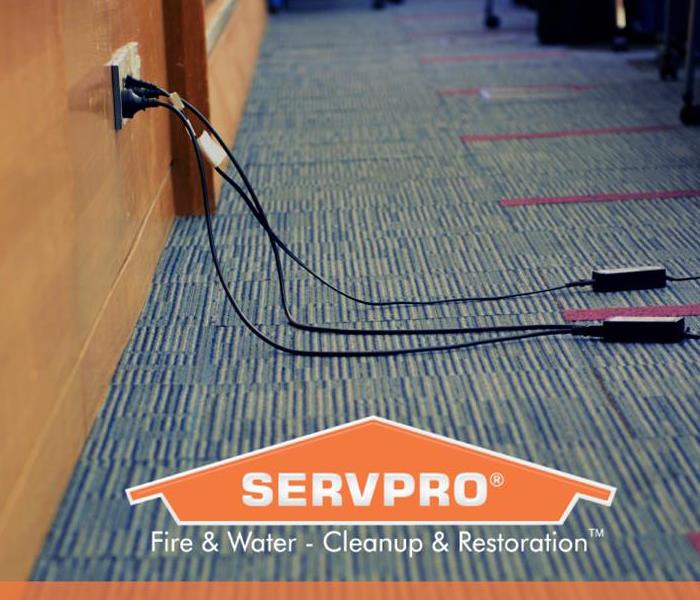 Let the trained professionals help today!
Let the trained professionals help today!
Fires caused by electronics are on the rise in household across the country. More and more homes are investing in various types of electronics, all in need of charging at one point or another, and often left unattended while they’re charging.
While there are basic safety habits that we should follow for these devices, most of us disregard these habits and put our homes at risk. When a house fire caused by electronics occurs, and the recovery process can be tough.
Preventing a house fire from electronics
Computer, tablets, and cell phone chargers need space for air circulation, as they put off a substantial amount of heat during charging cycles which must be dispersed with the right amount of ventilation.
Unfortunately, it’s not uncommon for people to put these chargers by their beds, surrounded by flammable items which can cause significant heat. Devices that are covered up and not able to “breathe” can build up the heat and ignite a fire; often when no one is home to quickly extinguish the flames or asleep and unaware a fire has started.
The lithium-ion batteries in these devices have containers that are pressurized and can rupture if the temperature goes up too fast or melt if they are heated for a long time. Many people think electronics fires are caused by faulty chargers, but these fires can happen when devices are on a charger or not.
Following basic safety rules can protect your home from a house fire. Fire damage in your home from your electronic devices are almost entirely avoidable with a little diligence in following safety rules. Not charging your phone in or by your bed, and making sure all devices are on a hard, flat surface while charging helps avoid these disasters. Also keeping any charging electronic uncovered to allow for proper air circulation helps with overheating and potential fire damage.
If you experience an electronics fire
If you experience fire from an overheated cell phone, tablet, or other devices, there’s additional clean-up to face once the flames are extinguished.
It’s best to leave the cleanup to the professionals at SERVPRO of Carrollton Texas. SERVPRO has the training to know how to clean up your home after a fire of any kind and understand the special challenges of fires caused by electronics.
When electronics burn, they emit particles like those from burning plastics which become electrically charged are known as ionization. The particles can adhere to surfaces and can be a challenge to clean. At SERVPRO, we understand that because of this, clean up after an electronics fire takes special care to not only get rid of the smoke particles but to eliminate the acrid smell that accompanies burned plastics. Our highly trained technicians use advanced technology to clean your home, removed the damaged electronics, and address any odor issues to restore your home to pre-fire conditions. When a SERVPRO technician arrives on the scene, they’ll do a comprehensive job evaluating the situation, providing you with a clear plan ahead of time so you know exactly what to expect.
If you need assistance with fire damage in your home, please call us at 972-446-0383.
Five Wood-Burning Fireplace Safety Tips for Carrollton, TX, Homeowners
3/24/2021 (Permalink)
Blog Summary: SERVPRO of Carrollton offers tips on wood-burning fireplace safety.
SERVPRO of Carrollton, TX, specializes in the cleanup and restoration of residential and commercial properties after fire damage, smoke damage, or water damage. By utilizing the most advanced technology and equipment available, SERVPRO technicians provide restoration services that bring customers peace of mind.
Cold Snap Breaks the Electrical Power Grid
About every ten years, a cold snap sweeps over Texas and causes significant property damage and physical hardship. Such was the case this past February. According to one news source, "Beginning around 11:00 p.m. Sunday night, February 14, 2021, multiple generating units began tripping off-line in rapid progression due to the severe cold weather."
Millions of Texans in the Dallas/Fort Worth area were left without power for many days and were forced to rely on backup systems for heating, including wood-burning stoves.
Wood Burning Stove Safety Tips
These vitally important wood-burning stove safety tips can save homes from fire damage and prevent loss of life. The goal is to achieve optimal safety, economy, efficiency, and environmental responsibility.
Tip #1: Stockpile the well-seasoned wood.
Using the right wood can save time and money. Use softwoods to get the fire going and generate quick heat that will ignite the hardwoods. Kindling, usually a soft heart pine or dry sticks, works well to get the more efficient, longer-burning, and cleaner-burning hardwoods burning. These hardwoods yield a consistent warmth that lasts for many hours.
Tip #2: Inspect the stove annually.
During longer cold streaks when the stove is in use for days or weeks without interruption, keep a vigilant eye on the entire system. Check door seals, gaskets, pipes, and the chimney at the beginning of the cold season. Give the system an inspection at the end of the season in case a late-season cold snap hits or Texas is visited with an early-season rush of winter cold prior to the annual inspection. Always keep flammable materials such as books, magazines, furniture, and decor at least three or more feet away from the wood-burning stove or fireplace.
Tip #3: Clean the chimney before a problem arises.
Schedule the services of a professional chimney sweep to eliminate creosote buildup before the situation reaches a critical point. Also, have the chimney professional clear out any obstructions that might inhibit airflow or ignite in the chimney. Birds, bats, and squirrels often use chimneys to provide shelter for nests. By installing a cap at the top of the chimney, debris can be prevented from blocking the chimney.
Tip #4: Install both a smoke and carbon monoxide detector and keep a fire extinguisher handy.
Fires from sparks, puff back, and carbon monoxide are hazards associated with wood burning stoves and fireplaces. Smoke and carbon monoxide detectors should be deployed near wood-burning units, in hallways, at the top of stairs, and at other key locations to ensure that a proper warning is deployed when dangerous situations arise. Annually inspect each unit to ensure the batteries work. The first day of fall, September 21, is an optimal time for this inspection. The cooler temperatures provide a subtle hint that it is time to inspect the detectors, the chimney, the wood-burning stove, the stockpile of wood, and the emergency escape plan in case of fire.
A fire extinguisher can be discreetly stored at the ready in case the stove or fireplace causes a fire. As with the smoke detection units, inspect fire extinguishers annually to ensure they are charged and ready for use.
Tip #5: Practice common sense fire safety.
By observing some simple, common-sense fire building safety practices, homeowners can stay warm and cozy, even when the power goes out for several days.
- Remove debris and ashes from previous fires.
- Remember to open the damper before starting a new fire.
- Stockpile plenty of kindling. Never use gasoline, kerosene, or charcoal lighter fluid to start a fire in a wood-burning stove or fireplace. Do not burn treated lumber or painted wood.
- Never burn garbage in a wood stove or fireplace. The results could be explosive. Toxic fumes and residue from plastics create health hazards and can damage the stove.
- Use appropriate fireplace tools to manage the fire.
- Avoid using logs that are too large for the woodstove. Do not overfill the stove with kindling or logs.
- Always observe the manufacturer’s guidelines for the product.
- Keep children and pets a safe distance away from the stove.
- Put ashes in a metal container. The lid should fit snugly to keep out air. Store the container a safe distance from the house.
By following these safety tips, homeowners can use their wood-burning stoves safely and stay warm and cozy during the cold winter months.
The caring team of highly trained SERVPRO professionals offers twenty-four-hour emergency service. Locally owned and operated and utilizing advanced restoration and cleaning equipment, SERVPRO of Carrollton is a trusted leader in the damage restoration industry.
To learn more about fire damage restoration in Carrollton, TX, call SERVPRO of Carrollton at (972) 446-0383 or email office@SERVPRO10952.com.
What should you do if a fire starts at your office?
2/3/2021 (Permalink)
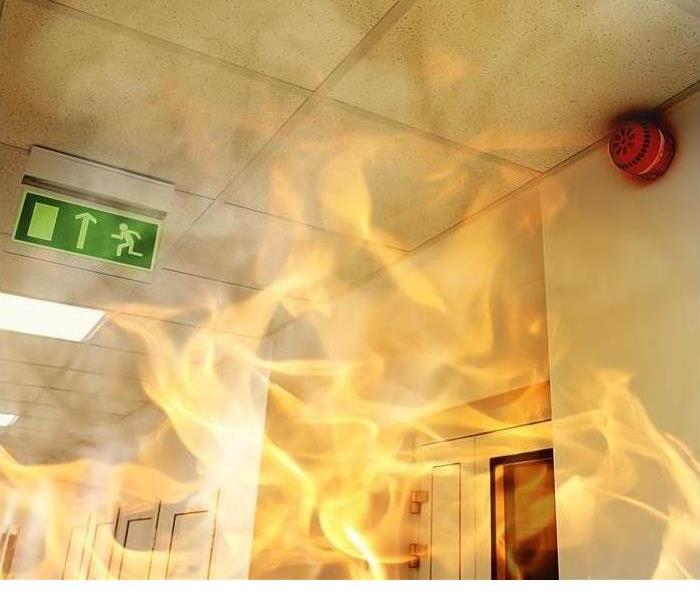 Do you have a plan?
Do you have a plan?
Making sure fire extinguishers are accessible and smoke alarms are maintained are crucial steps to take as an employer. If a fire does erupt in your workplace, it’s natural for people to panic. Unfortunately, this can lead to common mistakes that aggravate the situation. To ensure everyone makes it out of the building safely during an emergency, here are a few safety guidelines to remind your staff of during fire training.
What Not to Do During a Workplace Fire
- Break Windows
Smoke inhalation is a threat to those inside the building. In an effort to access fresh air, some people might open windows or break the glass. However, when oxygenated air from outside rushes in, the intensity of the fire will build more quickly.
As smoke and heat rise, everyone should stay close to the ground and crawl to the exits to avoid fumes. If exits are blocked, put wet towels under the doors to keep out the smoke instead of opening windows.
- Fail to Use Emergency Exits
fire extinguishers. When a fire starts, people might try to evacuate the building the same way they got in. However, you shouldn’t open any doors leading to the main corridors, especially if the handles are warm to the touch. Flames could be on the other side of these, and opening them could feed more oxygen to the fire and expose people to smoke.
To keep the fire from spreading, instruct your staff to use only emergency exit doors, stairwells, and fire escapes.
- Forget to Alert Others
When they hear the fire alarm protection system, some people may think it’s just a test. If they don’t smell smoke or feel the heat, they might fail to take action.
To protect everyone in the workplace, people who see the flames or smoke should yell “fire” to alert others that it is not a drill. Those trained to use fire extinguishers can try to control the blaze while others call emergency services for help. If anyone in the workplace has mobility difficulties, assign someone to ensure they can get out safely during your safety plan design.
To ensure your staff is prepared for any emergency situation, reach out to SERVPRO of Carrollton. We have been helping many commercial customers set up Emergency Ready Plans.
We can help you as well! Call 972-446-0383 for your free commercial ERP today.
How Proper Fire Safety Practices Can Prevent Wood Stove Fires
1/25/2021 (Permalink)
Blog Summary: SERVPRO of Carrollton shares wood stove fire safety tips that help prevent fire damage in the home.
This winter, SERVPRO of Carrollton is sharing wood stove fire safety tips to help homeowners stay safe and warm while minimizing the risk of fire damage. In their efforts to stay cozy this winter without breaking the bank, homeowners are supplementing their central heating system with alternative methods of heating, including fireplaces, pellet stoves, or wood stoves. The COVID-19 pandemic has sent tens of millions of workers and students home for the winter, increasing the need to keep the home warmer during the day. In past years, many homeowners would keep the temperature of the house much cooler when the house was unoccupied during the day. Now, many homes are occupied 24/7. By utilizing an alternate heat source such as a wood stove, remote workers and students can stay warm at an affordable cost.
Any alternative heat source requires regularly scheduled maintenance and upkeep for ongoing operation and continued safety. SERVPRO of Carrollton examines the types of wood stoves and shares wood stove fire safety tips to help homeowners stay safe and warm this winter.
Types of Wood Stoves
Because of their efficiency at producing heat, wood stoves are great supplemental heat sources, even better than most fireplaces. Wood stoves fall into the following two general categories: freestanding or a wood stove insert.
A wood stove insert fits in the fireplace opening and vents smoke, sparks, and excess heat through the chimney. Many models are equipped with an electric blower to circulate heat into the area around the stove.
A freestanding wood stove stands alone in a room and connects to the chimney through a chimney connector. Sometimes wood-burning stoves may share the flue of an existing fireplace. Other stoves may vent into a separate chimney constructed to handle the smoke, sparks, and excess heat from the stove.
Using the Wood Stove
Before using the wood stove, have the chimney inspected by a certified professional chimney sweep to determine if the existing chimney can be used with a wood stove. A wood stove generates intense heat and combustion gases. The chimney should be made from masonry and lined with flue tiles in good condition.
Freestanding wood stoves should be positioned as close to the chimney as possible. The reason is to limit the length of the flue pipe (or chimney connector). The flue may become very hot. When determining the location where the stove will be installed, make sure that both the stove and the chimney connector are easy to access for inspection and cleaning.
If purchasing a home that comes with a wood stove, an inspection is recommended to confirm the safety of the unit and venting system. A certified chimney sweep should be able to provide operating instructions for the stove model. Make sure the wood-burning stove conforms to modern performance and safety standards and is listed by Underwriters Laboratories or other reputable testing organizations.
A freestanding wood stove should be installed only on a fire-resistant surface or pad. Do not connect the vent to a chimney flue that also serves a furnace, boiler, or other wood stoves. Carbon monoxide poisoning or a fire could result.
Wood Stove Safety Tips
A wood stove can provide amazing comfort and savings. These wood stove fire safety tips will help prevent risks such as fire damage, burns, or carbon monoxide poisoning.
Tip #1. Keep children and pets away when a fire is burning in the stove. The stove’s exterior and flue pipe become very hot.
Tip #2. Keep combustibles at least three feet away from the stove.
Tip #3. Install and regularly maintain working carbon monoxide alarms and smoke alarms in the home. Locate smoke detectors and carbon monoxide detectors outside each bedroom and on every level of the home.
Tip #4. Remove ashes frequently. Properly dispose of them since ashes can take several days to completely cool. Place ashes in a covered metal container, and keep the ash container at least ten feet away from structures and vehicles.
Tip #5. Schedule an annual chimney and wood stove inspection with a certified chimney sweep who is competent to deal with wood stoves. Schedule another inspection halfway through the burning season to check for creosote buildup or defects that might have developed through the season.
Tip #6. Do not “over fire” the stove. Building a fire that exceeds the rating of the stove can result in flames entering the flue pipe or chimney, which can lead to a fire. Over firing the wood stove can damage the unit and create a fire hazard.
Tip #7. To avoid over firing, check the instruction manual or check with the manufacturer.
Tip #8. Only burn well-seasoned hardwoods in a wood stove. Coal, rubber, garbage, plastics, or other non-wood combustibles can damage a stove. Aerosol cans may explode or give off toxic, hazardous fumes.
A wood stove is a fantastic supplement to an existing HVAC system. Proper safety practices and regular maintenance will keep a home warm and comfortable throughout the winter season. In case of puff back, fire damage, or water damage from extinguishing a fire, SERVPRO of Carrollton can be on the scene in about an hour to begin the fire damage restoration, smoke damage restoration, or water damage restoration process. The team understands the stress caused by the disruption, chaos, and messes that come from a property damage disaster. SERVPRO of Carrollton will manage the entire cleanup and restoration process, including providing a free estimate and handling all insurance claims.
For more information about fire damage restoration in Carrollton, TX, contact the office by phone at (972) 446-0383 or by email at office@SERVPRO10952.com.
How to avoid Furnace Fires-in Far North Dallas!
12/27/2020 (Permalink)
About 62 million houses in the U.S. use natural gas furnaces for heat. Other houses use wood furnaces, and a proud few still burn coal. These suggestions focus on gas furnaces, but it’s important to perform preventive maintenance on any type of furnace.
Clean-Up Time
Clean around the furnace. Do a quick clean-up, making sure no insulation, paper, boxes or anything else is stored within three feet of the furnace.
Clean the furnace itself. Dirt can cause motor overheating, and it can prevent you from seeing problems with wiring or other issues.
Look at Your Air Filter
Is your air filter clean? Dirty air filters can reduce air flow and lead to overheating, increasing the chances of fire.
Check Chimney Flues and Outside Vents
Check for buildup inside the vents, as well as outside obstructions such as birds’ nests.
Is Your Smoke Alarm Working?
It’s a good time to check both your smoke and CO alarms. If you don’t have them—get them.
For Some Things, You Need a Professional
Every year, it’s a good idea to have your furnace serviced by a professional. They can check for items such as a cracked heat exchanger, incorrect pressure in the furnace and even flame color, which can indicate how well your furnace is functioning. If you haven’t had your furnace serviced lately, this is a good time to make an appointment.
If your home has suffered fire damage, SERVPRO of Carrollton, Texas can help. Our agents are on call around the clock so we can start helping you get back to normal, fast. Contact us at any hour for assistance.
How to Decide Between Various Fire Damage Restoration Provider
11/12/2020 (Permalink)
Blog Summary: With so many fire restoration companies to choose from, a property owner may need assistance in determining which one is best for their needs. Learn how to find a restoration company and select the best one with this helpful guide.
How to Choose Between Various Fire Restoration Companies
Fires are devastating events that can cause extensive damage to property and personal belongings. The fire is not the only source of damage since fire systems and the water firefighters use to put out the flames will also contribute to the property loss.
There are plenty of fire restoration companies available to help you restore your property, but with so many options available, selecting the right one can be overwhelming. Here are some crucial tips to consider before you hire a restoration company.
Types of Damage Restoration
Burst pipes, overflowing plumbing fixtures and appliances, firefighting efforts, and extreme weather events cause water damage and require flood cleanup. If the property owner does not quickly address the issue – within 24 to 48 hours – they increase the risk of hazardous mold growth, property loss, and expensive repairs and replacements. A typical fire restoration service includes water removal, cleaning, and sanitizing.
Fire damage can occur from natural or man-made situations, such as a wildfire or grease fire. Even if the flames do not touch your belongings, the smoke can ruin them. A fire damage restoration service will identify which items and materials need replacements or repairs.
How to Find Fire Restoration Companies
Although the fire may cause irreparable damage to personal belongings like photographs or sentimental trinkets, fire restoration companies will work diligently to bring your property back to its original condition.
Here is how to locate these companies:
- By Asking Friends, Neighbors, and Family: Unfortunately, fires are not uncommon, and you may know someone who has used fire restoration services. Ask people you know, including friends, relatives, and neighbors, if they worked with a fire restoration company, and if so, see what they thought of the experience. Asking around will help you narrow down companies that may meet your needs, as well as show you which ones to avoid.
- Contact Your Insurance Company: As a property owner, you must contact your insurance company soon after the fire is under control or eliminated. Your insurance provider may have a list of fire restoration companies they work within your area. Your insurer will vet these restoration businesses, so you won’t have to spend time researching their services.
Tips for Selecting the Right Fire Restoration Company
Before you agree to hire a fire restoration company, ask these questions to ensure they are the right service for the job.
1. What types of restoration services do you offer?
Reputable fire restoration companies have a list of essential services to ensure a safe and efficient restoration process. These services include smoke and soot cleanup, odor removal, water cleanup, and damage assessments. Additional building restoration services include air duct cleaning service and commercial water damage restoration.
2. Do you provide a board-up service?
Fires can severely impact a building’s structural integrity, affecting its floors, windows, ceilings, and foundation. By boarding up vulnerable areas, workers can safely proceed with restoration efforts and protect the building from trespassers, weather, and additional damages.
3. What are your company’s certifications?
Any company you hire should have the appropriate certifications and licenses required to do restoration work in their respective states and cities. Check for fire and water damage training credentials and documentation from the Institute of Inspection, Cleaning, and Restoration Certification (IICRC). This organization offers certification in various specialties, including mold removal and commercial drying.
Why SERVPRO of Carrollton?
As fire and water damage experts, the professionals at SERVPRO of Carrollton, Texas, will work quickly to restore your property to a livable condition using the latest restoration techniques and specialized equipment. Their services will help you reduce your property loss, and the team’s professionalism and knowledge will alleviate stress about the restoration process.
To learn more about this fire restoration company, contact the SERVPRO of Carrollton team today.
Tips for Fire Safety Ahead of the Holiday Season | SERVPRO of Carrollton
11/12/2020 (Permalink)
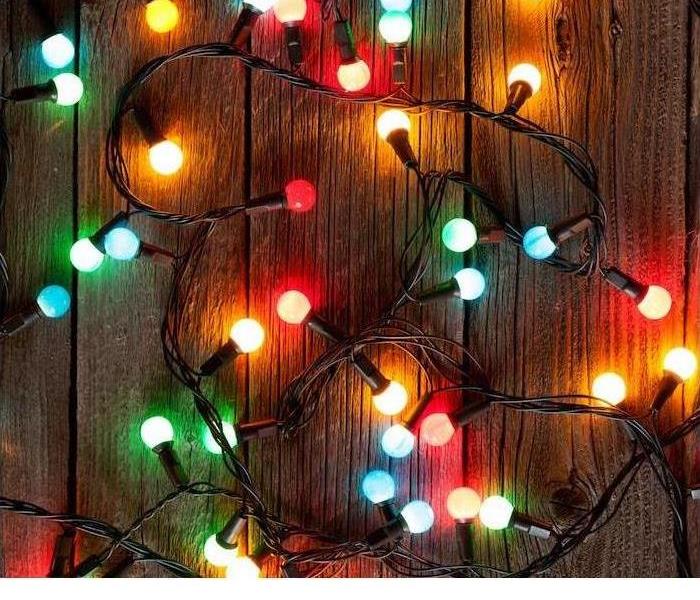 We are here to help!
We are here to help!
As the weather turns cooler and we prepare for the fast-approaching holiday season, there are many things to keep in mind. While gift guides and recipes are aplenty, it is important to keep fire safety at the forefront of everything you do this season.
It has been found that house fires peak in the wintertime, simply because most winter activities give them more of an opportunity to occur.
These risks should not keep you from participating in winter fun, however—it is just important to go about your cooking, heating and decorating safely so you do not accidentally become a victim of a house fire yourself.
Fire Safety Tips for Wintertime
Keep safe when cooking. Cooking is consistently one of the top causes of fires in the home, and because more people tend to cook large meals and participate in holiday baking, these types of fires often increase during the winter. Every time you cook, be certain to keep flammable objects away from the stove, make sure a fire extinguisher is handy and keep at least three feet around the stove clear of all other people, children and pets.
Heat the house with proper precautions. Another winter-specific hazard comes from space heaters and fireplaces being used to warm up the home. While you can use both of these tools safely, it is important to take the proper precautions every single time. Ensure you are using a space heater that is equipped with modern safety features such as a tip-over and overheating system, never use them with an extension cord and keep them a good distance from anything flammable. For fireplaces, be sure to do proper chimney maintenance and never leave a fire burning unattended.
Decorate with care. As households add Christmas trees, holiday lighting and other decorations to their home, electrical circuits can easily become overloaded and spark. Overloading electrical outlets and power strips is responsible for around 25% of Christmas tree fires every year. As you decorate, be sure to space out where you are plugging things in, avoid using any decorations with frayed wiring and always unplug everything before leaving the house or going to sleep.
If you have damage due to a house fire, you can depend on us to help. Contact us 24 hours a day to report damage and receive a quick response from our certified restoration technicians. Get in touch today.
Train your office staff on how to properly use a fire extinguisher.
10/22/2020 (Permalink)
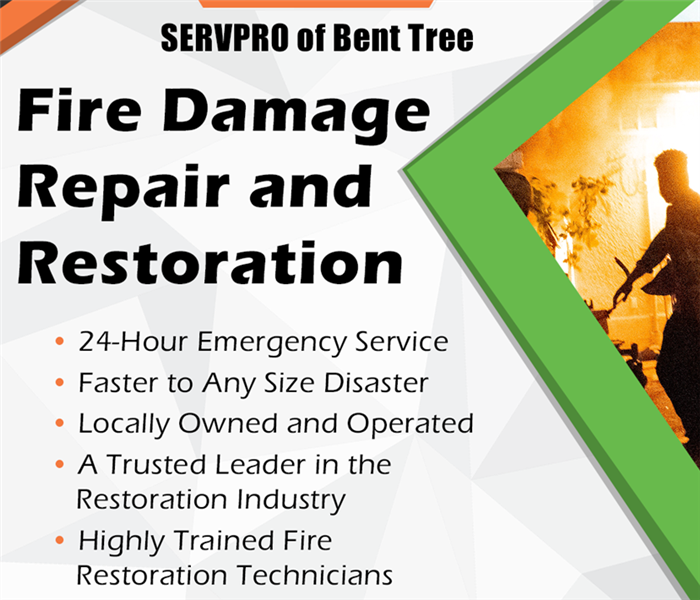 #heretohelp
#heretohelp
Fire Extinguisher Tips for your business.
Designating employees to become educated on fire extinguisher use may help protect property and life. Occupational Safety and Health Administration (OSHA) provides an online training video to help familiarize you with proper use of extinguishers, but they remind you that it is supplemental and does not replace hands-on training. Fires are classified by the type of material burning and extinguishers are clearly labeled for their use:
• Class A. Items in this category include paper, some plastics, and wood. Since this class uses water, you would not use this extinguisher on any flammable liquid fires, oil, combustible metals, or electrical fire.
• Class B. These are suitable for flammable liquid fires, like those from solvents, gasoline, and oil.
• Class C. When electrical equipment is involved in the fire, you need a Class C extinguisher.
• Class D. A specialty class for metals like potassium, magnesium, and sodium. These metals react with the oxygen in water and combust dramatically.
• Class K. These are especially designed for a kitchen fire from oil and grease.
• CO2 Extinguishers. Effective for Class B and Class C fires.
Be safe when using portable extinguishers. Many extinguishers are rated for multiple classes of fires but using the wrong class of fire extinguisher can cause a fire to spread or react explosively. A good example of this is spreading a grease fire by using water. When using a CO2 fire extinguisher, take extra care to protect your hands from the super cooled nozzle, which can cause frostbite, and use only in a well-ventilated area to prevent too much loss of oxygen for your safety. Be sure only to use portable extinguishers on fires that have just started, not large fires.
After fire damage to your building in North Dallas, TX, you may not be sure how to begin the cleanup process effectively. Fortunately, a professional fire mitigation company is knowledgeable and efficient at handling all the details. One company to help with your recovery and restoration will save you a lot of trouble and get everyone back to work in a timely manner. For more information, call 972-446-0383.
Carrollton Property Damage Restoration Company Promotes Fireworks Safety
6/30/2020 (Permalink)
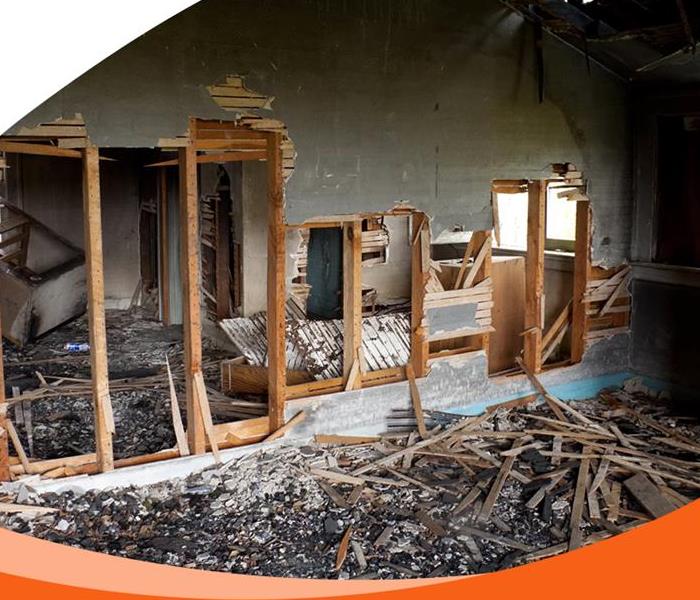 Here to Help
Here to Help
Summary: SERVPRO of Carrollton shares fireworks safety tips from the Texas Department of Insurance.
People love to celebrate with fireworks, especially on the Fourth of July. SERVPRO of Carrollton, a Texas damage restoration company, urges residents of Carrollton, TX and the greater Dallas/Fort Worth area to celebrate this Independence Day safely. The first use of fireworks in a Fourth of July celebration was in Boston, MA, in 1777. Founding father, John Adams said he hoped the anniversary of independence would be remembered for years to come by “guns” and “bonfires” and “illuminations.” Since the first July 4 fireworks display took place during the Revolutionary War, some historians think the fireworks were intended as a “morale booster.” The celebrations at the time would have also included the firing of guns and cannons, adding to the explosive nature of the festivities.
Texans love to celebrate the 4th of July with fireworks too! Fireworks are legal in Texas, but counties and cities are allowed to set guidelines. Fireworks are generally not permitted within city limits. Some cities extend the ban as much as 5,000 feet beyond the city limits. Special permits are required for fireworks displays for over 50 people.
The National Fire Protection Association offers these fireworks fire & injury facts. “Fireworks started an estimated 19,500 fires in 2018, including 1,900 structure fires, 500 vehicle fires, and 17,100 outside and other fires. These fires caused five deaths, 46 civilian injuries, and $105 million in direct property damage. In 2018, U.S. hospital emergency rooms treated an estimated 9,100 people for fireworks-related injuries; half of those injuries were to the extremities and 34% were to the eye or other parts of the head. Children younger than 15 years of age accounted for more than one-third (36%) of the estimated 2018 injuries.”
How to Stay Safe When Using Fireworks
While fireworks are a fixture of many holiday celebrations, these explosives have an inherent element of danger. The Texas Department of Insurance offers the following fireworks safety tips to help people have fun with fireworks and stay safe.
- Follow local mandates.
Some towns allow only certain types of fireworks, and most areas do not allow fireworks within city limits or during burn bans. Follow the local law and contact the local fire officials if there are any questions.
- Find out if a permit is required.
Organizers will need a permit from the local fire department if they are holding a fireworks show for a group of 50 people or larger.
- Hire licensed professionals.
If someone is hired to put on a display for a group, the group organizers need to confirm that the individual has a Texas pyrotechnic operator’s license. To find out if someone is licensed to shoot off fireworks, contact the State Fire Marshal’s Office at 1-800-578-4677 or Fire.Marshal@tdi.texas.gov.
- Check to see if fireworks are legal in the area.
Fireworks can be sold only at certain times of the year, typically during a week or so leading up to a major holiday. Besides the Fourth of July and New Year’s, Texas counties have the option to include Texas Independence Day (March 2), San Jacinto Day (April 21), Cinco de Mayo (May 5), and Memorial Day.
Anyone can use fireworks any day of the year as long as they are not banned in the area where they are being used.
- Stay safe!
- Children should not use fireworks, and an adult should always be present when children are near a fireworks display.
- Alcohol and fireworks are a recipe for an emergency room trip.
- Always follow the firework instructions exactly.
- Never shoot fireworks around dry grass, brush, or other flammable materials.
- Never aim fireworks at a home, animal, or person.
- Keep a bucket of water, garden hose, or another water source nearby for emergencies.
Fire and Water Damage Specialists
When a home or business is dealing with the aftermath of a fire, the damage that it can cause to the property structure and valuable possessions can be extremely devastating. At SERVPRO of Carrollton, the team understands the stress, confusion, and emotions that are present when dealing with this kind of ordeal. The SERVPRO technicians are highly skilled and certified, as well as equipped with fire damage restoration equipment to take special care of the client’s property and possessions. The team will be there with the customer every step along the way to explain the process to help get them through this stressful time.
SERVPRO of Carrollton Fire Damage Restoration Services
Since each smoke and fire damage situation is a little different, each one requires a unique solution tailored for the specific conditions. When various materials burn, the soot and residue they create differ greatly and require a specific cleaning procedure. The steps listed below illustrate the process for the typical fire damage restoration.
- Emergency Contact
- Inspection and Fire Damage Assessment
- Immediate Board-Up and Roof-Tarp Service (if needed)
- Water Removal and Drying (if water damage is present)
- Removal of Smoke and Soot from All Surfaces
- Cleaning and Repair
- Restoration
Conclusion
Texans have much to celebrate, and fireworks are often a part of these celebrations. Following safety tips make for safer celebrations. When a homeowner or business experiences fire and water damage, the repair and restoration experts at SERVPRO of Carrollton are available 24/7 with the knowledge, expertise, training, and equipment to restore the structure to its condition before the fire and water damage.
To learn more about the full line of fire and water damage restoration services, visit the SERVPRO of Carrollton website at https://www.SERVPROcarrolltontx.com. Contact a representative from SERVPRO of Carrollton by phone at (972) 446-0383.
Important information to know if you have a fire at your home or office.
6/26/2020 (Permalink)
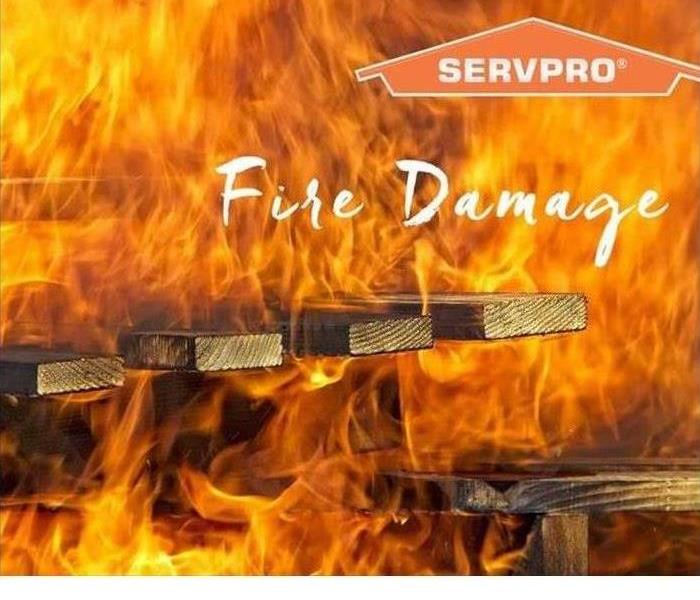 Fire Damage can spread Quickly.
Fire Damage can spread Quickly.
Smoke and soot facts:
- Hot smoke migrates to cooler areas and upper levels of a structure.
- Smoke flows around plumbing systems, seeping through the holes used by pipes to go from floor to floor.
- The type of smoke may greatly affect the restoration process.
Different Types of Smoke
There are two different types of smoke–wet and dry. As a result, there are different types of soot residue after a fire. Before restoration begins, SERVPRO of Carrollton will test the soot to determine which type of smoke damage occurred. The cleaning procedures will then be based on the information identified during pretesting. Here is some additional information:
Wet Smoke – Plastic and Rubber
- Low heat, smoldering, pungent odor, sticky, smeary. Smoke webs are more difficult to clean.
Dry Smoke – Paper and Wood
- Fast burning, high temperatures, heat rises therefore smoke rises.
Protein Fire Residue – Produced by evaporation of material rather than from a fire
- Virtually invisible, discolors paints and varnishes, extreme pungent odor.
Our Fire Damage Restoration Services
Since each smoke and fire damage situation is a little different, each one requires a unique solution tailored for the specific conditions. We have the equipment, expertise, and experience to restore your fire and smoke damage. We will also treat your family with empathy and respect and your property with care.
Have Questions about Fire, Smoke, or Soot Damage?
Call Us Today – 972-446-0383
Fire Safety during COVID-19.
5/29/2020 (Permalink)
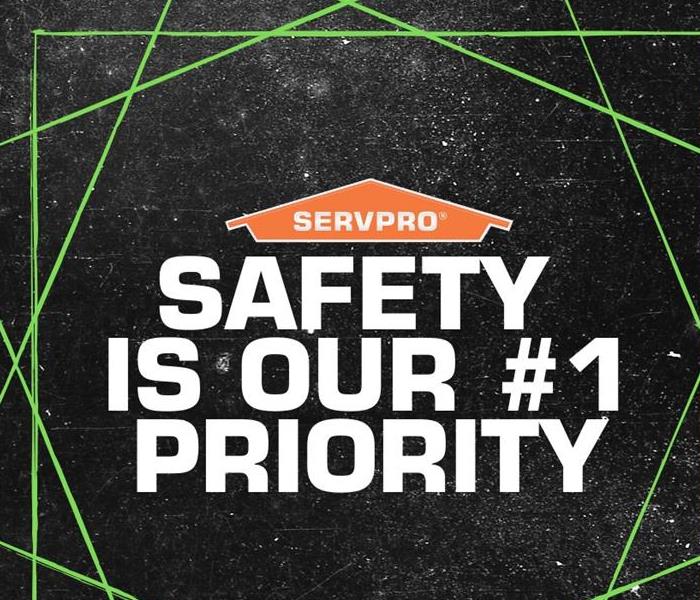 Here to Help!
Here to Help!
We hope that you are staying safe and healthy while we continue with social distancing. With most Texans at home during this time, we hope that you are also cautious of home fire safety. According to the National Fire Protection Act (NFPA), the leading year-round causes of home fires are:
- Cooking
- Heating
- Electrical equipment
Because people are spending more time at home, they are engaging in activities that add to the home fire problem. It’s important to recognize what the potential hazards are and how to prevent them. Preventing fires during this uncertain time will help keep everyone safe and prevent thousands of dollars in fire damage.
Biggest Causes of Home Fires
Cooking is the leading cause of home fires in Dallas/ Fort Worth area. It is responsible for nearly half of all reported home fires, with unattended cooking as the leading cause of home cooking fires. So, if you are not keeping a close eye on what you’re cooking, you are more likely to have a home fire.
With COVID-19, there’s a high risk for distracted cooking since many households are now dealing with out-of-the-ordinary circumstances. For example, the kids are out of school and the parents are working from home.
The second highest cause of home fires is heating equipment, causing an average of 52,050 home fires each year. Heating systems are still in use in a large part of the country this time of year. Since most people are at home, these heating systems are being used for more hours than usual.
Finally, electrical outlets are the third-highest cause for home fires. Now that many people working and schooling from home, there is the likelihood of many individuals using the same outlets to charge:
- Phones
- Laptops
- Other digital equipment
Tips to Keep in Mind
The NFPA recommends that you use best fire practices during the COVID-19 pandemic and beyond:
Cooking and Grilling Outdoors
- Stay in the kitchen when cooking. Turn off the stove or other cooking appliances if you leave the kitchen for any amount of time
- Use a timer so you don’t forget that you have something on the stove or in the oven
- Keep anything that can catch fire away from the stovetop
- Be sure the smoke detector near the kitchen is working properly
- Turn all handles inward so that someone can’t accidentally tip over a hot pan
- Refrain from cooking if you are tired or not feeling well
- Have a “kid-free zone” of at least three-feet around the stove or grill
- Grill outside and away from any structures. …
- Make sure your grill is stable and clean
- Do not wear loose fitting clothing
Electrical
- Charge phones and other digital devices with the appropriate cords
- When charging digital devices, do not cover them with a pillow or charge on flammable surfaces such as the bed or couch.
- Don't overload outlets, especially with appliances that produce heat, such as coffee-makers or toasters
- Plug major appliances directly into a dedicated wall outlet
- Never string electrical cords across doorways or under carpets
- Use a light bulb with the correct number of watts.
- Smoke alarms should be located on every level of the home and near/in bedrooms
- Test your smoke alarms every month to ensure they’re working
- Develop and practice a home escape plan so everyone knows what to do in a fire.
SERVPRO of Carrollton remains committed to supporting you as we navigate the evolving situation with COVID-19. We want to provide you with the resources you need to minimize your risk and help prevent losses and injuries. Please call us immediately for any questions and concerns you have about COVID-19 or if your property suffers from fire and water damage.
972-446-0383
What is Fire Damage?
5/14/2020 (Permalink)
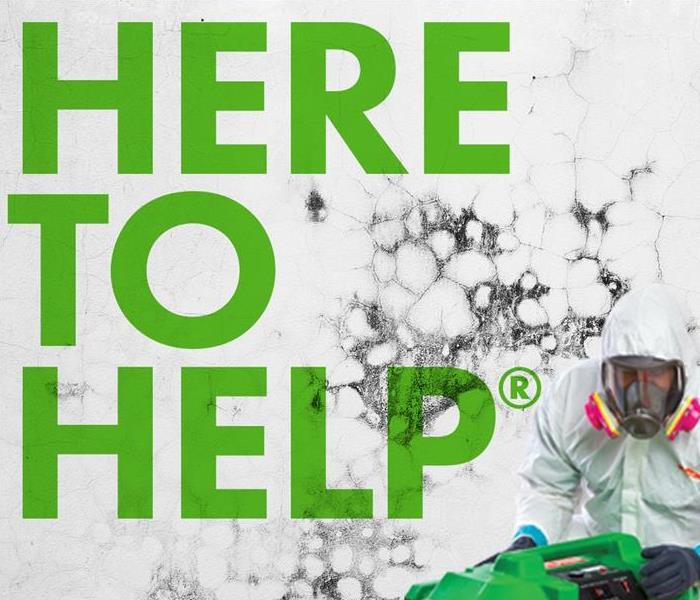 Our technicians are here to help!
Our technicians are here to help!
Fire damage refers to the physical damage to a property as a result of burning. This damage may either be directly caused by the flames or could occur due to smoke and other corrosive substances emitted by the fire.
In terms of insurance, fire damage is one of the types of coverage offered in property insurance.
The six types of fire damage are as follows:
- Class A: fire that involves flammable solids, such as paper, cloth, wood, and plastics.
- Class B: fire that involves flammable liquids or solids that can turn into liquids.
- Class C: fire that involves flammable gasses, such as propane, hydrogen, natural gas, and butane.
- Class D: fire that involves combustible metals, including sodium, magnesium, and potassium.
- Class E: fire that involves factors in Class A and B as well as electrical elements.
- Class F: relatively hotter and more destructive fire that involves cooking oils and fats.
Furthermore, many insurance companies divide fire damage into two categories: primary and secondary. The former refers to damage caused by the flames, while the latter refers to damage caused by smoke or other substances from the fire.
If you are interested in having one of our fire damage professionals take a look at your property after a fire, please give SERVPRO a call today at 972-446-0383.
Tips to Survive a House Fire
4/23/2020 (Permalink)
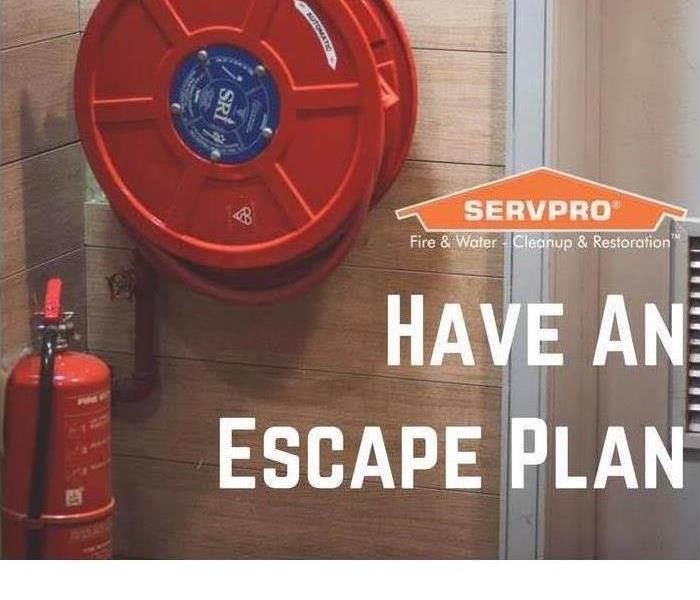 Be prepared.
Be prepared.
Residential fires are the worst because they affect the whole family. A house fire breaks out every eighty-six seconds, and seconds are all the occupants have to escape a growing fire. The Underwriters Laboratories, which conducts state-of-the-art fire safety testing, says three minutes or less is the time window to escape a house fire.
The National Fire Protection Association noted that in 2018, there were 363,000 house fires. That same year saw 3,655 fatalities resulting from all structural fires. Of these 3,655 fire fatalities, 2,720 or 74% of all fire deaths occurred in the home.
Fire safety statistics show that “Every day, at least one child dies from a home fire and another 293 children are injured from fires or burns. Ninety percent of all fire-related deaths are due to home fires. Home fires can spread rapidly and leave families as little as two minutes to escape after an alarm sounds. Children under 5 years of age are at the greatest risk from home fire death and injury; their death rate is nearly twice the national average. Each year, nearly 488 children ages 14 and under die in home fires, and another 116,600 children are injured from a fire/burn related incident.”
The American Veterinary Medical Association (AVMA) reports, “About 40,000 pets die in residential fires each year, most from smoke inhalation, and 500,000 pets are affected overall.” Pet owners should also be aware that pets cause about 1,000 house fires a year.
Plan to Protect Loved Ones
Having a Fire Escape Plan is a necessity for everyone who lives in a house or an apartment, especially if children or older adults are present. According to the American Red Cross, only 26% of Americans have a fire escape plan, and young children and older adults are twice as likely to perish in a house fire as the general population.
Ten Tips to Survive a House Fire
- Create a Fire Escape Plan
Write down a formal escape plan. Clearly describe evacuation routes, exits, and the meetup location. Designate a fire escape leader. Give instructions on contacting the authorities for help. The National Fire Protection Association offers free resources to help create a detailed fire escape plan.
- Place Rope Ladders on the Upper Floors
If the home has upper floors or high windows, locate fire escape ladders at each window or upper-level deck. It is not necessary to have ladders dangling from each floor, but the durable, high-quality ladders should be ready to deploy if the downstairs is impassable.
- Invest in Several Fire Extinguishers
Purchase multiple fire extinguishers and locate them around the home in the major rooms. These rooms include the master bedroom, the kitchen, the living room, and the bathrooms. A fire extinguisher can put out a small fire before it grows out of control. It can also clear a pathway through existing flames, enabling an escape.
- Install and Test Smoke Alarms
Most homes already have smoke alarms. If smoke alarms are needed, install them immediately at every level and in each of the major rooms of the house. Test them monthly. Repair or replace defective units. The risk of dying in reported house fires is cut in half in homes with working smoke alarms.
- Test Doors for Heat Before Opening
A well-known tip for surviving a house fire is to check a door for heat before opening it. Is there any smoke filtering through the cracks between the door and the wall or floor? If not, still do not open the door. Next, feel the door for heat. If the door is warm or hot, do not open it. If the door is neither hot nor warm, cautiously open the door slightly and look for any signs of fire. If there are no signs of fire, it should be safe to exit through the door.
- Stay Low to the Ground
Stay low to the floor because the fresher air is near the floor. Hot air rises. The density of the smoke may require getting on hands and knees or even crawling out on one’s stomach. If the smoke is thick and low-hanging, exit as quickly as possible without being overcome by the fumes.
- Cover the Mouth and Nose with a Wet Rag or Shirt
In a house fire, smoke often presents the greatest danger. Many people having been overcome by the smoke have passed out and then been overcome by the flames. Cover the mouth and nose with a rag, towel, or piece of clothing. If the situation permits, soak the makeshift mask thoroughly. Staying low to the floor is effective, but the wet rag to the mouth and nose is better.
- Do Not Re-Enter the Home After Escaping
Once everyone has safely left the burning home, stay outside. Nothing is more valuable than a life. If someone is still in the house, leave it to the professional fire crew to handle the situation. Inform the fire crew of the missing person and hope and pray for the best.
- Place Emergency Kits Near the Exits
Make several kits with some extra clothing, cash, first aid supplies, important names and telephone numbers, or even a thumb drive loaded with essential files. If possible, store a kit in a place on the property but away from the residence. First responders will arrive and assess injuries, burns, or complications from smoke inhalation. Until they do arrive, the leader should check everyone for injuries, burns, and shock.
As an aside, taking a first aid course as a family would be an excellent activity that would not only enrich time together as a family but could also save lives.
- Practice, Practice, Practice
Practice drills that simulate a house fire or other emergency calling for swift evacuation are the best preparation. Thorough training and muscle memory will help overcome the most paralyzing fear. In a situation where seconds count, fear can lead to tragic consequences.
Conclusion
Surviving a house fire requires planning, training, and trust. If a house fire occurs, call the industry leaders in fire and water damage restoration. The team of highly trained professionals at SERVPRO of Carrollton is on call 24/7. They are fast to the scene. When a home or business is dealing with the aftermath of a fire, the damage and disruption can be devastating. At SERVPRO of Bent Tree, the team understands the stress, confusion, and emotions that accompany such an ordeal. The technicians are highly skilled and certified, as well as equipped with fire damage restoration equipment to take special care of the property and possessions. SERVPRO of Bent Tree walks with clients every step along the way to explain the process to help get through this stressful time.
For more information about fire damage restoration, contact SERVPRO of Carrollton by phone at (972) 386-3808 or email office@SERVPRO10952.com.
The Do's and Don'ts of Fire and Smoke Damage!
2/3/2020 (Permalink)
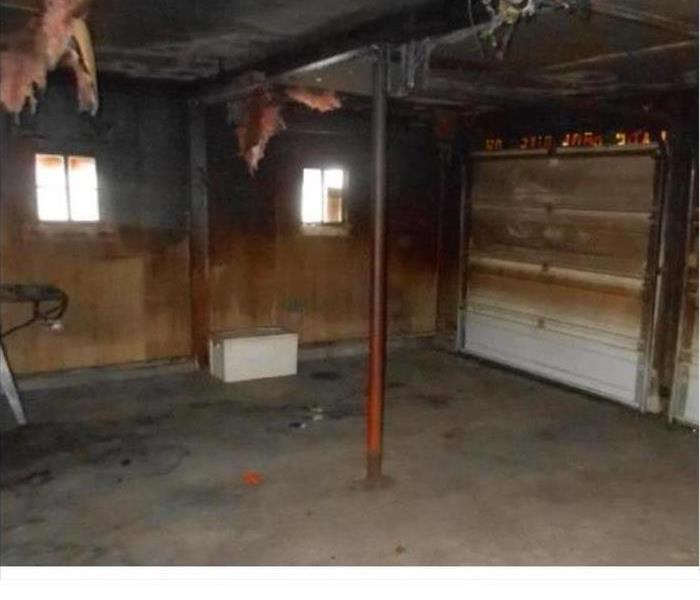 Seek Professional Assistance before entering a home that has Smoke and Fire Damage.
Seek Professional Assistance before entering a home that has Smoke and Fire Damage.
While fire damage restoration is better left in the hands of professionals, there are some things you can do on your own. Take note, however, that DIY fire restoration is something you want to do only when the severity of the fire and smoke damage is small.
Fire damage can be a devastating experience both for home and business owners. Fire damage is difficult to overcome and repair, but there are simple things you can do to motivate the process. When you’re wondering what to do after a fire, here’s a look at things to do (and things not to do) during the fire clean-up process.
HOW TO CLEAN SMOKE OFF WALLS AND CEILING
In the aftermath of a house fire, you might be tempted to start cleaning your home right away. However, take note that cleaning smoke damage, as well as fire damage, involves some health and safety precautions. Before getting started, call a fire marshal to know whether it is safe to enter your home.
Be sure to open doors and windows whenever possible to allow air to circulate when performing a fire and smoke cleaning project. Toxic fumes and chemical compounds from burnt objects can harm your health. Wear proper gear and clothing, including gloves and mask. Additionally, place a drop cloth, plastic sheet or tarp on the floor to prevent the soot stains from the ceilings.
The first step on smoke damage repair is to clean loose soot on the surface of the walls using a vacuum cleaner. Aside from using a vacuum, effective soot and smoke cleaner is a dry chemical sponge. Wipe the soot off the walls and ceilings. Trisodium Phosphate (TSP) is another effective cleaning solution. Add a tablespoon of TSP in gallon warm water. Using a sponge, wipe off the soot vigorously from your walls and ceilings. Alternately, you can mix a solution of white vinegar and warm water to clean soot.
CLEANING SMOKE DAMAGE FROM HOUSEHOLD TEXTILES AND CLOTHING
Many people struggle with how to get smoke damage out of clothes.
- The first step to cleaning smoke damaged clothes is to remove those that are beyond repair. Next, sort the smoke damage clothes according to their fabric type and washing instruction.
- Remove as much soot as you can before washing the clothes with water. This can be done by giving each clothing item a gentle shake or using a vacuum cleaner.
- Different types of fabric require different methods of removing soot and smoke damage. For example, 50/50 polyester-cotton blend is best cleaned using a liquid detergent while 65/35 polyester-cotton blend may require powder detergent and bleach.
- Lastly, deodorize your clothes. Even after washing and drying clothes and household textiles, they may still have a residual smoke smell. Usually, it will take up to five launderings before the smoke odor is fully removed.
REMOVING SMOKE ODOR FROM YOUR HOME
Even after a fire cleanup, the odor can linger for long if not addressed properly. In fact, odor removal is the most exhaustive part of fire damage cleaning.
The best way to clean smoke damage is to remove soot and charring. Of course, you first want to asses the extent of the damage and whether it is more practical or reasonable to hire a professional or do it on your own.
It is critical to remove the source of the odor. Items that can no longer be salvaged should be discarded immediately while those that can still be rescued should be cleaned as soon as possible. To clean them, you will need a wet sponge for hard, porous surfaces and a dry sponge for hard, less porous surfaces. Use air movers to improve ventilation.
Thoroughly clean all furniture and other items in your home to get rid of the smoke odor. Mix a solution of water, some baking soda, vinegar, and detergent to clean various surfaces. You can also place odor absorbers such as charcoal, baking soda, odor-neutralizing gel beads, and an air purifier. You can use air freshener or scented air filter as well.
DOS FOR FIRE DAMAGE RESTORATION
Your checklist for after a fire should contain certain non-negotiable tasks, including:
- DO contact a certified restoration specialist: Make sure you immediately contact a certified fire and smoke restoration professional for remediation services
- DO turn off utilities: Turn of water, electricity, gas, and any other utilities until a professional can evaluate if any of these systems were damaged during the fire.
- DO break out the vacuum: A professional should provide service, but you can enhance the professional’s chances of success by doing the first pass on your own. Use a vacuum with a brush attachment and go over your upholstered furniture. Your furniture will look better as soon as the soot is removed. Also, cover your furniture with a sheet if you need to sit on it while waiting for professional help. This will prevent the soot and ash from grinding into your upholstery.
- DO address your carpets, floors, and countertops: Give similar treatment to your carpets. Vacuum them for an immediate and superficial improvement over the damaged state. It will help prevent soot from grinding deeper into the carpet’s roots. Countertops and hardwood floors should be wiped clean to prevent the soot from deeply staining and clinging to the surfaces.
- DO check your appliances: Your utilities should be off. Make sure empty your freezer and refrigerator, and leave the doors open to prevent mold and mildew. Likewise, winterize your plumbing and drain your hot water heater and boiler. In the absence of heat during the fire damage restoration process, fluids can freeze and cause burst pipes and other damage.
- DO take care of pets: Remove pets from your fire-damaged home. Lingering soot and smoke can be harmful to them.
DON’TS FOR FIRE DAMAGE RESTORATION
Your checklist should also include several things to avoid at all times, including:
- DON’T use your AC, heater or electronics: Wait until a professional arrives on the scene — same with electronics like the television, computers and DVD players. Turning on electronics can create greater damage.
- DON’T clean walls or clothing: Also, do not clean walls, ceilings and other similar surfaces, and wait to clean your clothing and similar garments. A professional should examine them first and provide advice.
- DON’T eat leftover food: Never eat anything that was in the home during the fire. It is most likely not safe to consume due to contamination from smoke, soot, or contaminants introduced to the environment when the fire was being extinguished.
- DON’T wipe away powder from extinguishers: Forgo trying to clean up any staining from the powder discharged by a fire extinguisher. It is best to let professionals guide the clean-up of these areas.
These are some basic guidelines for preventing further damage and get a head start on cleanup, but they are not a substitute for professional restoration services. When in doubt, wait for the professionals. Upholstery, carpets and counters are fine to begin cleaning, but the rest is best left to the pros. And remember, never reenter a home until it has been cleared by the fire department or other local officials.
Only when you have been given a “go” signal by a fire marshal should you consider to start the clean up after fire damage. Always practice proper caution when handling fire restoration work. Wear proper clothing, gloves, and mask. The walls and ceilings are the surfaces that are most commonly damaged by fire and smoke. Insulation should be removed and replaced at any instance of a house fire.
Seeking professional fire restoration services is highly recommended if the extent of the damage is serious enough to address on your own.
ALWAYS CALL AN EXPERT
If you’re wondering what to do after a fire, it’s always tempting to start the cleanup process immediately, and do as much as possible. The best course of action is to hire a certified professional to provide expert knowledge and service. The situation requires specialized equipment and knowledge that only a professional can provide. A trusted professional will offer an after-fire checklist that will help speed along the fire and smoke damage cleanup process. Consulting a professional will help you restore your property back to like-new condition as quickly as possible.
SERVPRO of Carrollton is always HERE to HELP! You can reach us at 972-0446-0383!
Fire and Smoke Damage Restoration
12/27/2019 (Permalink)
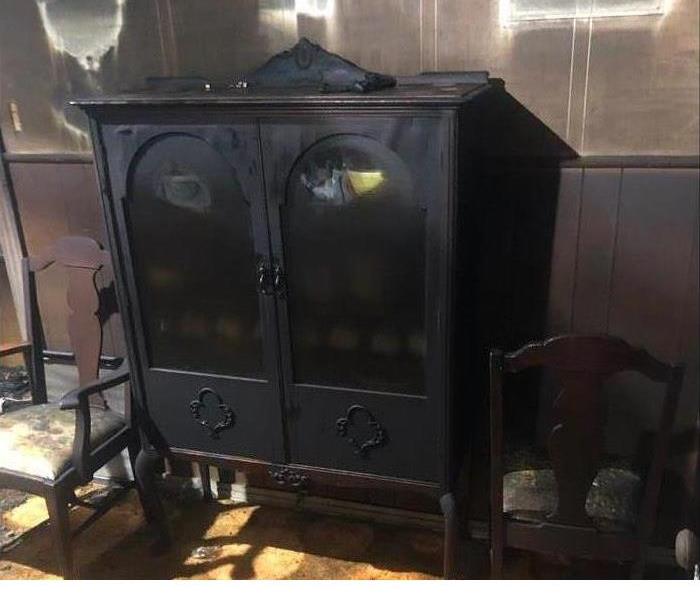 Smoke Damaged Furniture
Smoke Damaged Furniture
The first substantial step is calling a knowledgeable fire damage restoration expert to assess the damage and develop an action plan to restore your home. The quicker you act, the faster we can get your family back into and comfortable in your home.
SERVPRO of Carrollton is a preferred restoration company for many major insurance carriers meaning we have the experience and knowledge of working with your insurance company and adjusters. You have enough stress, let us offer our expertise and get you back into your home.
What does the Experience of SERVPRO of Carrollton mean for You and Include?
It means you will be treated with dignity, respect, and receive customer service above your expectations.
Our experience includes:
- Securing your home and any belongings that may still be salvageable.
- Repair and restore any portions of the home to the original condition.
- Keep you informed the entire process of what is upcoming
- Deodorizing and neutralizing the smoke and soot damage.
- Work with your insurance company to get your home back to its original condition.
Moreover, the following services are completed concerning your home and its mitigation and restoration:
- Complete Structure Repair & Rebuild
- Odor control and deodorization to remove all traces of smoke odor
- Board-Up Structure / Temporary Fencing / On-Site Security
- Debris Removal
- Structural Drying
- Soot, smoke and residue removal
- Dehumidification
- Carpentry / Structure repairs
- HVAC Cleaning and Decontamination
One call to SERVPRO of Carrollton can offer you the peace of mind that comes from knowing professionals are on the job and restoring your smoke damaged home to the home you once loved!
You can reach us by calling 972-446-0383 7 days a week, 24 hours a day, 365 days a year.
What To Expect During the Fire Cleanup Process
7/16/2019 (Permalink)
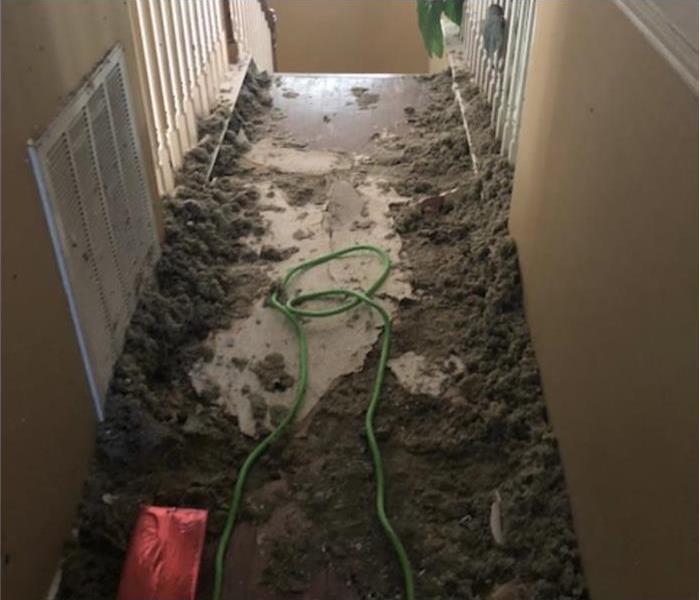 Fire damage in a Carrollton, TX home
Fire damage in a Carrollton, TX home
Steps to Restore Your Home Back to Pre- fire Condition
If you’ve experienced a home fire in Carrollton, TX, one of the first things you should do once the flames have been completely extinguished is to get in contact with a fire damage restoration company. These professionals can respond in an emergency situation and help rebuild and restore your home in the most efficient manner possible. After inspecting your home for smoke damage and ensuring it is safe to work in, the restoration specialists will begin the fire cleanup process. Here is some information on the steps that are taken to restore your damaged home back to its pre-fire condition.
1. Water Removal
It is very common for homes to experience extensive water damage after a home fire has occurred if a fire hose was used to extinguish the flames or if other issues occurred such as a pipe burst. If flooding or water damage is present when the restoration specialist enters your home, they will first focus on removing as much water as possible and completely drying all surfaces and belongings.
2. Smoke or Soot Cleanup
An essential part of the fire cleanup process is to address any smoke or soot damage that has occurred. Soot and smoke can corrode metal surfaces, deteriorate wood, and cause discoloration to walls. Through the use of special equipment and expert techniques, the restoration specialist can remove all soot and smoke damage from your home.
Sanitizing
The restoration specialist will need to clean all your items and purify the air before you can move back into your home. Smoke cleaning and odor removal will help remove any lingering smells from the house and make the air safe for you to breathe.
When you contact a fire damage restoration company after a house fire, addressing any water, soot, or smoke damage and completely sanitizing your home is all part of the fire cleanup process. Before you know it, they will be able to start the rebuilding process and make your house feel like home again.
How Fire Sprinklers Work During a Fire
6/28/2019 (Permalink)
 In the event of a fire, a reliable fire sprinkler system can save lives
In the event of a fire, a reliable fire sprinkler system can save lives
Here Are the Different Ways a Sprinkler Works to Extinguish a Fire
In the event of a fire, a reliable fire sprinkler system can save lives. Equipping your commercial building in Carrollton, TX, with sprinklers also significantly reduces property loss and damage. To protect all of your employees and keep your building safe, it’s crucial to have a fire suppression system installed and functioning properly. Here are the different ways a sprinkler works to extinguish a fire.
Detects Heat
While the presence of smoke sets off a smoke detector, sprinkler systems are mainly triggered by heat. As soon as a spark appears, the following takes place:
- Air surrounding fire heats up
- Heated air rises towards ceiling
- Sprinkler head senses heat and activates
Detecting heat is an essential feature of a fire sprinkler because it enables it to drown out the fire as soon as possible. Making sure your system is in good shape is necessary in order to be prepared for a real fire.
Douses the Flames
Once the sprinkler has sensed heat around it, it releases pressurized water. The water comes from a pipe system that connects to a water source outside the building. After heat causes the sprinkler to activate, a valve in the sprinkler head opens and water flows out. Because the water is pressurized, it is able to douse the fire completely and ensure that it is safely extinguished.
Keeps Water Confined to Area of Fire
When heat rises towards the ceiling, only the sprinkler head closest to the heat source activates while the other sprinklers stay sealed. This can prevent excessive water damage from harming your building. However, the water that flows from the one or two active sprinklers can still cause harm to your building, which is why it is vital to contact a professional and schedule a fire sprinkler cleanup immediately.
If your building in Carrollton, TX, has water damage as a result of fire sprinkler activation, don’t wait to call for help. A water damage repair specialist can help restore your business in no time.
For Fire Immediate Service in Carrollton, Call SERVPRO
5/29/2019 (Permalink)
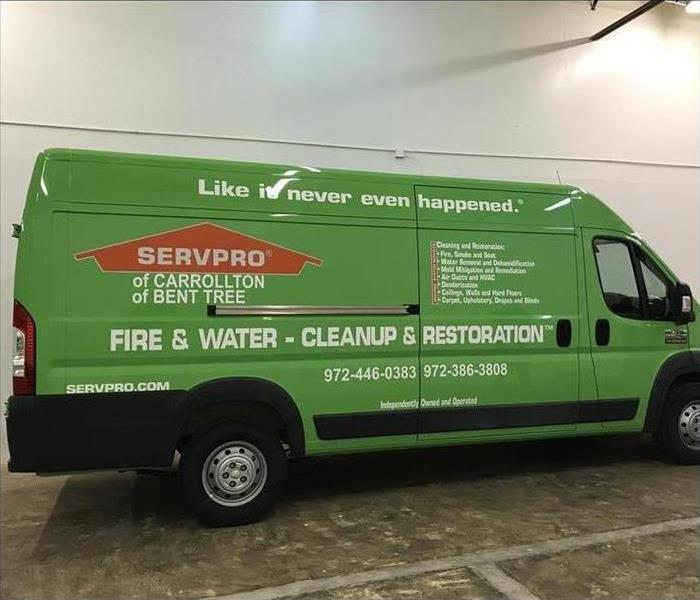 Carrollton Residents: We provide immediate service day or night!
Carrollton Residents: We provide immediate service day or night!
SERVPRO of Carrollton provides 24-hour emergency service and is dedicated to being faster to any-sized disaster in Carrollton, TX and surrounding areas. We can respond immediately to your emergency and have the expertise to handle your restoration or cleaning needs.
- 24-Hour Emergency Service
- Faster to Any-Sized Disaster
- Highly Trained Restoration Technicians
- A Trusted Leader in the Restoration Industry
- Locally Owned and Operated
- Advanced Restoration and Cleaning Equipment
Fire Damage Repair and Restoration
Residential Services
Whether your Carrollton home needs emergency fire damage or your upholstery cleaned, you can depend on us. Our technicians have extensive cleaning and restoration training and can make your property look its best. Learn more about our residential services:
- Water Damage Restoration
- Fire Damage Restoration
- Mold Remediation
- Storm Damage Restoration
- Cleaning Services
- Building/Reconstruction Services
Commercial Services
There's never a convenient time for commercial fire or Water damage to strike your Carrollton commercial property. Every hour spent cleaning up is an hour of lost revenue and productivity. So when the need arises for professional cleaning or emergency restoration services we have the training and expertise to respond promptly with highly trained technicians to get your property back to business. Learn more about our commercial services:
- Commercial Water Damage Restoration
- Commercial Fire Damage Restoration
Have Questions? Call Us 24/7 –(972) 446-0383
How a Fire Can Cause Water Damage to Your Home
5/15/2019 (Permalink)
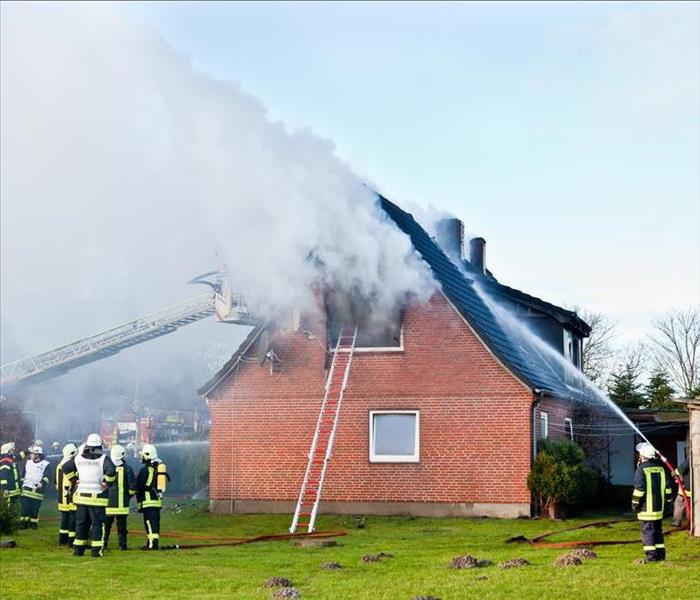 House fire in a Carrollton, TX home
House fire in a Carrollton, TX home
If your home in Carrollton, TX, has recently gone through a house fire, widespread fire and smoke damage is not the only troublesome outcome you will have to deal with. Firefighters rely on using an extremely large amount of water to extinguish the flames, which can result in problematic water damage to your home. Fortunately, immediately contacting a fire damage restoration company can help minimize the extent of the damage. Here is some general information on how water can damage your home after a fire and what a restoration company can do to help.
Common Necessary Damage Repairs
When a putting fire out in your home, firefighters use a fire hose, which releases a large amount of water at very high pressure. Once that amount of water enters your home, there is a wide range of damage that will need to be addressed:
- Damaged electronics, appliances, and other personal belongings
- Soaked or rotted wood
- Ceiling, drywall, and carpet damage
- Mold growth
- Damage to electrical components and wiring
The Fire Damage Restoration Process
As soon as you get in contact with a restoration company, they will assess how much damage has occurred to your home and develop a plan. A specialist will then provide a temporary structure to any compromised areas of your home by boarding up missing walls or windows and placing a tarp over any holes in your roof.
Next, the specialist will focus on drying water and removing smoke from your home. Once, this is complete, he or she will clean all salvageable structures and items. Finally, the representative will restore your home completely by repairing or rebuilding whatever needs to be fixed.
Although a house fire can be devastating to you and your family, a fire restoration company can help reverse the effects of water and fire damage on your home. Make sure to call as soon as you can so they can act quickly.
Don't Forget To Clean Odors and Soot After a Fire
2/4/2019 (Permalink)
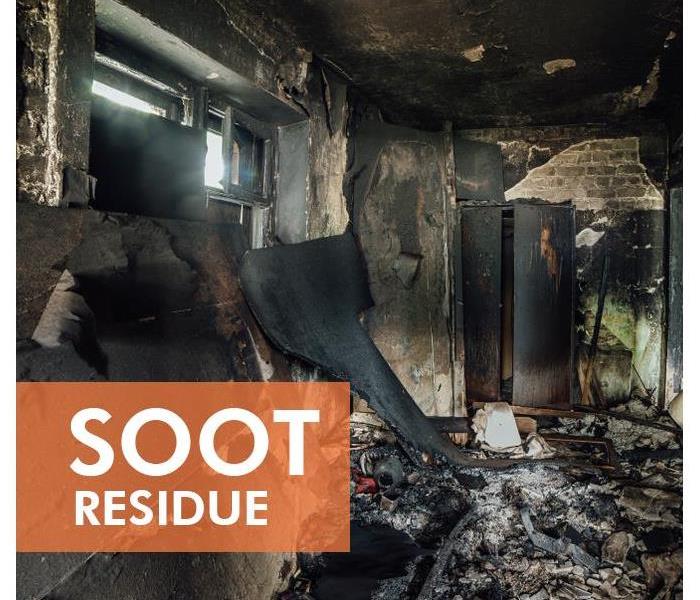 During a fire, soot residue is carried by rising and expanding air
During a fire, soot residue is carried by rising and expanding air
Don't Forget To Clean Odors and Soot After a Fire
The sight and smell of a crackling fire can be wonderful when you're under a blanket on a sofa. But you don't want that smell in your house in Carrollton, TX, especially not if it is a constant reminder of a fire that you just survived. Smoke damage, persistent smoke smells and soot damage, while less noticeable than burned walls and furniture, can be an ongoing source of trouble long after a fire has been put out if they are not remediated.
Making sure the smoke damage to your personal property and furniture, as well as to the structure of your home, is cleaned will go a long way to mitigate the odors. Places where smoke odors can linger range from the obvious to the less visible.
- Upholstered furniture like sofas, arm chairs and dining chairs
- Soft furnishings like throw pillows, blankets, seat cushions and drapes
- Throw rugs, area rugs and wall to wall carpeting
- Semi porous surfaces such as lamp shades and air filters
- Interior walls and built-in cabinets and seating
Soot develops when materials burn and the resulting particulate matter spreads out. It accumulates on visible surfaces like countertops and tables, and it can also find its way into hidden spaces. Make sure to check for soot damage on cabinet and pantry shelves, on and inside books and magazines, on appliance surfaces and inside closets. Soot can also make its way inside electronics such as TVs and computers where it can cause damage. It must be completely removed to stop it from being spread back into clean areas on the soles of shoes or via hands that have handled sooty items.
House fires burn structures and destroy personal property, and surviving them in Carrollton, TX is hard enough. Make sure that smoke damage is addressed when the fire damage is repaired so that you don't have to live with dirt and odor reminders of the disaster.
Content Cleaning: How To Salvage Smoke Damaged Materials
12/26/2018 (Permalink)
 Fire cleaning in a Carrollton, TX home
Fire cleaning in a Carrollton, TX home
How To Salvage Smoke Damaged Materials
A fire can result in significant material loss. While dry-cleaning and other professional services may be your best option for salvaging smoke damaged materials, they inevitably cost money, so why not try a DIY approach first.
1. Assess Salvageability
Before attempting any content cleaning, it is essential to figure out what is salvageable. The truth is that fire and smoke do significant damage, some of which is irreversible. If clothing is scorched or the material is marred, it is better to replace the item. However, you can and likely should consult with a professional before discarding anything of significance.
2. Vacuum or Shake Off Excess Soot
Before washing, you should vacuum or shake off excess soot. Do not scrub the items or attempt to use an upright vacuum or a brush attachment, as these items will only grind the residue deeper into the fabric or material. Instead, use a nozzle attachment and, hovering slightly above the surface, slowly vacuum away loose soot.
3. Deodorize and Wash
Once all loose soot is removed, you can begin the deodorizing process. While you can soak many household fabrics, like curtains and furniture covers, in a tub of warm water and dishwashing detergent overnight, some materials may require specialized services, like dry-cleaning and carpet cleaning. Additionally, items that can be machine washed may need multiple washings to remove any standing odors entirely.
4. Seek Professional Assistance
There are instances where you may need the assistance of a professional to remove odors and smoke damage. A Fire remediation specialist in the Carrollton, TX, area can assist you in facilitating the assistance of cleaning services that specialize in smoke and fire damage. Additionally, they may even be able to help you in finding appropriate content storage as your home is repaired.
While it may seem like an easy task to clean smoke damaged materials, there is a process. Unfortunately, for many DIYers, part of that process often includes the use of professional cleaning services, like dry-cleaning. However, if you are so inclined, you can try to vacuum away loose soot, deodorize the materials and wash everything several times to salvage your smoke damaged materials.
Fire Alarms: The 3 Most Common Causes of False Alarms in Smoke Detectors
10/24/2018 (Permalink)
 Replace the batteries of your smoke alarm at least once per year
Replace the batteries of your smoke alarm at least once per year
While a fire alarm is a terrifying noise, not all alarms require the Carrollton, TX, Fire Department or the recovery assistance of a fire restoration company. Some alarms, especially from smoke detectors, are false, but what causes these essential contraptions to produce a false alarm? Keep reading to find out.
1. Malfunction/False Alarm
Sometimes the only explanation of a false alarm is a malfunction. A smoke alarm is a piece of machinery, and as such, it is prone to some unexplainable quirks from time to time. That being said, every smoke detector that is labeled with the UL logo is rigorously tested for effectiveness and performance.
2. Low or Dying Batteries
Likely the most common cause of a false fire alarm is low or dying batteries. The recommendation is that you replace your smoke alarm batteries at least once per year, but because they are inconspicuous and rarely used, smoke detectors are easy to forget. It may be helpful to write a reminder on your calendar or set up an alarm on your phone to remind you to replace the batteries.
3. Dust and Smoke Damage
Oddly enough smoke and fire damage can cause a false alarm, as well as dust buildup. If a smoke detector has been exposed to fire and smoke before, the remnants of that damage can interfere with the detection process and trigger an alarm. Additionally, if dust builds up in the housing of the alarm blocking either the ionization or the photoelectric pulse, then it too can trigger a false alarm.
4. Accidental Test
Also, the accidental pressing of the test button can trigger a false alarm. Whether you were dusting around the smoke alarm, replacing the batteries, or trying to put the housing cover back on, the test button can easily set off a false alarm.
A false fire alarm may be one of the biggest frustrations a homeowner can experience. However, while false alarms may be a nuisance, there are several explanations for why they occur, and despite the irritation, you still can agree that a false alarm is better than no alarm at all.
How To Choose a Smoke Detector For Your Home
8/2/2018 (Permalink)
With well-chosen devices and regular maintenance, The National Fire Protection Association claims the presence of a smoke detector can double your chances of surviving a house fire. Taking special care in selecting the devices that will protect your home is crucial for giving you the time you need should that smoke alarm go off.
Consider the Size of Your Home.
Unless your Carrollton, TX, home could be considered a hallmark of the tiny house movement, you’re probably going to need more than one smoke alarm. The NFPA recommends a smoke detector be installed in multiple locations:
• On every level, including basement and attic
• In every hallway that leads to a sleeping area
• Within every bedroom
• At either end of a stairway
With a minimum of three detectors necessary for a two-bedroom home, it is important to consider the variety of options available for fire safety.
Choose Your Preference.
What smoke alarm you choose largely depends on your personal preference, but it is important to know the pros and cons of each option:
• Ionization alarms create an electric current within the smoke detector by ionizing the air with minimal amounts of the radioactive element americium 241. If smoke particles enter the chamber, the current will be disrupted and trigger the alarm. They are highly susceptible to flaming fires, such as from paper or grease.
• Photoelectric alarms incorporate a small strobe light which when diffracted by smoke particles, will trigger a sensor that sounds the alarm. Smoldering fires, often started in bedding or clothing, are better detected by this device.
• Combination devices will have a dual-sensor to incorporate both ionization and photoelectric components. The NFPA recommends having a mix of both styles of smoke alarms within your home, making this a single choice for cohesive protection.
Other considerations to include: power source, a convenient way to regularly test, ease of maintenance and other personal needs such as visual assistance or carbon monoxide testing.
For more information, please visit us at http://www.SERVPROcarrolltontx.com/.
Do not DIY a Fire Damaged Property
6/21/2018 (Permalink)
After a fire in the home, it's also important to have the fire cleanup estimated. An insurance adjuster will visit the property to see exactly the extent of what needs to be replaced after the fire damage, and what financial effects the fire loss will have on the property. At a minimum, the policy should be able to cover the smoke damage, soot damage and any other damage needed to get the house back to reasonable condition.
The fire damage in a home may seem like a job that can be handled by the owner. This is not advised, as most people don't have the tools or knowledge to handle such a job. Water damage from fighting the fire also adds to the risk. Items in the fire loss can be water logged and much heavier. After a fire in the home, it's normal to want to tackle the problem and handle the fire cleanup.
Employees Shouldn't Work until After Mitigation
6/21/2018 (Permalink)
Commercial fire damage and fire loss must be repaired in the same manner as the fire in home damage, but it is repaired with the techniques used for fire in business damages. The soot damage and smoke damage has more places to go, and it will cause more problems because it will contaminate a much larger area. The fire cleanup crew will continue to check for soot and damage, and they will do many checks to be sure the smoke smell is gone.
Fire damage in a facility must be addressed before the employees may begin working again. Fire in home and fire in business damage must be removed by a commercial fire damage company as soon as they see all soot damage and smoke damage. There are many things that will make the fire cleanup process harder, and the air quality will begin to improve for everyone involved.
SERVPRO of Carrollton will have most of the damage cleaned up so employees can return to work quickly.
Carrollton Smoke and Soot Cleanup
6/17/2018 (Permalink)
Smoke and soot is very invasive and can penetrate various cavities within your home, causing hidden damage and odor. Our smoke damage expertise and experience allows us to inspect and accurately assess the extent of the damage to develop a comprehensive plan of action.
Smoke and soot facts:
Hot smoke migrates to cooler areas and upper levels of a structure.
Smoke flows around plumbing systems, seeping through the holes used by pipes to go from floor to floor.
The type of smoke may greatly affect the restoration process.
Different Types of Smoke
There are two different types of smoke–wet and dry. As a result, there are different types of soot residue after a fire. Before restoration begins, SERVPRO of Carrollton will test the soot to determine which type of smoke damage occurred. The cleaning procedures will then be based on the information identified during pretesting. Here is some additional information:
Wet Smoke – Plastic and Rubber
Low heat, smoldering, pungent odor, sticky, smeary. Smoke webs are more difficult to clean.
Dry Smoke – Paper and Wood
Fast burning, high temperatures, heat rises therefore smoke rises.
Protein Fire Residue – Produced by evaporation of material rather than from a fire
Virtually invisible, discolors paints and varnishes, extreme pungent odor.
Our Fire Damage Restoration Services
Since each smoke and fire damage situation is a little different, each one requires a unique solution tailored for the specific conditions. We have the equipment, expertise, and experience to restore your fire and smoke damage. We will also treat your family with empathy and respect and your property with care.
Have Questions about Fire, Smoke, or Soot Damage
Call us Today at (972) 446-0383
How Often Should You Clean a Dryer Vent?
5/9/2018 (Permalink)
How Often Should You Clean a Dryer Vent?
A home clothes dryer that is not regularly cleaned and maintained can cause a fire and result in extensive property damage. Approximately 2,900 clothes dryer fires are reported each year in the United States, and a dryer fire poses a similar risk of severe injuries as any kind of residential fire. The primary cause of home dryer fires is failure to clean lint filters and vent pipes. The best way to prevent a lint fire is to gather and dispose of the lint that collects while drying laundry on a regular basis. Here are a few guidelines on how often to clean dryer filters and vents.
• After every load, you should clean out the lint filter of your dryer.
• A few times a month, you should check the back of the dryer to make sure that lint is not building up.
• Every three months, you should clean lint out of the vent pipe connected to your dryer. Use a snake tool to get lint that has collected further into the pipe than you can reach. Removing excess lint from in and around your dryer is essential for preventing a lint fire.
• Every six months, you should clean the lint filter in your dryer with a nylon brush, or clean the filter more frequently as it becomes clogged.
• Whenever necessary, you should have your dryer cleaned by professionals, particular if the appliance has become less efficient and it takes longer to dry clothes.
Dryer fires are more likely to occur during the fall and winter months, with the month of January seeing the most dryer fires. If you experience a dryer fire, you should call firefighters to make sure that the blaze is extinguished. You may also want to contact a residential damage restoration service Carrollton, TX to repair damage to the area surrounding your laundry machines after a lint fire
For more information, please visit us at http://www.SERVPROcarrolltontx.com/.
Our Highly Trained Restoration Specialists can restore your Carrollton Home
12/14/2017 (Permalink)
SERVPRO of Carrollton and Bent Tree has staff that are IICRC certified. The Institute of Inspection, Cleaning and Restoration Certification (IICRC) creates the standards for the restoration industry and provides training and certification to restoration companies and employees.
The IICRC Develops The Standards For The Restoration Industry
The IICRC has been the driving force in establishing the main industry standards and reference guides for professional carpet cleaning, water damage restoration, fire restoration and mold remediation. These IICRC standards take years to develop and require the coordination of experts in the field: manufacturers, industry organizations, insurance professionals, training schools, contractors, and public health professionals.
Every five years, the standards are reviewed and updated. The water damage restoration field changes rapidly with advancements in technology and science, and therefore the standards must evolve to keep pace.
About SERVPRO of Carrollton and Bent Tree-
SERVPRO of Carrollton and Bent Tree specializes in the cleanup and restoration of residential and commercial property after a fire, smoke or water damage event. Our staff is highly trained in property damage restoration and has certified IICRC employees. We believe in continuous training: from initial and ongoing training at SERVPRO’s corporate training facility to regular IICRC-industry certification, rest assured our staff is equipped with the knowledge to restore your property.





 24/7 Emergency Service
24/7 Emergency Service
